The Impact of Diet and Lifestyle on Gut Microbiota and Human Health
VerifiedAdded on 2023/06/07
|28
|18639
|305
AI Summary
This review explores the impact of diet and lifestyle on gut microbiota and human health. It discusses the role of diet in shaping gut microbial populations and the use of prebiotics and probiotics to modify microbial populations. The article also highlights the influence of lifestage and lifestyle factors, such as smoking, exercise, and stress, on gut microbiota.
Contribute Materials
Your contribution can guide someone’s learning journey. Share your
documents today.
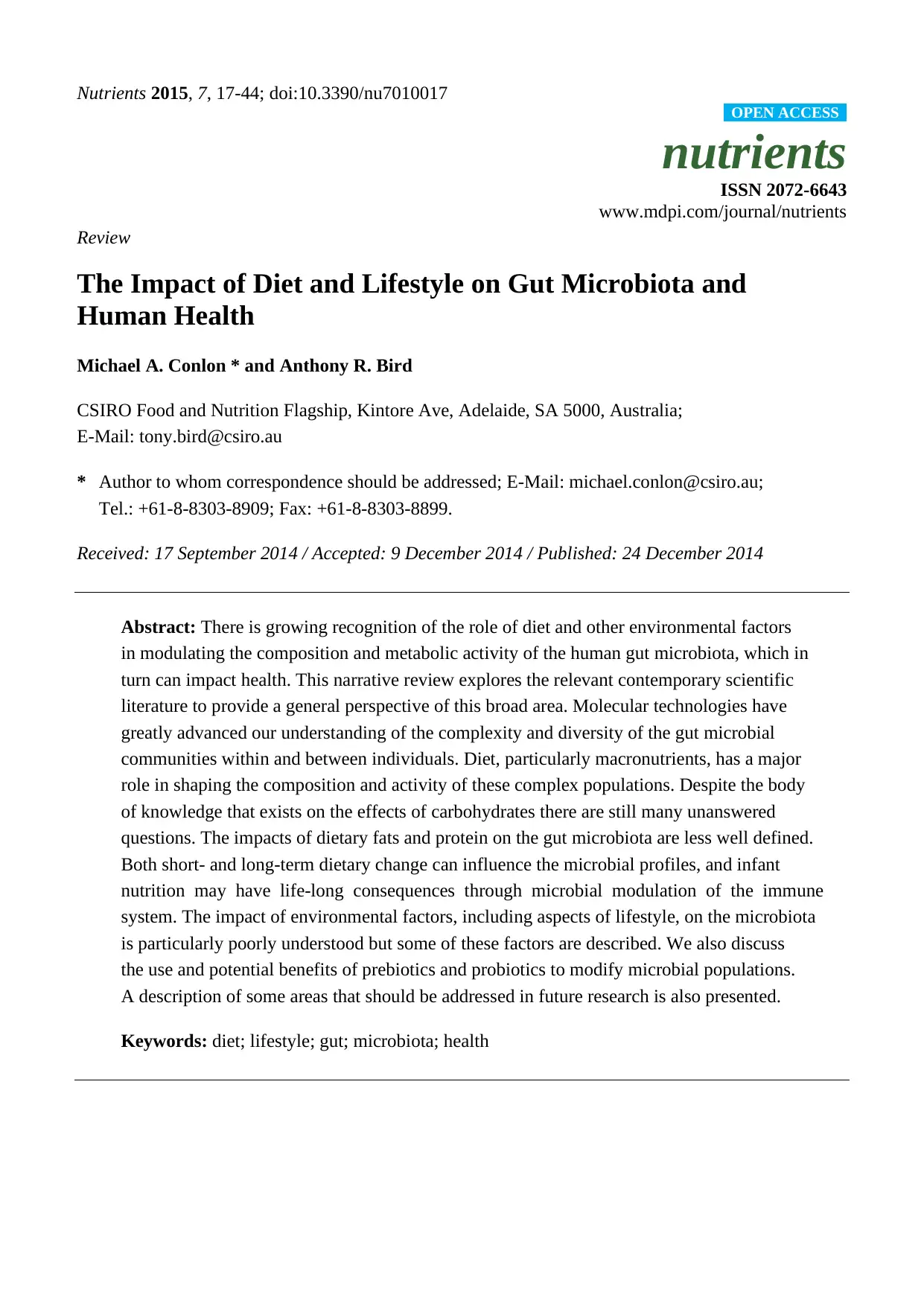
Nutrients 2015, 7, 17-44; doi:10.3390/nu7010017
nutrients
ISSN 2072-6643
www.mdpi.com/journal/nutrients
Review
The Impact of Diet and Lifestyle on Gut Microbiota and
Human Health
Michael A. Conlon * and Anthony R. Bird
CSIRO Food and Nutrition Flagship, Kintore Ave, Adelaide, SA 5000, Australia;
E-Mail: tony.bird@csiro.au
* Author to whom correspondence should be addressed; E-Mail: michael.conlon@csiro.au;
Tel.: +61-8-8303-8909; Fax: +61-8-8303-8899.
Received: 17 September 2014 / Accepted: 9 December 2014 / Published: 24 December 2014
Abstract: There is growing recognition of the role of diet and other environmental factors
in modulating the composition and metabolic activity of the human gut microbiota, which in
turn can impact health. This narrative review explores the relevant contemporary scientific
literature to provide a general perspective of this broad area. Molecular technologies have
greatly advanced our understanding of the complexity and diversity of the gut microbial
communities within and between individuals. Diet, particularly macronutrients, has a major
role in shaping the composition and activity of these complex populations. Despite the body
of knowledge that exists on the effects of carbohydrates there are still many unanswered
questions. The impacts of dietary fats and protein on the gut microbiota are less well defined.
Both short- and long-term dietary change can influence the microbial profiles, and infant
nutrition may have life-long consequences through microbial modulation of the immune
system. The impact of environmental factors, including aspects of lifestyle, on the microbiota
is particularly poorly understood but some of these factors are described. We also discuss
the use and potential benefits of prebiotics and probiotics to modify microbial populations.
A description of some areas that should be addressed in future research is also presented.
Keywords: diet; lifestyle; gut; microbiota; health
OPEN ACCESS
nutrients
ISSN 2072-6643
www.mdpi.com/journal/nutrients
Review
The Impact of Diet and Lifestyle on Gut Microbiota and
Human Health
Michael A. Conlon * and Anthony R. Bird
CSIRO Food and Nutrition Flagship, Kintore Ave, Adelaide, SA 5000, Australia;
E-Mail: tony.bird@csiro.au
* Author to whom correspondence should be addressed; E-Mail: michael.conlon@csiro.au;
Tel.: +61-8-8303-8909; Fax: +61-8-8303-8899.
Received: 17 September 2014 / Accepted: 9 December 2014 / Published: 24 December 2014
Abstract: There is growing recognition of the role of diet and other environmental factors
in modulating the composition and metabolic activity of the human gut microbiota, which in
turn can impact health. This narrative review explores the relevant contemporary scientific
literature to provide a general perspective of this broad area. Molecular technologies have
greatly advanced our understanding of the complexity and diversity of the gut microbial
communities within and between individuals. Diet, particularly macronutrients, has a major
role in shaping the composition and activity of these complex populations. Despite the body
of knowledge that exists on the effects of carbohydrates there are still many unanswered
questions. The impacts of dietary fats and protein on the gut microbiota are less well defined.
Both short- and long-term dietary change can influence the microbial profiles, and infant
nutrition may have life-long consequences through microbial modulation of the immune
system. The impact of environmental factors, including aspects of lifestyle, on the microbiota
is particularly poorly understood but some of these factors are described. We also discuss
the use and potential benefits of prebiotics and probiotics to modify microbial populations.
A description of some areas that should be addressed in future research is also presented.
Keywords: diet; lifestyle; gut; microbiota; health
OPEN ACCESS
Secure Best Marks with AI Grader
Need help grading? Try our AI Grader for instant feedback on your assignments.
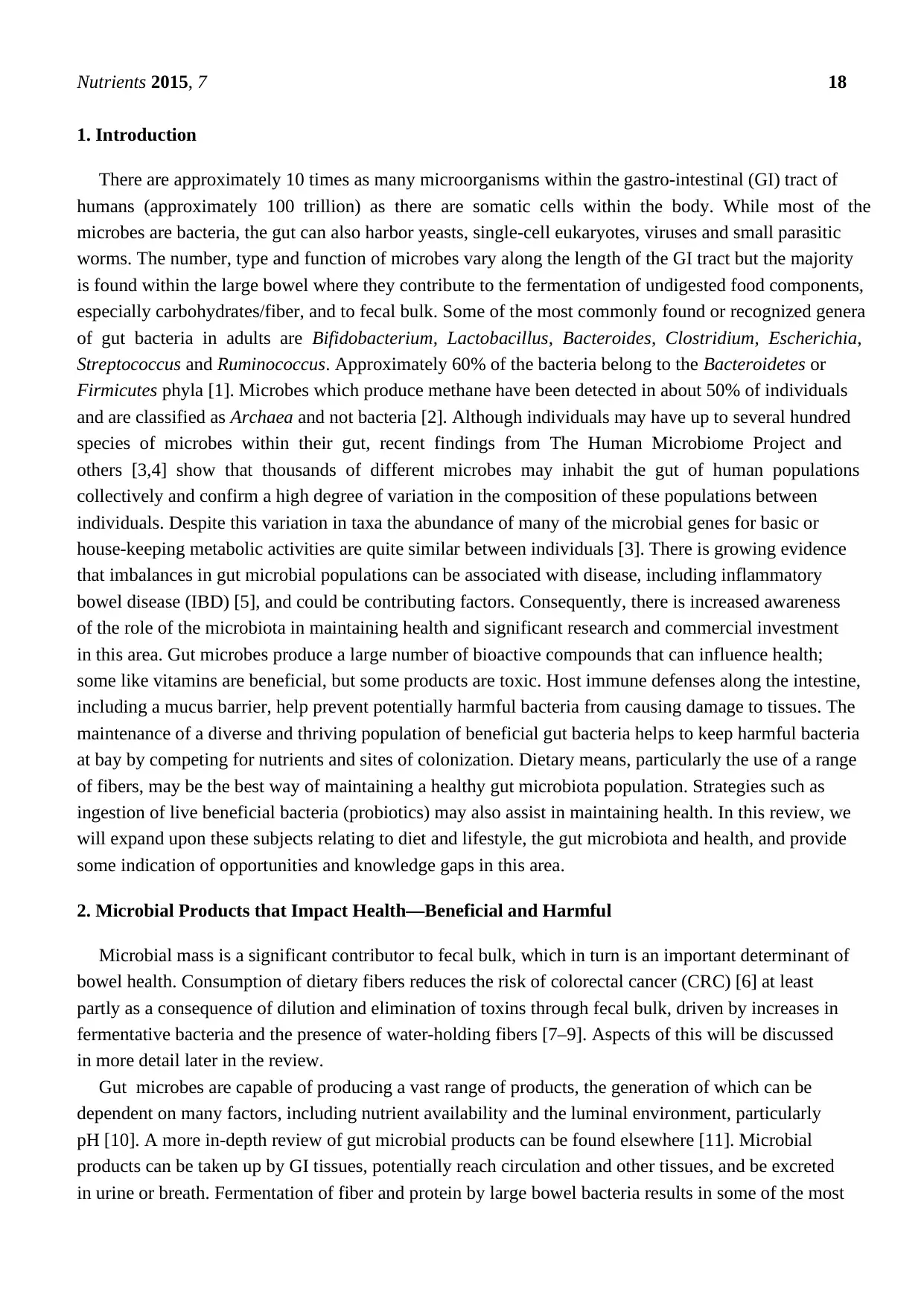
Nutrients 2015, 7 18
1. Introduction
There are approximately 10 times as many microorganisms within the gastro-intestinal (GI) tract of
humans (approximately 100 trillion) as there are somatic cells within the body. While most of the
microbes are bacteria, the gut can also harbor yeasts, single-cell eukaryotes, viruses and small parasitic
worms. The number, type and function of microbes vary along the length of the GI tract but the majority
is found within the large bowel where they contribute to the fermentation of undigested food components,
especially carbohydrates/fiber, and to fecal bulk. Some of the most commonly found or recognized genera
of gut bacteria in adults are Bifidobacterium, Lactobacillus, Bacteroides, Clostridium, Escherichia,
Streptococcus and Ruminococcus. Approximately 60% of the bacteria belong to the Bacteroidetes or
Firmicutes phyla [1]. Microbes which produce methane have been detected in about 50% of individuals
and are classified as Archaea and not bacteria [2]. Although individuals may have up to several hundred
species of microbes within their gut, recent findings from The Human Microbiome Project and
others [3,4] show that thousands of different microbes may inhabit the gut of human populations
collectively and confirm a high degree of variation in the composition of these populations between
individuals. Despite this variation in taxa the abundance of many of the microbial genes for basic or
house-keeping metabolic activities are quite similar between individuals [3]. There is growing evidence
that imbalances in gut microbial populations can be associated with disease, including inflammatory
bowel disease (IBD) [5], and could be contributing factors. Consequently, there is increased awareness
of the role of the microbiota in maintaining health and significant research and commercial investment
in this area. Gut microbes produce a large number of bioactive compounds that can influence health;
some like vitamins are beneficial, but some products are toxic. Host immune defenses along the intestine,
including a mucus barrier, help prevent potentially harmful bacteria from causing damage to tissues. The
maintenance of a diverse and thriving population of beneficial gut bacteria helps to keep harmful bacteria
at bay by competing for nutrients and sites of colonization. Dietary means, particularly the use of a range
of fibers, may be the best way of maintaining a healthy gut microbiota population. Strategies such as
ingestion of live beneficial bacteria (probiotics) may also assist in maintaining health. In this review, we
will expand upon these subjects relating to diet and lifestyle, the gut microbiota and health, and provide
some indication of opportunities and knowledge gaps in this area.
2. Microbial Products that Impact Health—Beneficial and Harmful
Microbial mass is a significant contributor to fecal bulk, which in turn is an important determinant of
bowel health. Consumption of dietary fibers reduces the risk of colorectal cancer (CRC) [6] at least
partly as a consequence of dilution and elimination of toxins through fecal bulk, driven by increases in
fermentative bacteria and the presence of water-holding fibers [7–9]. Aspects of this will be discussed
in more detail later in the review.
Gut microbes are capable of producing a vast range of products, the generation of which can be
dependent on many factors, including nutrient availability and the luminal environment, particularly
pH [10]. A more in-depth review of gut microbial products can be found elsewhere [11]. Microbial
products can be taken up by GI tissues, potentially reach circulation and other tissues, and be excreted
in urine or breath. Fermentation of fiber and protein by large bowel bacteria results in some of the most
1. Introduction
There are approximately 10 times as many microorganisms within the gastro-intestinal (GI) tract of
humans (approximately 100 trillion) as there are somatic cells within the body. While most of the
microbes are bacteria, the gut can also harbor yeasts, single-cell eukaryotes, viruses and small parasitic
worms. The number, type and function of microbes vary along the length of the GI tract but the majority
is found within the large bowel where they contribute to the fermentation of undigested food components,
especially carbohydrates/fiber, and to fecal bulk. Some of the most commonly found or recognized genera
of gut bacteria in adults are Bifidobacterium, Lactobacillus, Bacteroides, Clostridium, Escherichia,
Streptococcus and Ruminococcus. Approximately 60% of the bacteria belong to the Bacteroidetes or
Firmicutes phyla [1]. Microbes which produce methane have been detected in about 50% of individuals
and are classified as Archaea and not bacteria [2]. Although individuals may have up to several hundred
species of microbes within their gut, recent findings from The Human Microbiome Project and
others [3,4] show that thousands of different microbes may inhabit the gut of human populations
collectively and confirm a high degree of variation in the composition of these populations between
individuals. Despite this variation in taxa the abundance of many of the microbial genes for basic or
house-keeping metabolic activities are quite similar between individuals [3]. There is growing evidence
that imbalances in gut microbial populations can be associated with disease, including inflammatory
bowel disease (IBD) [5], and could be contributing factors. Consequently, there is increased awareness
of the role of the microbiota in maintaining health and significant research and commercial investment
in this area. Gut microbes produce a large number of bioactive compounds that can influence health;
some like vitamins are beneficial, but some products are toxic. Host immune defenses along the intestine,
including a mucus barrier, help prevent potentially harmful bacteria from causing damage to tissues. The
maintenance of a diverse and thriving population of beneficial gut bacteria helps to keep harmful bacteria
at bay by competing for nutrients and sites of colonization. Dietary means, particularly the use of a range
of fibers, may be the best way of maintaining a healthy gut microbiota population. Strategies such as
ingestion of live beneficial bacteria (probiotics) may also assist in maintaining health. In this review, we
will expand upon these subjects relating to diet and lifestyle, the gut microbiota and health, and provide
some indication of opportunities and knowledge gaps in this area.
2. Microbial Products that Impact Health—Beneficial and Harmful
Microbial mass is a significant contributor to fecal bulk, which in turn is an important determinant of
bowel health. Consumption of dietary fibers reduces the risk of colorectal cancer (CRC) [6] at least
partly as a consequence of dilution and elimination of toxins through fecal bulk, driven by increases in
fermentative bacteria and the presence of water-holding fibers [7–9]. Aspects of this will be discussed
in more detail later in the review.
Gut microbes are capable of producing a vast range of products, the generation of which can be
dependent on many factors, including nutrient availability and the luminal environment, particularly
pH [10]. A more in-depth review of gut microbial products can be found elsewhere [11]. Microbial
products can be taken up by GI tissues, potentially reach circulation and other tissues, and be excreted
in urine or breath. Fermentation of fiber and protein by large bowel bacteria results in some of the most
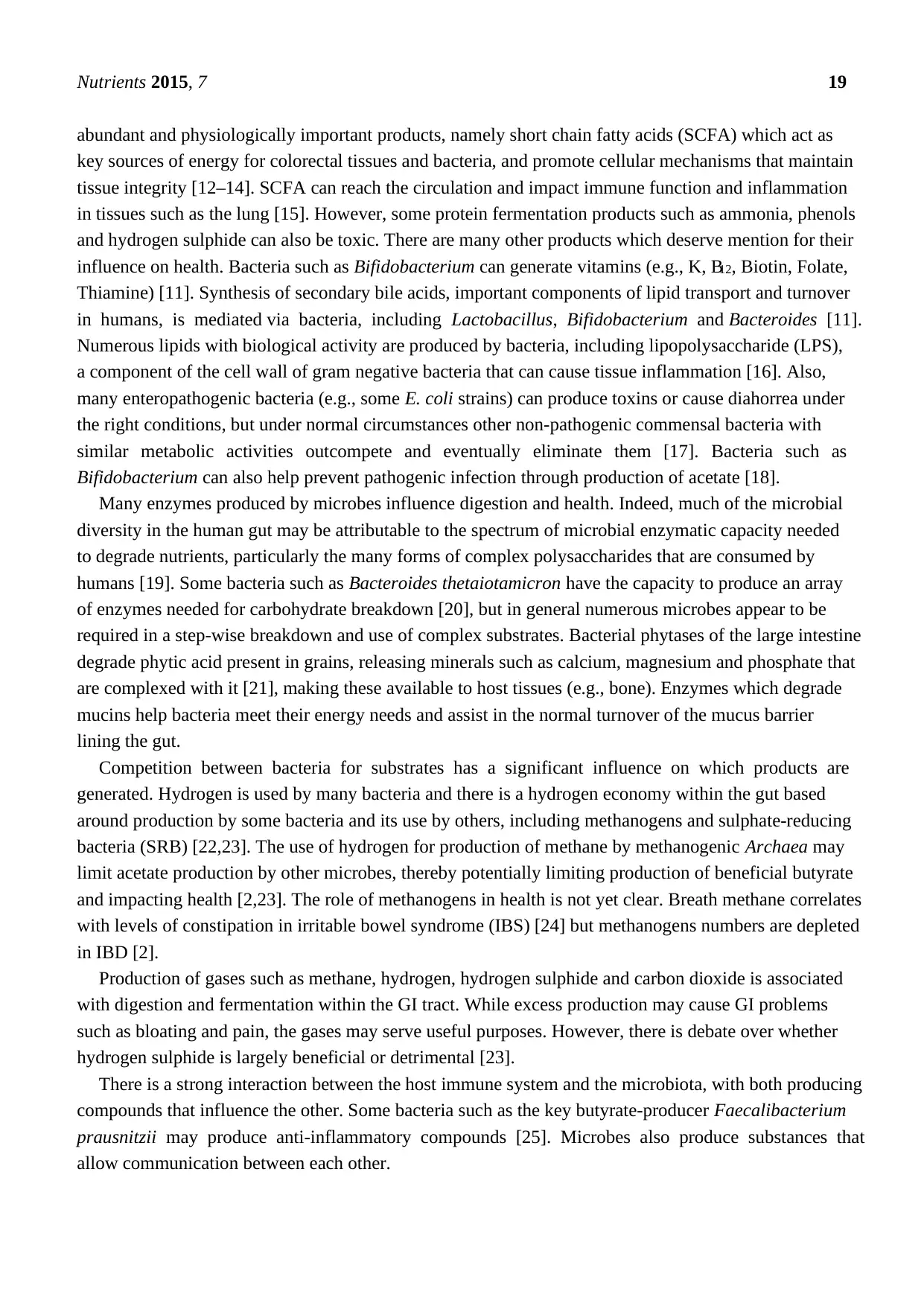
Nutrients 2015, 7 19
abundant and physiologically important products, namely short chain fatty acids (SCFA) which act as
key sources of energy for colorectal tissues and bacteria, and promote cellular mechanisms that maintain
tissue integrity [12–14]. SCFA can reach the circulation and impact immune function and inflammation
in tissues such as the lung [15]. However, some protein fermentation products such as ammonia, phenols
and hydrogen sulphide can also be toxic. There are many other products which deserve mention for their
influence on health. Bacteria such as Bifidobacterium can generate vitamins (e.g., K, B12, Biotin, Folate,
Thiamine) [11]. Synthesis of secondary bile acids, important components of lipid transport and turnover
in humans, is mediated via bacteria, including Lactobacillus, Bifidobacterium and Bacteroides [11].
Numerous lipids with biological activity are produced by bacteria, including lipopolysaccharide (LPS),
a component of the cell wall of gram negative bacteria that can cause tissue inflammation [16]. Also,
many enteropathogenic bacteria (e.g., some E. coli strains) can produce toxins or cause diahorrea under
the right conditions, but under normal circumstances other non-pathogenic commensal bacteria with
similar metabolic activities outcompete and eventually eliminate them [17]. Bacteria such as
Bifidobacterium can also help prevent pathogenic infection through production of acetate [18].
Many enzymes produced by microbes influence digestion and health. Indeed, much of the microbial
diversity in the human gut may be attributable to the spectrum of microbial enzymatic capacity needed
to degrade nutrients, particularly the many forms of complex polysaccharides that are consumed by
humans [19]. Some bacteria such as Bacteroides thetaiotamicron have the capacity to produce an array
of enzymes needed for carbohydrate breakdown [20], but in general numerous microbes appear to be
required in a step-wise breakdown and use of complex substrates. Bacterial phytases of the large intestine
degrade phytic acid present in grains, releasing minerals such as calcium, magnesium and phosphate that
are complexed with it [21], making these available to host tissues (e.g., bone). Enzymes which degrade
mucins help bacteria meet their energy needs and assist in the normal turnover of the mucus barrier
lining the gut.
Competition between bacteria for substrates has a significant influence on which products are
generated. Hydrogen is used by many bacteria and there is a hydrogen economy within the gut based
around production by some bacteria and its use by others, including methanogens and sulphate-reducing
bacteria (SRB) [22,23]. The use of hydrogen for production of methane by methanogenic Archaea may
limit acetate production by other microbes, thereby potentially limiting production of beneficial butyrate
and impacting health [2,23]. The role of methanogens in health is not yet clear. Breath methane correlates
with levels of constipation in irritable bowel syndrome (IBS) [24] but methanogens numbers are depleted
in IBD [2].
Production of gases such as methane, hydrogen, hydrogen sulphide and carbon dioxide is associated
with digestion and fermentation within the GI tract. While excess production may cause GI problems
such as bloating and pain, the gases may serve useful purposes. However, there is debate over whether
hydrogen sulphide is largely beneficial or detrimental [23].
There is a strong interaction between the host immune system and the microbiota, with both producing
compounds that influence the other. Some bacteria such as the key butyrate-producer Faecalibacterium
prausnitzii may produce anti-inflammatory compounds [25]. Microbes also produce substances that
allow communication between each other.
abundant and physiologically important products, namely short chain fatty acids (SCFA) which act as
key sources of energy for colorectal tissues and bacteria, and promote cellular mechanisms that maintain
tissue integrity [12–14]. SCFA can reach the circulation and impact immune function and inflammation
in tissues such as the lung [15]. However, some protein fermentation products such as ammonia, phenols
and hydrogen sulphide can also be toxic. There are many other products which deserve mention for their
influence on health. Bacteria such as Bifidobacterium can generate vitamins (e.g., K, B12, Biotin, Folate,
Thiamine) [11]. Synthesis of secondary bile acids, important components of lipid transport and turnover
in humans, is mediated via bacteria, including Lactobacillus, Bifidobacterium and Bacteroides [11].
Numerous lipids with biological activity are produced by bacteria, including lipopolysaccharide (LPS),
a component of the cell wall of gram negative bacteria that can cause tissue inflammation [16]. Also,
many enteropathogenic bacteria (e.g., some E. coli strains) can produce toxins or cause diahorrea under
the right conditions, but under normal circumstances other non-pathogenic commensal bacteria with
similar metabolic activities outcompete and eventually eliminate them [17]. Bacteria such as
Bifidobacterium can also help prevent pathogenic infection through production of acetate [18].
Many enzymes produced by microbes influence digestion and health. Indeed, much of the microbial
diversity in the human gut may be attributable to the spectrum of microbial enzymatic capacity needed
to degrade nutrients, particularly the many forms of complex polysaccharides that are consumed by
humans [19]. Some bacteria such as Bacteroides thetaiotamicron have the capacity to produce an array
of enzymes needed for carbohydrate breakdown [20], but in general numerous microbes appear to be
required in a step-wise breakdown and use of complex substrates. Bacterial phytases of the large intestine
degrade phytic acid present in grains, releasing minerals such as calcium, magnesium and phosphate that
are complexed with it [21], making these available to host tissues (e.g., bone). Enzymes which degrade
mucins help bacteria meet their energy needs and assist in the normal turnover of the mucus barrier
lining the gut.
Competition between bacteria for substrates has a significant influence on which products are
generated. Hydrogen is used by many bacteria and there is a hydrogen economy within the gut based
around production by some bacteria and its use by others, including methanogens and sulphate-reducing
bacteria (SRB) [22,23]. The use of hydrogen for production of methane by methanogenic Archaea may
limit acetate production by other microbes, thereby potentially limiting production of beneficial butyrate
and impacting health [2,23]. The role of methanogens in health is not yet clear. Breath methane correlates
with levels of constipation in irritable bowel syndrome (IBS) [24] but methanogens numbers are depleted
in IBD [2].
Production of gases such as methane, hydrogen, hydrogen sulphide and carbon dioxide is associated
with digestion and fermentation within the GI tract. While excess production may cause GI problems
such as bloating and pain, the gases may serve useful purposes. However, there is debate over whether
hydrogen sulphide is largely beneficial or detrimental [23].
There is a strong interaction between the host immune system and the microbiota, with both producing
compounds that influence the other. Some bacteria such as the key butyrate-producer Faecalibacterium
prausnitzii may produce anti-inflammatory compounds [25]. Microbes also produce substances that
allow communication between each other.
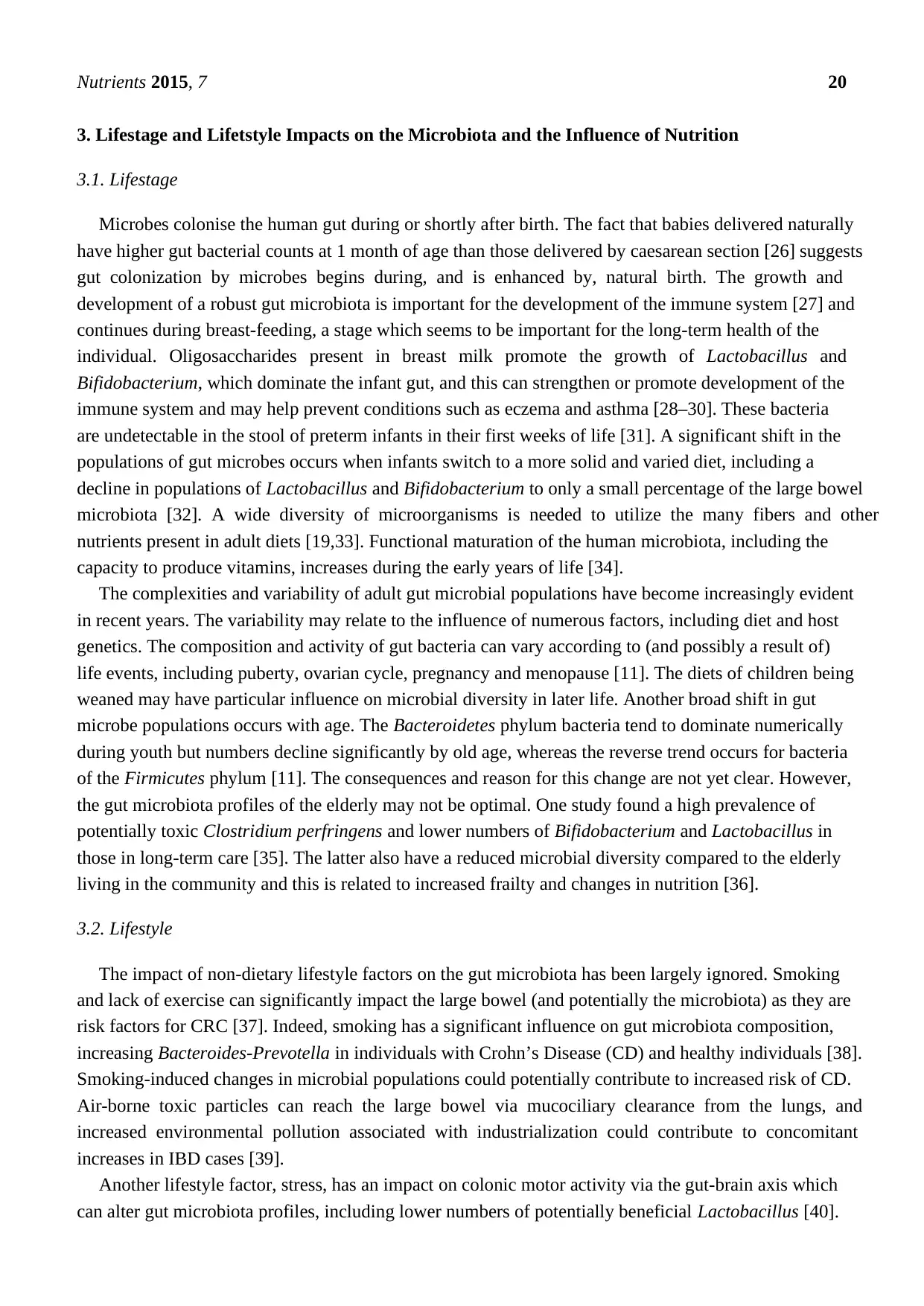
Nutrients 2015, 7 20
3. Lifestage and Lifetstyle Impacts on the Microbiota and the Influence of Nutrition
3.1. Lifestage
Microbes colonise the human gut during or shortly after birth. The fact that babies delivered naturally
have higher gut bacterial counts at 1 month of age than those delivered by caesarean section [26] suggests
gut colonization by microbes begins during, and is enhanced by, natural birth. The growth and
development of a robust gut microbiota is important for the development of the immune system [27] and
continues during breast-feeding, a stage which seems to be important for the long-term health of the
individual. Oligosaccharides present in breast milk promote the growth of Lactobacillus and
Bifidobacterium, which dominate the infant gut, and this can strengthen or promote development of the
immune system and may help prevent conditions such as eczema and asthma [28–30]. These bacteria
are undetectable in the stool of preterm infants in their first weeks of life [31]. A significant shift in the
populations of gut microbes occurs when infants switch to a more solid and varied diet, including a
decline in populations of Lactobacillus and Bifidobacterium to only a small percentage of the large bowel
microbiota [32]. A wide diversity of microorganisms is needed to utilize the many fibers and other
nutrients present in adult diets [19,33]. Functional maturation of the human microbiota, including the
capacity to produce vitamins, increases during the early years of life [34].
The complexities and variability of adult gut microbial populations have become increasingly evident
in recent years. The variability may relate to the influence of numerous factors, including diet and host
genetics. The composition and activity of gut bacteria can vary according to (and possibly a result of)
life events, including puberty, ovarian cycle, pregnancy and menopause [11]. The diets of children being
weaned may have particular influence on microbial diversity in later life. Another broad shift in gut
microbe populations occurs with age. The Bacteroidetes phylum bacteria tend to dominate numerically
during youth but numbers decline significantly by old age, whereas the reverse trend occurs for bacteria
of the Firmicutes phylum [11]. The consequences and reason for this change are not yet clear. However,
the gut microbiota profiles of the elderly may not be optimal. One study found a high prevalence of
potentially toxic Clostridium perfringens and lower numbers of Bifidobacterium and Lactobacillus in
those in long-term care [35]. The latter also have a reduced microbial diversity compared to the elderly
living in the community and this is related to increased frailty and changes in nutrition [36].
3.2. Lifestyle
The impact of non-dietary lifestyle factors on the gut microbiota has been largely ignored. Smoking
and lack of exercise can significantly impact the large bowel (and potentially the microbiota) as they are
risk factors for CRC [37]. Indeed, smoking has a significant influence on gut microbiota composition,
increasing Bacteroides-Prevotella in individuals with Crohn’s Disease (CD) and healthy individuals [38].
Smoking-induced changes in microbial populations could potentially contribute to increased risk of CD.
Air-borne toxic particles can reach the large bowel via mucociliary clearance from the lungs, and
increased environmental pollution associated with industrialization could contribute to concomitant
increases in IBD cases [39].
Another lifestyle factor, stress, has an impact on colonic motor activity via the gut-brain axis which
can alter gut microbiota profiles, including lower numbers of potentially beneficial Lactobacillus [40].
3. Lifestage and Lifetstyle Impacts on the Microbiota and the Influence of Nutrition
3.1. Lifestage
Microbes colonise the human gut during or shortly after birth. The fact that babies delivered naturally
have higher gut bacterial counts at 1 month of age than those delivered by caesarean section [26] suggests
gut colonization by microbes begins during, and is enhanced by, natural birth. The growth and
development of a robust gut microbiota is important for the development of the immune system [27] and
continues during breast-feeding, a stage which seems to be important for the long-term health of the
individual. Oligosaccharides present in breast milk promote the growth of Lactobacillus and
Bifidobacterium, which dominate the infant gut, and this can strengthen or promote development of the
immune system and may help prevent conditions such as eczema and asthma [28–30]. These bacteria
are undetectable in the stool of preterm infants in their first weeks of life [31]. A significant shift in the
populations of gut microbes occurs when infants switch to a more solid and varied diet, including a
decline in populations of Lactobacillus and Bifidobacterium to only a small percentage of the large bowel
microbiota [32]. A wide diversity of microorganisms is needed to utilize the many fibers and other
nutrients present in adult diets [19,33]. Functional maturation of the human microbiota, including the
capacity to produce vitamins, increases during the early years of life [34].
The complexities and variability of adult gut microbial populations have become increasingly evident
in recent years. The variability may relate to the influence of numerous factors, including diet and host
genetics. The composition and activity of gut bacteria can vary according to (and possibly a result of)
life events, including puberty, ovarian cycle, pregnancy and menopause [11]. The diets of children being
weaned may have particular influence on microbial diversity in later life. Another broad shift in gut
microbe populations occurs with age. The Bacteroidetes phylum bacteria tend to dominate numerically
during youth but numbers decline significantly by old age, whereas the reverse trend occurs for bacteria
of the Firmicutes phylum [11]. The consequences and reason for this change are not yet clear. However,
the gut microbiota profiles of the elderly may not be optimal. One study found a high prevalence of
potentially toxic Clostridium perfringens and lower numbers of Bifidobacterium and Lactobacillus in
those in long-term care [35]. The latter also have a reduced microbial diversity compared to the elderly
living in the community and this is related to increased frailty and changes in nutrition [36].
3.2. Lifestyle
The impact of non-dietary lifestyle factors on the gut microbiota has been largely ignored. Smoking
and lack of exercise can significantly impact the large bowel (and potentially the microbiota) as they are
risk factors for CRC [37]. Indeed, smoking has a significant influence on gut microbiota composition,
increasing Bacteroides-Prevotella in individuals with Crohn’s Disease (CD) and healthy individuals [38].
Smoking-induced changes in microbial populations could potentially contribute to increased risk of CD.
Air-borne toxic particles can reach the large bowel via mucociliary clearance from the lungs, and
increased environmental pollution associated with industrialization could contribute to concomitant
increases in IBD cases [39].
Another lifestyle factor, stress, has an impact on colonic motor activity via the gut-brain axis which
can alter gut microbiota profiles, including lower numbers of potentially beneficial Lactobacillus [40].
Secure Best Marks with AI Grader
Need help grading? Try our AI Grader for instant feedback on your assignments.
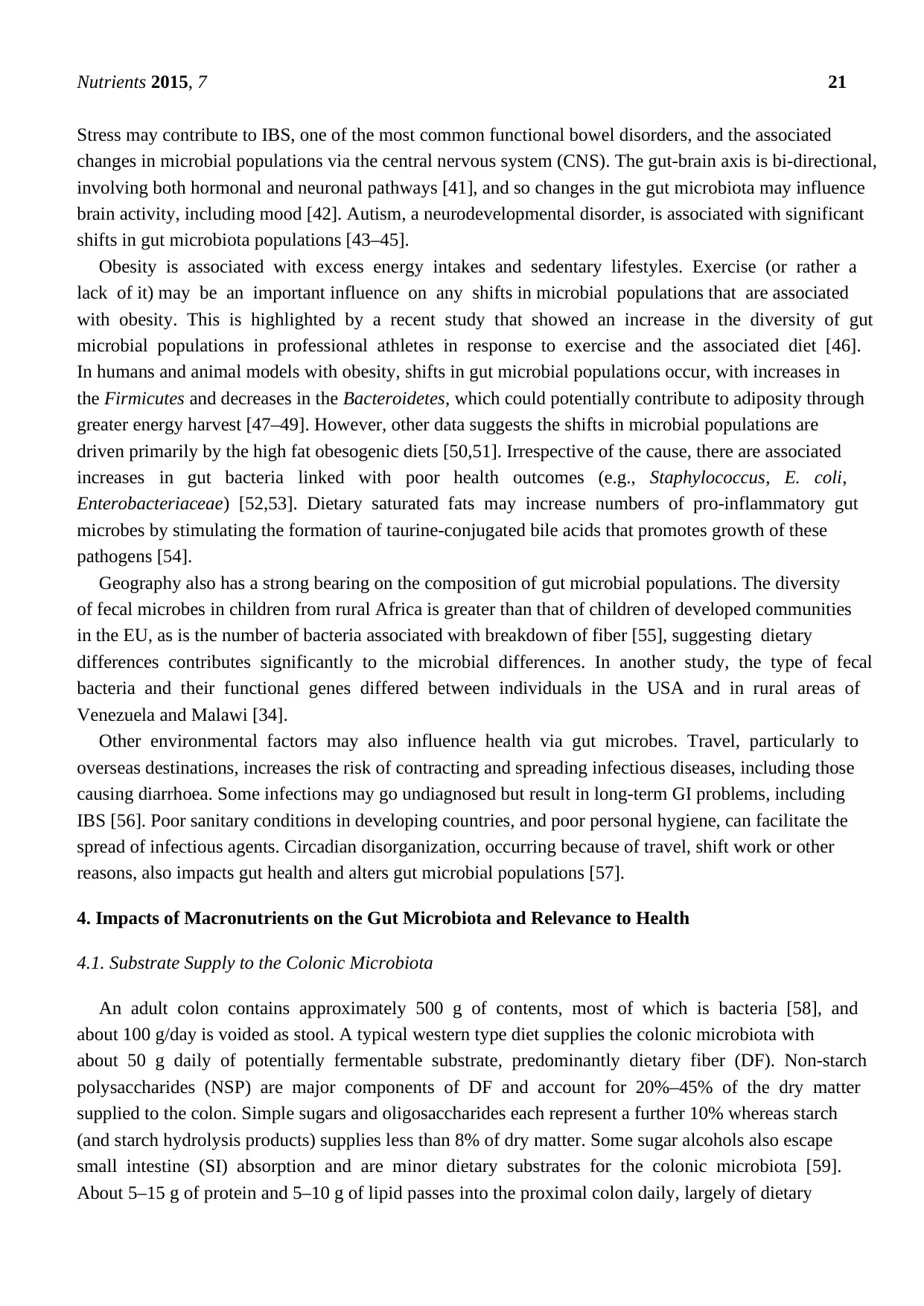
Nutrients 2015, 7 21
Stress may contribute to IBS, one of the most common functional bowel disorders, and the associated
changes in microbial populations via the central nervous system (CNS). The gut-brain axis is bi-directional,
involving both hormonal and neuronal pathways [41], and so changes in the gut microbiota may influence
brain activity, including mood [42]. Autism, a neurodevelopmental disorder, is associated with significant
shifts in gut microbiota populations [43–45].
Obesity is associated with excess energy intakes and sedentary lifestyles. Exercise (or rather a
lack of it) may be an important influence on any shifts in microbial populations that are associated
with obesity. This is highlighted by a recent study that showed an increase in the diversity of gut
microbial populations in professional athletes in response to exercise and the associated diet [46].
In humans and animal models with obesity, shifts in gut microbial populations occur, with increases in
the Firmicutes and decreases in the Bacteroidetes, which could potentially contribute to adiposity through
greater energy harvest [47–49]. However, other data suggests the shifts in microbial populations are
driven primarily by the high fat obesogenic diets [50,51]. Irrespective of the cause, there are associated
increases in gut bacteria linked with poor health outcomes (e.g., Staphylococcus, E. coli,
Enterobacteriaceae) [52,53]. Dietary saturated fats may increase numbers of pro-inflammatory gut
microbes by stimulating the formation of taurine-conjugated bile acids that promotes growth of these
pathogens [54].
Geography also has a strong bearing on the composition of gut microbial populations. The diversity
of fecal microbes in children from rural Africa is greater than that of children of developed communities
in the EU, as is the number of bacteria associated with breakdown of fiber [55], suggesting dietary
differences contributes significantly to the microbial differences. In another study, the type of fecal
bacteria and their functional genes differed between individuals in the USA and in rural areas of
Venezuela and Malawi [34].
Other environmental factors may also influence health via gut microbes. Travel, particularly to
overseas destinations, increases the risk of contracting and spreading infectious diseases, including those
causing diarrhoea. Some infections may go undiagnosed but result in long-term GI problems, including
IBS [56]. Poor sanitary conditions in developing countries, and poor personal hygiene, can facilitate the
spread of infectious agents. Circadian disorganization, occurring because of travel, shift work or other
reasons, also impacts gut health and alters gut microbial populations [57].
4. Impacts of Macronutrients on the Gut Microbiota and Relevance to Health
4.1. Substrate Supply to the Colonic Microbiota
An adult colon contains approximately 500 g of contents, most of which is bacteria [58], and
about 100 g/day is voided as stool. A typical western type diet supplies the colonic microbiota with
about 50 g daily of potentially fermentable substrate, predominantly dietary fiber (DF). Non-starch
polysaccharides (NSP) are major components of DF and account for 20%–45% of the dry matter
supplied to the colon. Simple sugars and oligosaccharides each represent a further 10% whereas starch
(and starch hydrolysis products) supplies less than 8% of dry matter. Some sugar alcohols also escape
small intestine (SI) absorption and are minor dietary substrates for the colonic microbiota [59].
About 5–15 g of protein and 5–10 g of lipid passes into the proximal colon daily, largely of dietary
Stress may contribute to IBS, one of the most common functional bowel disorders, and the associated
changes in microbial populations via the central nervous system (CNS). The gut-brain axis is bi-directional,
involving both hormonal and neuronal pathways [41], and so changes in the gut microbiota may influence
brain activity, including mood [42]. Autism, a neurodevelopmental disorder, is associated with significant
shifts in gut microbiota populations [43–45].
Obesity is associated with excess energy intakes and sedentary lifestyles. Exercise (or rather a
lack of it) may be an important influence on any shifts in microbial populations that are associated
with obesity. This is highlighted by a recent study that showed an increase in the diversity of gut
microbial populations in professional athletes in response to exercise and the associated diet [46].
In humans and animal models with obesity, shifts in gut microbial populations occur, with increases in
the Firmicutes and decreases in the Bacteroidetes, which could potentially contribute to adiposity through
greater energy harvest [47–49]. However, other data suggests the shifts in microbial populations are
driven primarily by the high fat obesogenic diets [50,51]. Irrespective of the cause, there are associated
increases in gut bacteria linked with poor health outcomes (e.g., Staphylococcus, E. coli,
Enterobacteriaceae) [52,53]. Dietary saturated fats may increase numbers of pro-inflammatory gut
microbes by stimulating the formation of taurine-conjugated bile acids that promotes growth of these
pathogens [54].
Geography also has a strong bearing on the composition of gut microbial populations. The diversity
of fecal microbes in children from rural Africa is greater than that of children of developed communities
in the EU, as is the number of bacteria associated with breakdown of fiber [55], suggesting dietary
differences contributes significantly to the microbial differences. In another study, the type of fecal
bacteria and their functional genes differed between individuals in the USA and in rural areas of
Venezuela and Malawi [34].
Other environmental factors may also influence health via gut microbes. Travel, particularly to
overseas destinations, increases the risk of contracting and spreading infectious diseases, including those
causing diarrhoea. Some infections may go undiagnosed but result in long-term GI problems, including
IBS [56]. Poor sanitary conditions in developing countries, and poor personal hygiene, can facilitate the
spread of infectious agents. Circadian disorganization, occurring because of travel, shift work or other
reasons, also impacts gut health and alters gut microbial populations [57].
4. Impacts of Macronutrients on the Gut Microbiota and Relevance to Health
4.1. Substrate Supply to the Colonic Microbiota
An adult colon contains approximately 500 g of contents, most of which is bacteria [58], and
about 100 g/day is voided as stool. A typical western type diet supplies the colonic microbiota with
about 50 g daily of potentially fermentable substrate, predominantly dietary fiber (DF). Non-starch
polysaccharides (NSP) are major components of DF and account for 20%–45% of the dry matter
supplied to the colon. Simple sugars and oligosaccharides each represent a further 10% whereas starch
(and starch hydrolysis products) supplies less than 8% of dry matter. Some sugar alcohols also escape
small intestine (SI) absorption and are minor dietary substrates for the colonic microbiota [59].
About 5–15 g of protein and 5–10 g of lipid passes into the proximal colon daily, largely of dietary
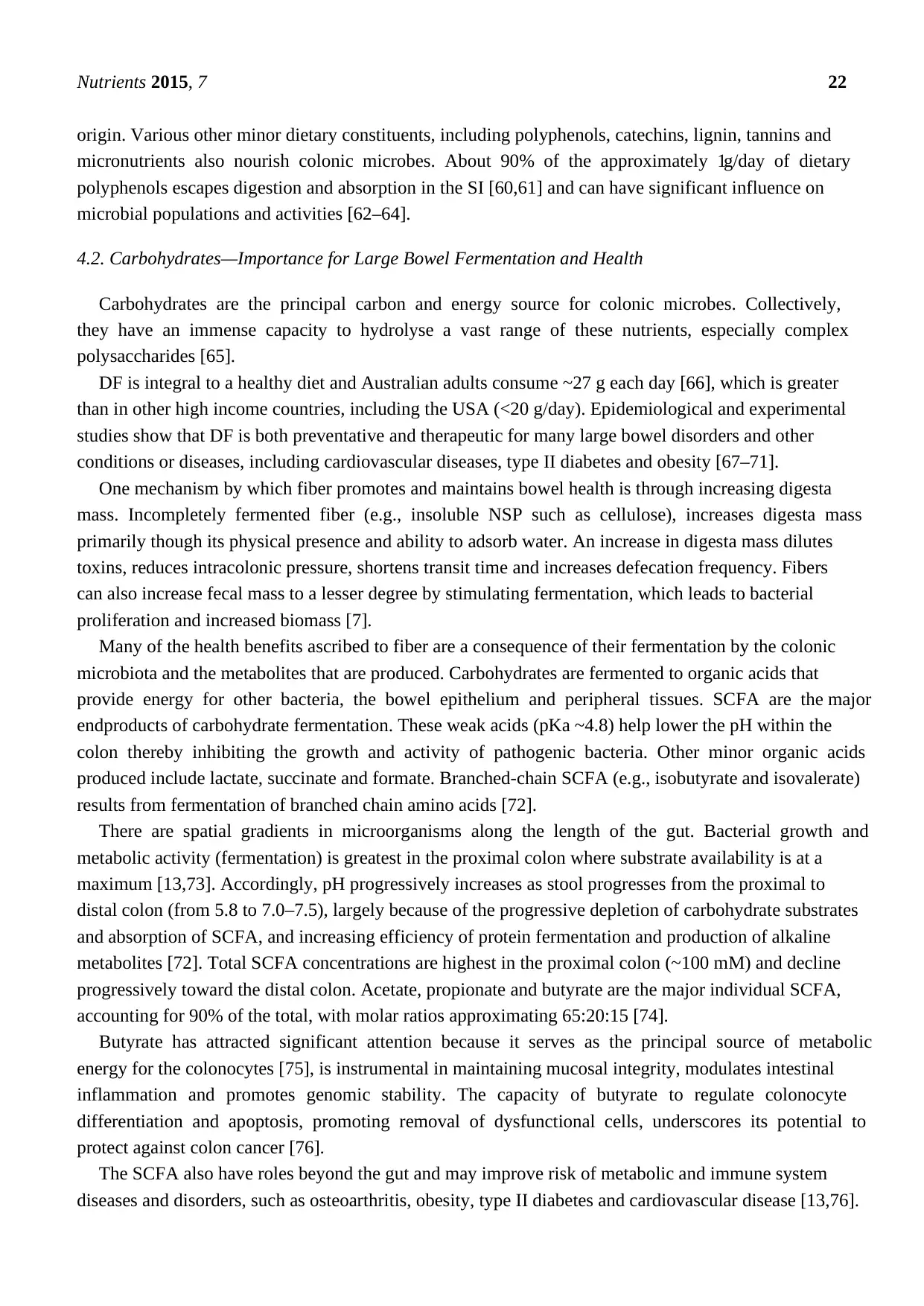
Nutrients 2015, 7 22
origin. Various other minor dietary constituents, including polyphenols, catechins, lignin, tannins and
micronutrients also nourish colonic microbes. About 90% of the approximately 1g/day of dietary
polyphenols escapes digestion and absorption in the SI [60,61] and can have significant influence on
microbial populations and activities [62–64].
4.2. Carbohydrates—Importance for Large Bowel Fermentation and Health
Carbohydrates are the principal carbon and energy source for colonic microbes. Collectively,
they have an immense capacity to hydrolyse a vast range of these nutrients, especially complex
polysaccharides [65].
DF is integral to a healthy diet and Australian adults consume ~27 g each day [66], which is greater
than in other high income countries, including the USA (<20 g/day). Epidemiological and experimental
studies show that DF is both preventative and therapeutic for many large bowel disorders and other
conditions or diseases, including cardiovascular diseases, type II diabetes and obesity [67–71].
One mechanism by which fiber promotes and maintains bowel health is through increasing digesta
mass. Incompletely fermented fiber (e.g., insoluble NSP such as cellulose), increases digesta mass
primarily though its physical presence and ability to adsorb water. An increase in digesta mass dilutes
toxins, reduces intracolonic pressure, shortens transit time and increases defecation frequency. Fibers
can also increase fecal mass to a lesser degree by stimulating fermentation, which leads to bacterial
proliferation and increased biomass [7].
Many of the health benefits ascribed to fiber are a consequence of their fermentation by the colonic
microbiota and the metabolites that are produced. Carbohydrates are fermented to organic acids that
provide energy for other bacteria, the bowel epithelium and peripheral tissues. SCFA are the major
endproducts of carbohydrate fermentation. These weak acids (pKa ~4.8) help lower the pH within the
colon thereby inhibiting the growth and activity of pathogenic bacteria. Other minor organic acids
produced include lactate, succinate and formate. Branched-chain SCFA (e.g., isobutyrate and isovalerate)
results from fermentation of branched chain amino acids [72].
There are spatial gradients in microorganisms along the length of the gut. Bacterial growth and
metabolic activity (fermentation) is greatest in the proximal colon where substrate availability is at a
maximum [13,73]. Accordingly, pH progressively increases as stool progresses from the proximal to
distal colon (from 5.8 to 7.0–7.5), largely because of the progressive depletion of carbohydrate substrates
and absorption of SCFA, and increasing efficiency of protein fermentation and production of alkaline
metabolites [72]. Total SCFA concentrations are highest in the proximal colon (~100 mM) and decline
progressively toward the distal colon. Acetate, propionate and butyrate are the major individual SCFA,
accounting for 90% of the total, with molar ratios approximating 65:20:15 [74].
Butyrate has attracted significant attention because it serves as the principal source of metabolic
energy for the colonocytes [75], is instrumental in maintaining mucosal integrity, modulates intestinal
inflammation and promotes genomic stability. The capacity of butyrate to regulate colonocyte
differentiation and apoptosis, promoting removal of dysfunctional cells, underscores its potential to
protect against colon cancer [76].
The SCFA also have roles beyond the gut and may improve risk of metabolic and immune system
diseases and disorders, such as osteoarthritis, obesity, type II diabetes and cardiovascular disease [13,76].
origin. Various other minor dietary constituents, including polyphenols, catechins, lignin, tannins and
micronutrients also nourish colonic microbes. About 90% of the approximately 1g/day of dietary
polyphenols escapes digestion and absorption in the SI [60,61] and can have significant influence on
microbial populations and activities [62–64].
4.2. Carbohydrates—Importance for Large Bowel Fermentation and Health
Carbohydrates are the principal carbon and energy source for colonic microbes. Collectively,
they have an immense capacity to hydrolyse a vast range of these nutrients, especially complex
polysaccharides [65].
DF is integral to a healthy diet and Australian adults consume ~27 g each day [66], which is greater
than in other high income countries, including the USA (<20 g/day). Epidemiological and experimental
studies show that DF is both preventative and therapeutic for many large bowel disorders and other
conditions or diseases, including cardiovascular diseases, type II diabetes and obesity [67–71].
One mechanism by which fiber promotes and maintains bowel health is through increasing digesta
mass. Incompletely fermented fiber (e.g., insoluble NSP such as cellulose), increases digesta mass
primarily though its physical presence and ability to adsorb water. An increase in digesta mass dilutes
toxins, reduces intracolonic pressure, shortens transit time and increases defecation frequency. Fibers
can also increase fecal mass to a lesser degree by stimulating fermentation, which leads to bacterial
proliferation and increased biomass [7].
Many of the health benefits ascribed to fiber are a consequence of their fermentation by the colonic
microbiota and the metabolites that are produced. Carbohydrates are fermented to organic acids that
provide energy for other bacteria, the bowel epithelium and peripheral tissues. SCFA are the major
endproducts of carbohydrate fermentation. These weak acids (pKa ~4.8) help lower the pH within the
colon thereby inhibiting the growth and activity of pathogenic bacteria. Other minor organic acids
produced include lactate, succinate and formate. Branched-chain SCFA (e.g., isobutyrate and isovalerate)
results from fermentation of branched chain amino acids [72].
There are spatial gradients in microorganisms along the length of the gut. Bacterial growth and
metabolic activity (fermentation) is greatest in the proximal colon where substrate availability is at a
maximum [13,73]. Accordingly, pH progressively increases as stool progresses from the proximal to
distal colon (from 5.8 to 7.0–7.5), largely because of the progressive depletion of carbohydrate substrates
and absorption of SCFA, and increasing efficiency of protein fermentation and production of alkaline
metabolites [72]. Total SCFA concentrations are highest in the proximal colon (~100 mM) and decline
progressively toward the distal colon. Acetate, propionate and butyrate are the major individual SCFA,
accounting for 90% of the total, with molar ratios approximating 65:20:15 [74].
Butyrate has attracted significant attention because it serves as the principal source of metabolic
energy for the colonocytes [75], is instrumental in maintaining mucosal integrity, modulates intestinal
inflammation and promotes genomic stability. The capacity of butyrate to regulate colonocyte
differentiation and apoptosis, promoting removal of dysfunctional cells, underscores its potential to
protect against colon cancer [76].
The SCFA also have roles beyond the gut and may improve risk of metabolic and immune system
diseases and disorders, such as osteoarthritis, obesity, type II diabetes and cardiovascular disease [13,76].
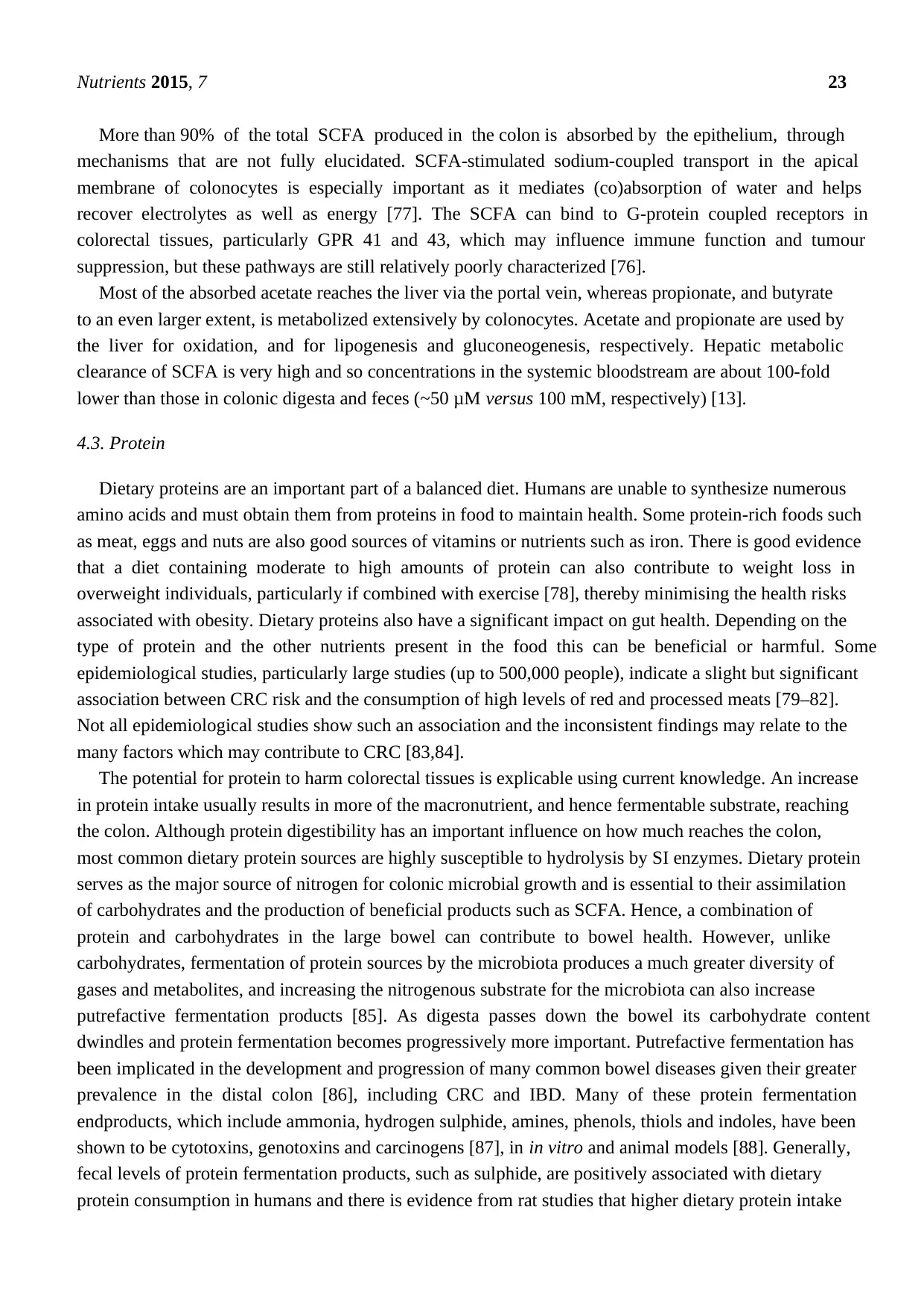
Nutrients 2015, 7 23
More than 90% of the total SCFA produced in the colon is absorbed by the epithelium, through
mechanisms that are not fully elucidated. SCFA-stimulated sodium-coupled transport in the apical
membrane of colonocytes is especially important as it mediates (co)absorption of water and helps
recover electrolytes as well as energy [77]. The SCFA can bind to G-protein coupled receptors in
colorectal tissues, particularly GPR 41 and 43, which may influence immune function and tumour
suppression, but these pathways are still relatively poorly characterized [76].
Most of the absorbed acetate reaches the liver via the portal vein, whereas propionate, and butyrate
to an even larger extent, is metabolized extensively by colonocytes. Acetate and propionate are used by
the liver for oxidation, and for lipogenesis and gluconeogenesis, respectively. Hepatic metabolic
clearance of SCFA is very high and so concentrations in the systemic bloodstream are about 100-fold
lower than those in colonic digesta and feces (~50 μM versus 100 mM, respectively) [13].
4.3. Protein
Dietary proteins are an important part of a balanced diet. Humans are unable to synthesize numerous
amino acids and must obtain them from proteins in food to maintain health. Some protein-rich foods such
as meat, eggs and nuts are also good sources of vitamins or nutrients such as iron. There is good evidence
that a diet containing moderate to high amounts of protein can also contribute to weight loss in
overweight individuals, particularly if combined with exercise [78], thereby minimising the health risks
associated with obesity. Dietary proteins also have a significant impact on gut health. Depending on the
type of protein and the other nutrients present in the food this can be beneficial or harmful. Some
epidemiological studies, particularly large studies (up to 500,000 people), indicate a slight but significant
association between CRC risk and the consumption of high levels of red and processed meats [79–82].
Not all epidemiological studies show such an association and the inconsistent findings may relate to the
many factors which may contribute to CRC [83,84].
The potential for protein to harm colorectal tissues is explicable using current knowledge. An increase
in protein intake usually results in more of the macronutrient, and hence fermentable substrate, reaching
the colon. Although protein digestibility has an important influence on how much reaches the colon,
most common dietary protein sources are highly susceptible to hydrolysis by SI enzymes. Dietary protein
serves as the major source of nitrogen for colonic microbial growth and is essential to their assimilation
of carbohydrates and the production of beneficial products such as SCFA. Hence, a combination of
protein and carbohydrates in the large bowel can contribute to bowel health. However, unlike
carbohydrates, fermentation of protein sources by the microbiota produces a much greater diversity of
gases and metabolites, and increasing the nitrogenous substrate for the microbiota can also increase
putrefactive fermentation products [85]. As digesta passes down the bowel its carbohydrate content
dwindles and protein fermentation becomes progressively more important. Putrefactive fermentation has
been implicated in the development and progression of many common bowel diseases given their greater
prevalence in the distal colon [86], including CRC and IBD. Many of these protein fermentation
endproducts, which include ammonia, hydrogen sulphide, amines, phenols, thiols and indoles, have been
shown to be cytotoxins, genotoxins and carcinogens [87], in in vitro and animal models [88]. Generally,
fecal levels of protein fermentation products, such as sulphide, are positively associated with dietary
protein consumption in humans and there is evidence from rat studies that higher dietary protein intake
More than 90% of the total SCFA produced in the colon is absorbed by the epithelium, through
mechanisms that are not fully elucidated. SCFA-stimulated sodium-coupled transport in the apical
membrane of colonocytes is especially important as it mediates (co)absorption of water and helps
recover electrolytes as well as energy [77]. The SCFA can bind to G-protein coupled receptors in
colorectal tissues, particularly GPR 41 and 43, which may influence immune function and tumour
suppression, but these pathways are still relatively poorly characterized [76].
Most of the absorbed acetate reaches the liver via the portal vein, whereas propionate, and butyrate
to an even larger extent, is metabolized extensively by colonocytes. Acetate and propionate are used by
the liver for oxidation, and for lipogenesis and gluconeogenesis, respectively. Hepatic metabolic
clearance of SCFA is very high and so concentrations in the systemic bloodstream are about 100-fold
lower than those in colonic digesta and feces (~50 μM versus 100 mM, respectively) [13].
4.3. Protein
Dietary proteins are an important part of a balanced diet. Humans are unable to synthesize numerous
amino acids and must obtain them from proteins in food to maintain health. Some protein-rich foods such
as meat, eggs and nuts are also good sources of vitamins or nutrients such as iron. There is good evidence
that a diet containing moderate to high amounts of protein can also contribute to weight loss in
overweight individuals, particularly if combined with exercise [78], thereby minimising the health risks
associated with obesity. Dietary proteins also have a significant impact on gut health. Depending on the
type of protein and the other nutrients present in the food this can be beneficial or harmful. Some
epidemiological studies, particularly large studies (up to 500,000 people), indicate a slight but significant
association between CRC risk and the consumption of high levels of red and processed meats [79–82].
Not all epidemiological studies show such an association and the inconsistent findings may relate to the
many factors which may contribute to CRC [83,84].
The potential for protein to harm colorectal tissues is explicable using current knowledge. An increase
in protein intake usually results in more of the macronutrient, and hence fermentable substrate, reaching
the colon. Although protein digestibility has an important influence on how much reaches the colon,
most common dietary protein sources are highly susceptible to hydrolysis by SI enzymes. Dietary protein
serves as the major source of nitrogen for colonic microbial growth and is essential to their assimilation
of carbohydrates and the production of beneficial products such as SCFA. Hence, a combination of
protein and carbohydrates in the large bowel can contribute to bowel health. However, unlike
carbohydrates, fermentation of protein sources by the microbiota produces a much greater diversity of
gases and metabolites, and increasing the nitrogenous substrate for the microbiota can also increase
putrefactive fermentation products [85]. As digesta passes down the bowel its carbohydrate content
dwindles and protein fermentation becomes progressively more important. Putrefactive fermentation has
been implicated in the development and progression of many common bowel diseases given their greater
prevalence in the distal colon [86], including CRC and IBD. Many of these protein fermentation
endproducts, which include ammonia, hydrogen sulphide, amines, phenols, thiols and indoles, have been
shown to be cytotoxins, genotoxins and carcinogens [87], in in vitro and animal models [88]. Generally,
fecal levels of protein fermentation products, such as sulphide, are positively associated with dietary
protein consumption in humans and there is evidence from rat studies that higher dietary protein intake
Paraphrase This Document
Need a fresh take? Get an instant paraphrase of this document with our AI Paraphraser
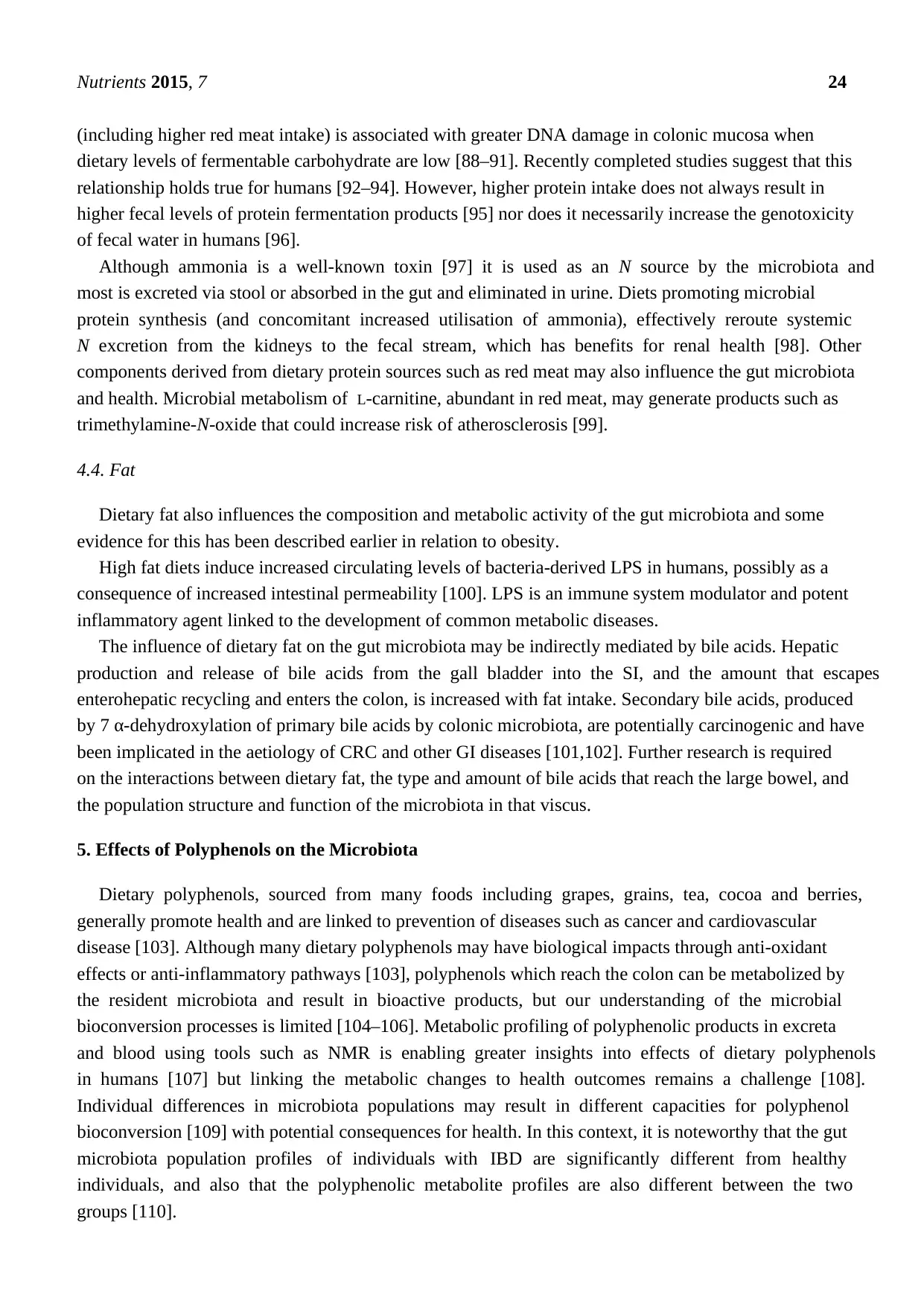
Nutrients 2015, 7 24
(including higher red meat intake) is associated with greater DNA damage in colonic mucosa when
dietary levels of fermentable carbohydrate are low [88–91]. Recently completed studies suggest that this
relationship holds true for humans [92–94]. However, higher protein intake does not always result in
higher fecal levels of protein fermentation products [95] nor does it necessarily increase the genotoxicity
of fecal water in humans [96].
Although ammonia is a well-known toxin [97] it is used as an N source by the microbiota and
most is excreted via stool or absorbed in the gut and eliminated in urine. Diets promoting microbial
protein synthesis (and concomitant increased utilisation of ammonia), effectively reroute systemic
N excretion from the kidneys to the fecal stream, which has benefits for renal health [98]. Other
components derived from dietary protein sources such as red meat may also influence the gut microbiota
and health. Microbial metabolism of L-carnitine, abundant in red meat, may generate products such as
trimethylamine-N-oxide that could increase risk of atherosclerosis [99].
4.4. Fat
Dietary fat also influences the composition and metabolic activity of the gut microbiota and some
evidence for this has been described earlier in relation to obesity.
High fat diets induce increased circulating levels of bacteria-derived LPS in humans, possibly as a
consequence of increased intestinal permeability [100]. LPS is an immune system modulator and potent
inflammatory agent linked to the development of common metabolic diseases.
The influence of dietary fat on the gut microbiota may be indirectly mediated by bile acids. Hepatic
production and release of bile acids from the gall bladder into the SI, and the amount that escapes
enterohepatic recycling and enters the colon, is increased with fat intake. Secondary bile acids, produced
by 7 α-dehydroxylation of primary bile acids by colonic microbiota, are potentially carcinogenic and have
been implicated in the aetiology of CRC and other GI diseases [101,102]. Further research is required
on the interactions between dietary fat, the type and amount of bile acids that reach the large bowel, and
the population structure and function of the microbiota in that viscus.
5. Effects of Polyphenols on the Microbiota
Dietary polyphenols, sourced from many foods including grapes, grains, tea, cocoa and berries,
generally promote health and are linked to prevention of diseases such as cancer and cardiovascular
disease [103]. Although many dietary polyphenols may have biological impacts through anti-oxidant
effects or anti-inflammatory pathways [103], polyphenols which reach the colon can be metabolized by
the resident microbiota and result in bioactive products, but our understanding of the microbial
bioconversion processes is limited [104–106]. Metabolic profiling of polyphenolic products in excreta
and blood using tools such as NMR is enabling greater insights into effects of dietary polyphenols
in humans [107] but linking the metabolic changes to health outcomes remains a challenge [108].
Individual differences in microbiota populations may result in different capacities for polyphenol
bioconversion [109] with potential consequences for health. In this context, it is noteworthy that the gut
microbiota population profiles of individuals with IBD are significantly different from healthy
individuals, and also that the polyphenolic metabolite profiles are also different between the two
groups [110].
(including higher red meat intake) is associated with greater DNA damage in colonic mucosa when
dietary levels of fermentable carbohydrate are low [88–91]. Recently completed studies suggest that this
relationship holds true for humans [92–94]. However, higher protein intake does not always result in
higher fecal levels of protein fermentation products [95] nor does it necessarily increase the genotoxicity
of fecal water in humans [96].
Although ammonia is a well-known toxin [97] it is used as an N source by the microbiota and
most is excreted via stool or absorbed in the gut and eliminated in urine. Diets promoting microbial
protein synthesis (and concomitant increased utilisation of ammonia), effectively reroute systemic
N excretion from the kidneys to the fecal stream, which has benefits for renal health [98]. Other
components derived from dietary protein sources such as red meat may also influence the gut microbiota
and health. Microbial metabolism of L-carnitine, abundant in red meat, may generate products such as
trimethylamine-N-oxide that could increase risk of atherosclerosis [99].
4.4. Fat
Dietary fat also influences the composition and metabolic activity of the gut microbiota and some
evidence for this has been described earlier in relation to obesity.
High fat diets induce increased circulating levels of bacteria-derived LPS in humans, possibly as a
consequence of increased intestinal permeability [100]. LPS is an immune system modulator and potent
inflammatory agent linked to the development of common metabolic diseases.
The influence of dietary fat on the gut microbiota may be indirectly mediated by bile acids. Hepatic
production and release of bile acids from the gall bladder into the SI, and the amount that escapes
enterohepatic recycling and enters the colon, is increased with fat intake. Secondary bile acids, produced
by 7 α-dehydroxylation of primary bile acids by colonic microbiota, are potentially carcinogenic and have
been implicated in the aetiology of CRC and other GI diseases [101,102]. Further research is required
on the interactions between dietary fat, the type and amount of bile acids that reach the large bowel, and
the population structure and function of the microbiota in that viscus.
5. Effects of Polyphenols on the Microbiota
Dietary polyphenols, sourced from many foods including grapes, grains, tea, cocoa and berries,
generally promote health and are linked to prevention of diseases such as cancer and cardiovascular
disease [103]. Although many dietary polyphenols may have biological impacts through anti-oxidant
effects or anti-inflammatory pathways [103], polyphenols which reach the colon can be metabolized by
the resident microbiota and result in bioactive products, but our understanding of the microbial
bioconversion processes is limited [104–106]. Metabolic profiling of polyphenolic products in excreta
and blood using tools such as NMR is enabling greater insights into effects of dietary polyphenols
in humans [107] but linking the metabolic changes to health outcomes remains a challenge [108].
Individual differences in microbiota populations may result in different capacities for polyphenol
bioconversion [109] with potential consequences for health. In this context, it is noteworthy that the gut
microbiota population profiles of individuals with IBD are significantly different from healthy
individuals, and also that the polyphenolic metabolite profiles are also different between the two
groups [110].
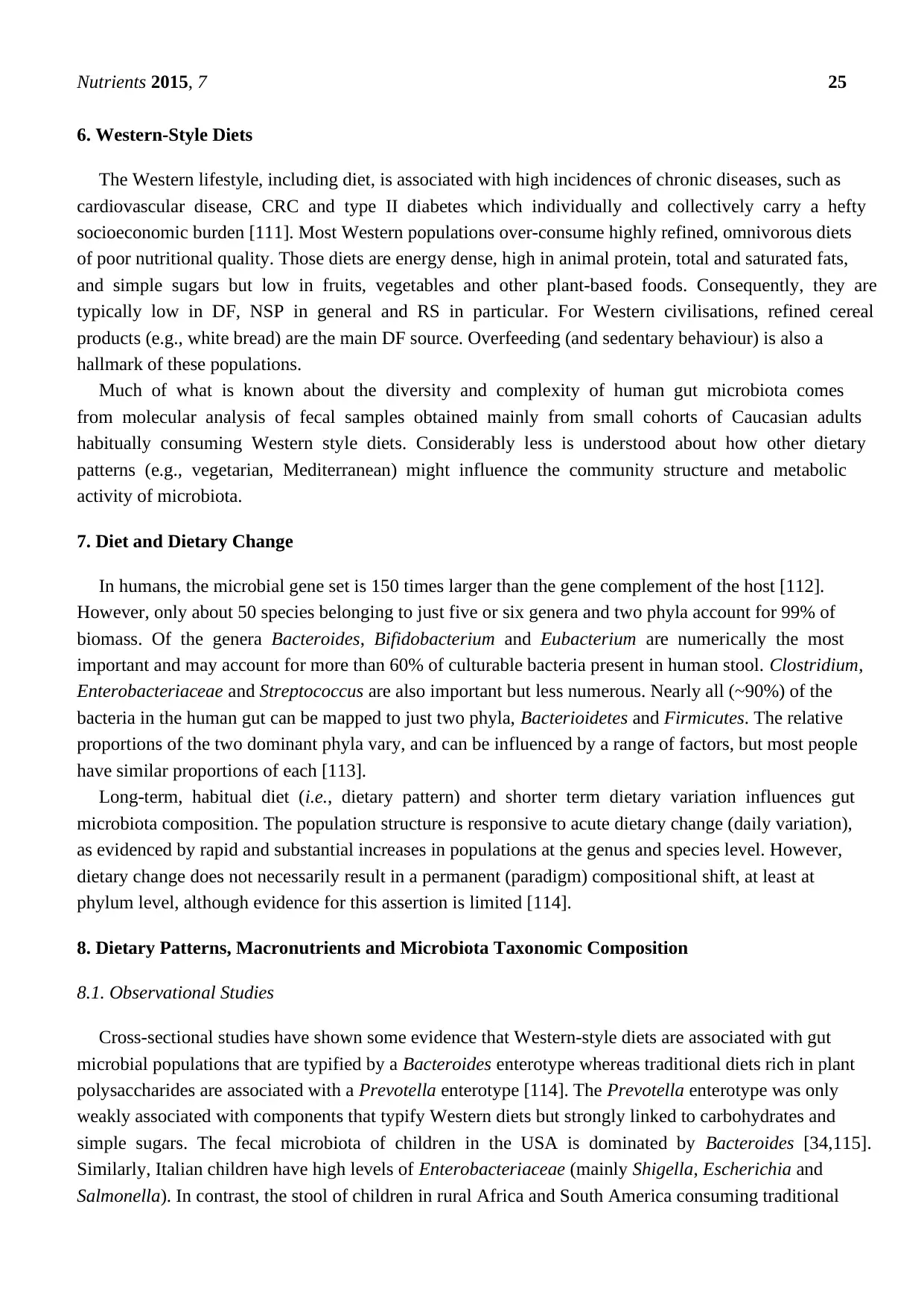
Nutrients 2015, 7 25
6. Western-Style Diets
The Western lifestyle, including diet, is associated with high incidences of chronic diseases, such as
cardiovascular disease, CRC and type II diabetes which individually and collectively carry a hefty
socioeconomic burden [111]. Most Western populations over-consume highly refined, omnivorous diets
of poor nutritional quality. Those diets are energy dense, high in animal protein, total and saturated fats,
and simple sugars but low in fruits, vegetables and other plant-based foods. Consequently, they are
typically low in DF, NSP in general and RS in particular. For Western civilisations, refined cereal
products (e.g., white bread) are the main DF source. Overfeeding (and sedentary behaviour) is also a
hallmark of these populations.
Much of what is known about the diversity and complexity of human gut microbiota comes
from molecular analysis of fecal samples obtained mainly from small cohorts of Caucasian adults
habitually consuming Western style diets. Considerably less is understood about how other dietary
patterns (e.g., vegetarian, Mediterranean) might influence the community structure and metabolic
activity of microbiota.
7. Diet and Dietary Change
In humans, the microbial gene set is 150 times larger than the gene complement of the host [112].
However, only about 50 species belonging to just five or six genera and two phyla account for 99% of
biomass. Of the genera Bacteroides, Bifidobacterium and Eubacterium are numerically the most
important and may account for more than 60% of culturable bacteria present in human stool. Clostridium,
Enterobacteriaceae and Streptococcus are also important but less numerous. Nearly all (~90%) of the
bacteria in the human gut can be mapped to just two phyla, Bacterioidetes and Firmicutes. The relative
proportions of the two dominant phyla vary, and can be influenced by a range of factors, but most people
have similar proportions of each [113].
Long-term, habitual diet (i.e., dietary pattern) and shorter term dietary variation influences gut
microbiota composition. The population structure is responsive to acute dietary change (daily variation),
as evidenced by rapid and substantial increases in populations at the genus and species level. However,
dietary change does not necessarily result in a permanent (paradigm) compositional shift, at least at
phylum level, although evidence for this assertion is limited [114].
8. Dietary Patterns, Macronutrients and Microbiota Taxonomic Composition
8.1. Observational Studies
Cross-sectional studies have shown some evidence that Western-style diets are associated with gut
microbial populations that are typified by a Bacteroides enterotype whereas traditional diets rich in plant
polysaccharides are associated with a Prevotella enterotype [114]. The Prevotella enterotype was only
weakly associated with components that typify Western diets but strongly linked to carbohydrates and
simple sugars. The fecal microbiota of children in the USA is dominated by Bacteroides [34,115].
Similarly, Italian children have high levels of Enterobacteriaceae (mainly Shigella, Escherichia and
Salmonella). In contrast, the stool of children in rural Africa and South America consuming traditional
6. Western-Style Diets
The Western lifestyle, including diet, is associated with high incidences of chronic diseases, such as
cardiovascular disease, CRC and type II diabetes which individually and collectively carry a hefty
socioeconomic burden [111]. Most Western populations over-consume highly refined, omnivorous diets
of poor nutritional quality. Those diets are energy dense, high in animal protein, total and saturated fats,
and simple sugars but low in fruits, vegetables and other plant-based foods. Consequently, they are
typically low in DF, NSP in general and RS in particular. For Western civilisations, refined cereal
products (e.g., white bread) are the main DF source. Overfeeding (and sedentary behaviour) is also a
hallmark of these populations.
Much of what is known about the diversity and complexity of human gut microbiota comes
from molecular analysis of fecal samples obtained mainly from small cohorts of Caucasian adults
habitually consuming Western style diets. Considerably less is understood about how other dietary
patterns (e.g., vegetarian, Mediterranean) might influence the community structure and metabolic
activity of microbiota.
7. Diet and Dietary Change
In humans, the microbial gene set is 150 times larger than the gene complement of the host [112].
However, only about 50 species belonging to just five or six genera and two phyla account for 99% of
biomass. Of the genera Bacteroides, Bifidobacterium and Eubacterium are numerically the most
important and may account for more than 60% of culturable bacteria present in human stool. Clostridium,
Enterobacteriaceae and Streptococcus are also important but less numerous. Nearly all (~90%) of the
bacteria in the human gut can be mapped to just two phyla, Bacterioidetes and Firmicutes. The relative
proportions of the two dominant phyla vary, and can be influenced by a range of factors, but most people
have similar proportions of each [113].
Long-term, habitual diet (i.e., dietary pattern) and shorter term dietary variation influences gut
microbiota composition. The population structure is responsive to acute dietary change (daily variation),
as evidenced by rapid and substantial increases in populations at the genus and species level. However,
dietary change does not necessarily result in a permanent (paradigm) compositional shift, at least at
phylum level, although evidence for this assertion is limited [114].
8. Dietary Patterns, Macronutrients and Microbiota Taxonomic Composition
8.1. Observational Studies
Cross-sectional studies have shown some evidence that Western-style diets are associated with gut
microbial populations that are typified by a Bacteroides enterotype whereas traditional diets rich in plant
polysaccharides are associated with a Prevotella enterotype [114]. The Prevotella enterotype was only
weakly associated with components that typify Western diets but strongly linked to carbohydrates and
simple sugars. The fecal microbiota of children in the USA is dominated by Bacteroides [34,115].
Similarly, Italian children have high levels of Enterobacteriaceae (mainly Shigella, Escherichia and
Salmonella). In contrast, the stool of children in rural Africa and South America consuming traditional
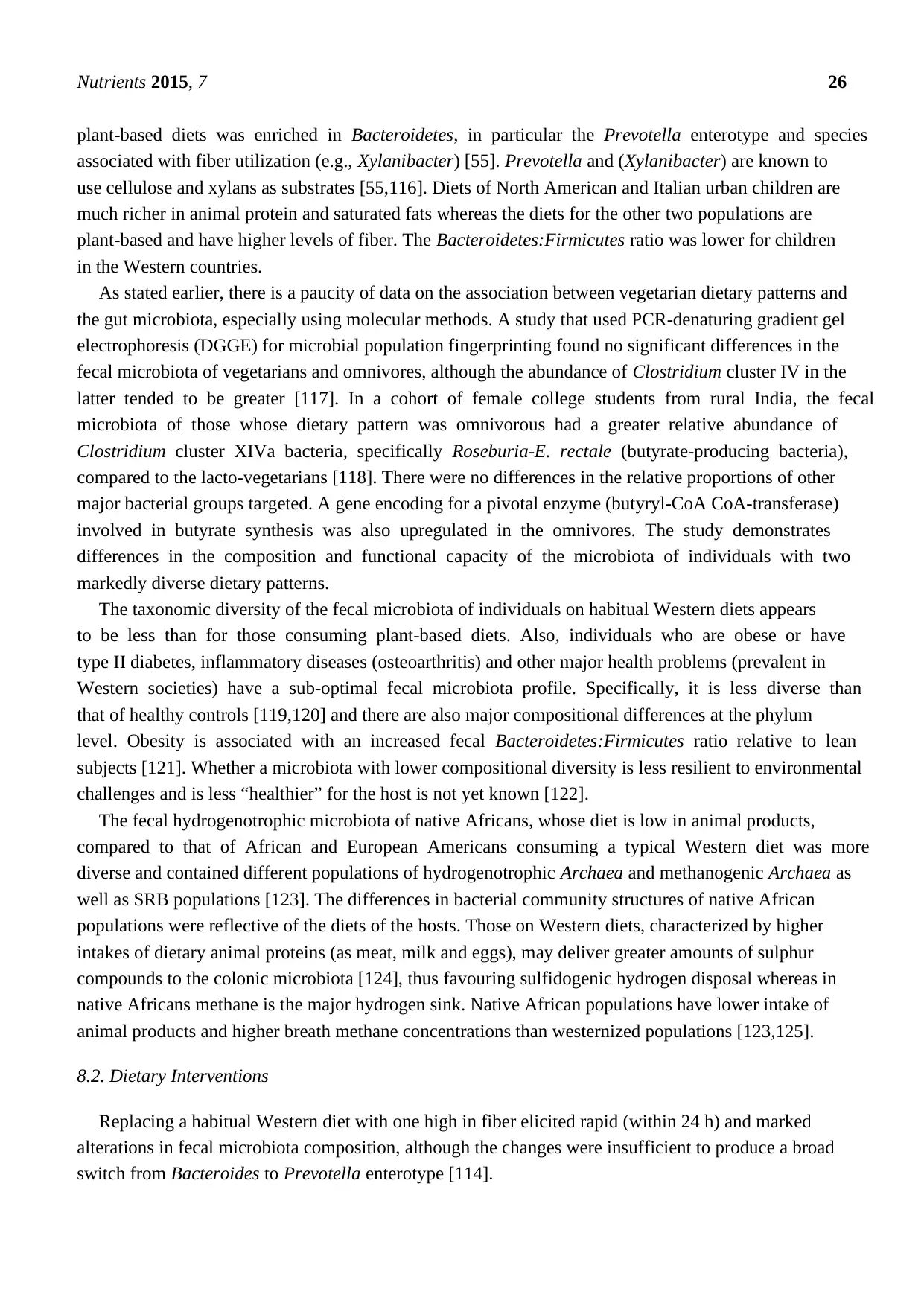
Nutrients 2015, 7 26
plant-based diets was enriched in Bacteroidetes, in particular the Prevotella enterotype and species
associated with fiber utilization (e.g., Xylanibacter) [55]. Prevotella and (Xylanibacter) are known to
use cellulose and xylans as substrates [55,116]. Diets of North American and Italian urban children are
much richer in animal protein and saturated fats whereas the diets for the other two populations are
plant-based and have higher levels of fiber. The Bacteroidetes:Firmicutes ratio was lower for children
in the Western countries.
As stated earlier, there is a paucity of data on the association between vegetarian dietary patterns and
the gut microbiota, especially using molecular methods. A study that used PCR-denaturing gradient gel
electrophoresis (DGGE) for microbial population fingerprinting found no significant differences in the
fecal microbiota of vegetarians and omnivores, although the abundance of Clostridium cluster IV in the
latter tended to be greater [117]. In a cohort of female college students from rural India, the fecal
microbiota of those whose dietary pattern was omnivorous had a greater relative abundance of
Clostridium cluster XIVa bacteria, specifically Roseburia-E. rectale (butyrate-producing bacteria),
compared to the lacto-vegetarians [118]. There were no differences in the relative proportions of other
major bacterial groups targeted. A gene encoding for a pivotal enzyme (butyryl-CoA CoA-transferase)
involved in butyrate synthesis was also upregulated in the omnivores. The study demonstrates
differences in the composition and functional capacity of the microbiota of individuals with two
markedly diverse dietary patterns.
The taxonomic diversity of the fecal microbiota of individuals on habitual Western diets appears
to be less than for those consuming plant-based diets. Also, individuals who are obese or have
type II diabetes, inflammatory diseases (osteoarthritis) and other major health problems (prevalent in
Western societies) have a sub-optimal fecal microbiota profile. Specifically, it is less diverse than
that of healthy controls [119,120] and there are also major compositional differences at the phylum
level. Obesity is associated with an increased fecal Bacteroidetes:Firmicutes ratio relative to lean
subjects [121]. Whether a microbiota with lower compositional diversity is less resilient to environmental
challenges and is less “healthier” for the host is not yet known [122].
The fecal hydrogenotrophic microbiota of native Africans, whose diet is low in animal products,
compared to that of African and European Americans consuming a typical Western diet was more
diverse and contained different populations of hydrogenotrophic Archaea and methanogenic Archaea as
well as SRB populations [123]. The differences in bacterial community structures of native African
populations were reflective of the diets of the hosts. Those on Western diets, characterized by higher
intakes of dietary animal proteins (as meat, milk and eggs), may deliver greater amounts of sulphur
compounds to the colonic microbiota [124], thus favouring sulfidogenic hydrogen disposal whereas in
native Africans methane is the major hydrogen sink. Native African populations have lower intake of
animal products and higher breath methane concentrations than westernized populations [123,125].
8.2. Dietary Interventions
Replacing a habitual Western diet with one high in fiber elicited rapid (within 24 h) and marked
alterations in fecal microbiota composition, although the changes were insufficient to produce a broad
switch from Bacteroides to Prevotella enterotype [114].
plant-based diets was enriched in Bacteroidetes, in particular the Prevotella enterotype and species
associated with fiber utilization (e.g., Xylanibacter) [55]. Prevotella and (Xylanibacter) are known to
use cellulose and xylans as substrates [55,116]. Diets of North American and Italian urban children are
much richer in animal protein and saturated fats whereas the diets for the other two populations are
plant-based and have higher levels of fiber. The Bacteroidetes:Firmicutes ratio was lower for children
in the Western countries.
As stated earlier, there is a paucity of data on the association between vegetarian dietary patterns and
the gut microbiota, especially using molecular methods. A study that used PCR-denaturing gradient gel
electrophoresis (DGGE) for microbial population fingerprinting found no significant differences in the
fecal microbiota of vegetarians and omnivores, although the abundance of Clostridium cluster IV in the
latter tended to be greater [117]. In a cohort of female college students from rural India, the fecal
microbiota of those whose dietary pattern was omnivorous had a greater relative abundance of
Clostridium cluster XIVa bacteria, specifically Roseburia-E. rectale (butyrate-producing bacteria),
compared to the lacto-vegetarians [118]. There were no differences in the relative proportions of other
major bacterial groups targeted. A gene encoding for a pivotal enzyme (butyryl-CoA CoA-transferase)
involved in butyrate synthesis was also upregulated in the omnivores. The study demonstrates
differences in the composition and functional capacity of the microbiota of individuals with two
markedly diverse dietary patterns.
The taxonomic diversity of the fecal microbiota of individuals on habitual Western diets appears
to be less than for those consuming plant-based diets. Also, individuals who are obese or have
type II diabetes, inflammatory diseases (osteoarthritis) and other major health problems (prevalent in
Western societies) have a sub-optimal fecal microbiota profile. Specifically, it is less diverse than
that of healthy controls [119,120] and there are also major compositional differences at the phylum
level. Obesity is associated with an increased fecal Bacteroidetes:Firmicutes ratio relative to lean
subjects [121]. Whether a microbiota with lower compositional diversity is less resilient to environmental
challenges and is less “healthier” for the host is not yet known [122].
The fecal hydrogenotrophic microbiota of native Africans, whose diet is low in animal products,
compared to that of African and European Americans consuming a typical Western diet was more
diverse and contained different populations of hydrogenotrophic Archaea and methanogenic Archaea as
well as SRB populations [123]. The differences in bacterial community structures of native African
populations were reflective of the diets of the hosts. Those on Western diets, characterized by higher
intakes of dietary animal proteins (as meat, milk and eggs), may deliver greater amounts of sulphur
compounds to the colonic microbiota [124], thus favouring sulfidogenic hydrogen disposal whereas in
native Africans methane is the major hydrogen sink. Native African populations have lower intake of
animal products and higher breath methane concentrations than westernized populations [123,125].
8.2. Dietary Interventions
Replacing a habitual Western diet with one high in fiber elicited rapid (within 24 h) and marked
alterations in fecal microbiota composition, although the changes were insufficient to produce a broad
switch from Bacteroides to Prevotella enterotype [114].
Secure Best Marks with AI Grader
Need help grading? Try our AI Grader for instant feedback on your assignments.
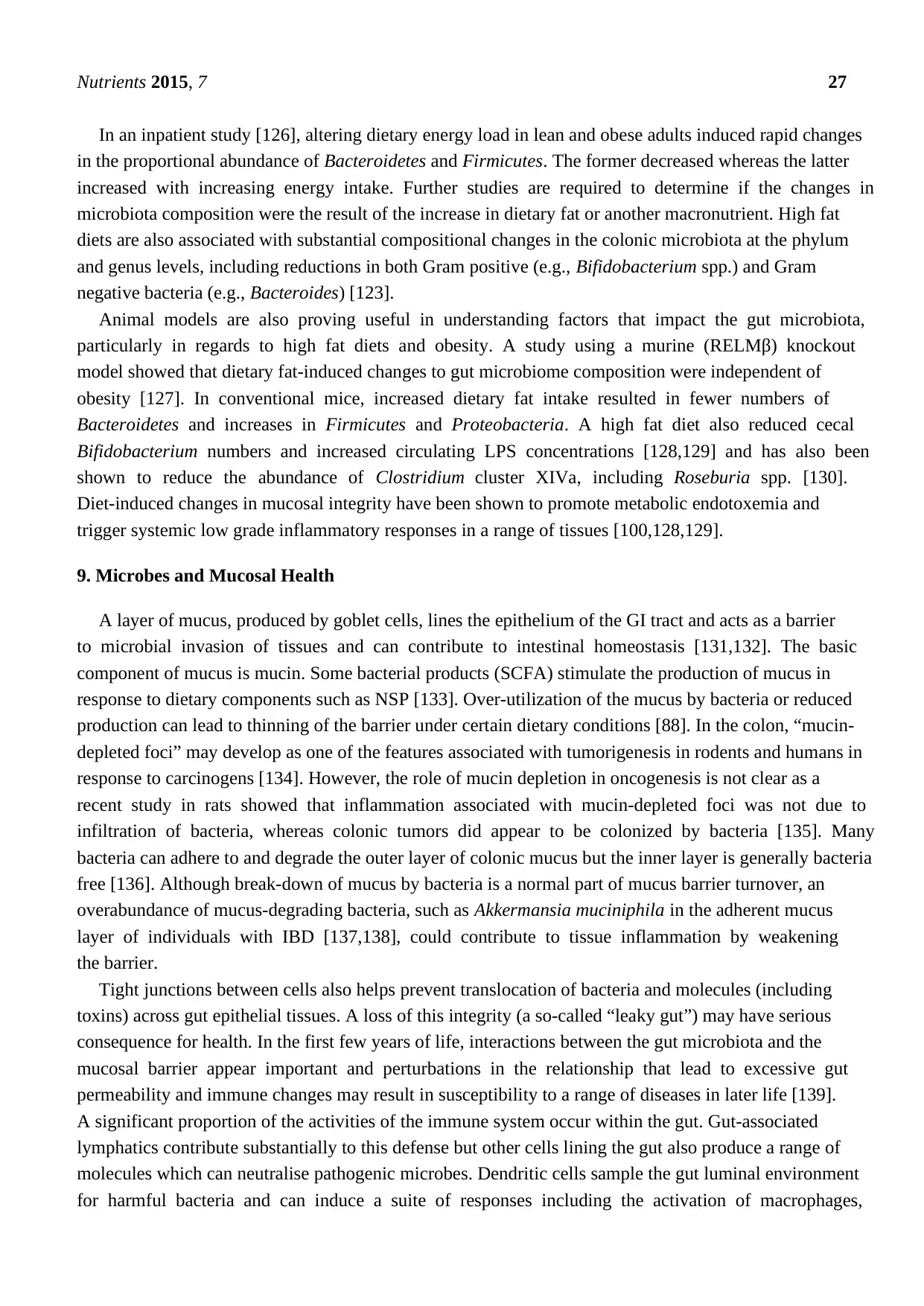
Nutrients 2015, 7 27
In an inpatient study [126], altering dietary energy load in lean and obese adults induced rapid changes
in the proportional abundance of Bacteroidetes and Firmicutes. The former decreased whereas the latter
increased with increasing energy intake. Further studies are required to determine if the changes in
microbiota composition were the result of the increase in dietary fat or another macronutrient. High fat
diets are also associated with substantial compositional changes in the colonic microbiota at the phylum
and genus levels, including reductions in both Gram positive (e.g., Bifidobacterium spp.) and Gram
negative bacteria (e.g., Bacteroides) [123].
Animal models are also proving useful in understanding factors that impact the gut microbiota,
particularly in regards to high fat diets and obesity. A study using a murine (RELMβ) knockout
model showed that dietary fat-induced changes to gut microbiome composition were independent of
obesity [127]. In conventional mice, increased dietary fat intake resulted in fewer numbers of
Bacteroidetes and increases in Firmicutes and Proteobacteria. A high fat diet also reduced cecal
Bifidobacterium numbers and increased circulating LPS concentrations [128,129] and has also been
shown to reduce the abundance of Clostridium cluster XIVa, including Roseburia spp. [130].
Diet-induced changes in mucosal integrity have been shown to promote metabolic endotoxemia and
trigger systemic low grade inflammatory responses in a range of tissues [100,128,129].
9. Microbes and Mucosal Health
A layer of mucus, produced by goblet cells, lines the epithelium of the GI tract and acts as a barrier
to microbial invasion of tissues and can contribute to intestinal homeostasis [131,132]. The basic
component of mucus is mucin. Some bacterial products (SCFA) stimulate the production of mucus in
response to dietary components such as NSP [133]. Over-utilization of the mucus by bacteria or reduced
production can lead to thinning of the barrier under certain dietary conditions [88]. In the colon, “mucin-
depleted foci” may develop as one of the features associated with tumorigenesis in rodents and humans in
response to carcinogens [134]. However, the role of mucin depletion in oncogenesis is not clear as a
recent study in rats showed that inflammation associated with mucin-depleted foci was not due to
infiltration of bacteria, whereas colonic tumors did appear to be colonized by bacteria [135]. Many
bacteria can adhere to and degrade the outer layer of colonic mucus but the inner layer is generally bacteria
free [136]. Although break-down of mucus by bacteria is a normal part of mucus barrier turnover, an
overabundance of mucus-degrading bacteria, such as Akkermansia muciniphila in the adherent mucus
layer of individuals with IBD [137,138], could contribute to tissue inflammation by weakening
the barrier.
Tight junctions between cells also helps prevent translocation of bacteria and molecules (including
toxins) across gut epithelial tissues. A loss of this integrity (a so-called “leaky gut”) may have serious
consequence for health. In the first few years of life, interactions between the gut microbiota and the
mucosal barrier appear important and perturbations in the relationship that lead to excessive gut
permeability and immune changes may result in susceptibility to a range of diseases in later life [139].
A significant proportion of the activities of the immune system occur within the gut. Gut-associated
lymphatics contribute substantially to this defense but other cells lining the gut also produce a range of
molecules which can neutralise pathogenic microbes. Dendritic cells sample the gut luminal environment
for harmful bacteria and can induce a suite of responses including the activation of macrophages,
In an inpatient study [126], altering dietary energy load in lean and obese adults induced rapid changes
in the proportional abundance of Bacteroidetes and Firmicutes. The former decreased whereas the latter
increased with increasing energy intake. Further studies are required to determine if the changes in
microbiota composition were the result of the increase in dietary fat or another macronutrient. High fat
diets are also associated with substantial compositional changes in the colonic microbiota at the phylum
and genus levels, including reductions in both Gram positive (e.g., Bifidobacterium spp.) and Gram
negative bacteria (e.g., Bacteroides) [123].
Animal models are also proving useful in understanding factors that impact the gut microbiota,
particularly in regards to high fat diets and obesity. A study using a murine (RELMβ) knockout
model showed that dietary fat-induced changes to gut microbiome composition were independent of
obesity [127]. In conventional mice, increased dietary fat intake resulted in fewer numbers of
Bacteroidetes and increases in Firmicutes and Proteobacteria. A high fat diet also reduced cecal
Bifidobacterium numbers and increased circulating LPS concentrations [128,129] and has also been
shown to reduce the abundance of Clostridium cluster XIVa, including Roseburia spp. [130].
Diet-induced changes in mucosal integrity have been shown to promote metabolic endotoxemia and
trigger systemic low grade inflammatory responses in a range of tissues [100,128,129].
9. Microbes and Mucosal Health
A layer of mucus, produced by goblet cells, lines the epithelium of the GI tract and acts as a barrier
to microbial invasion of tissues and can contribute to intestinal homeostasis [131,132]. The basic
component of mucus is mucin. Some bacterial products (SCFA) stimulate the production of mucus in
response to dietary components such as NSP [133]. Over-utilization of the mucus by bacteria or reduced
production can lead to thinning of the barrier under certain dietary conditions [88]. In the colon, “mucin-
depleted foci” may develop as one of the features associated with tumorigenesis in rodents and humans in
response to carcinogens [134]. However, the role of mucin depletion in oncogenesis is not clear as a
recent study in rats showed that inflammation associated with mucin-depleted foci was not due to
infiltration of bacteria, whereas colonic tumors did appear to be colonized by bacteria [135]. Many
bacteria can adhere to and degrade the outer layer of colonic mucus but the inner layer is generally bacteria
free [136]. Although break-down of mucus by bacteria is a normal part of mucus barrier turnover, an
overabundance of mucus-degrading bacteria, such as Akkermansia muciniphila in the adherent mucus
layer of individuals with IBD [137,138], could contribute to tissue inflammation by weakening
the barrier.
Tight junctions between cells also helps prevent translocation of bacteria and molecules (including
toxins) across gut epithelial tissues. A loss of this integrity (a so-called “leaky gut”) may have serious
consequence for health. In the first few years of life, interactions between the gut microbiota and the
mucosal barrier appear important and perturbations in the relationship that lead to excessive gut
permeability and immune changes may result in susceptibility to a range of diseases in later life [139].
A significant proportion of the activities of the immune system occur within the gut. Gut-associated
lymphatics contribute substantially to this defense but other cells lining the gut also produce a range of
molecules which can neutralise pathogenic microbes. Dendritic cells sample the gut luminal environment
for harmful bacteria and can induce a suite of responses including the activation of macrophages,
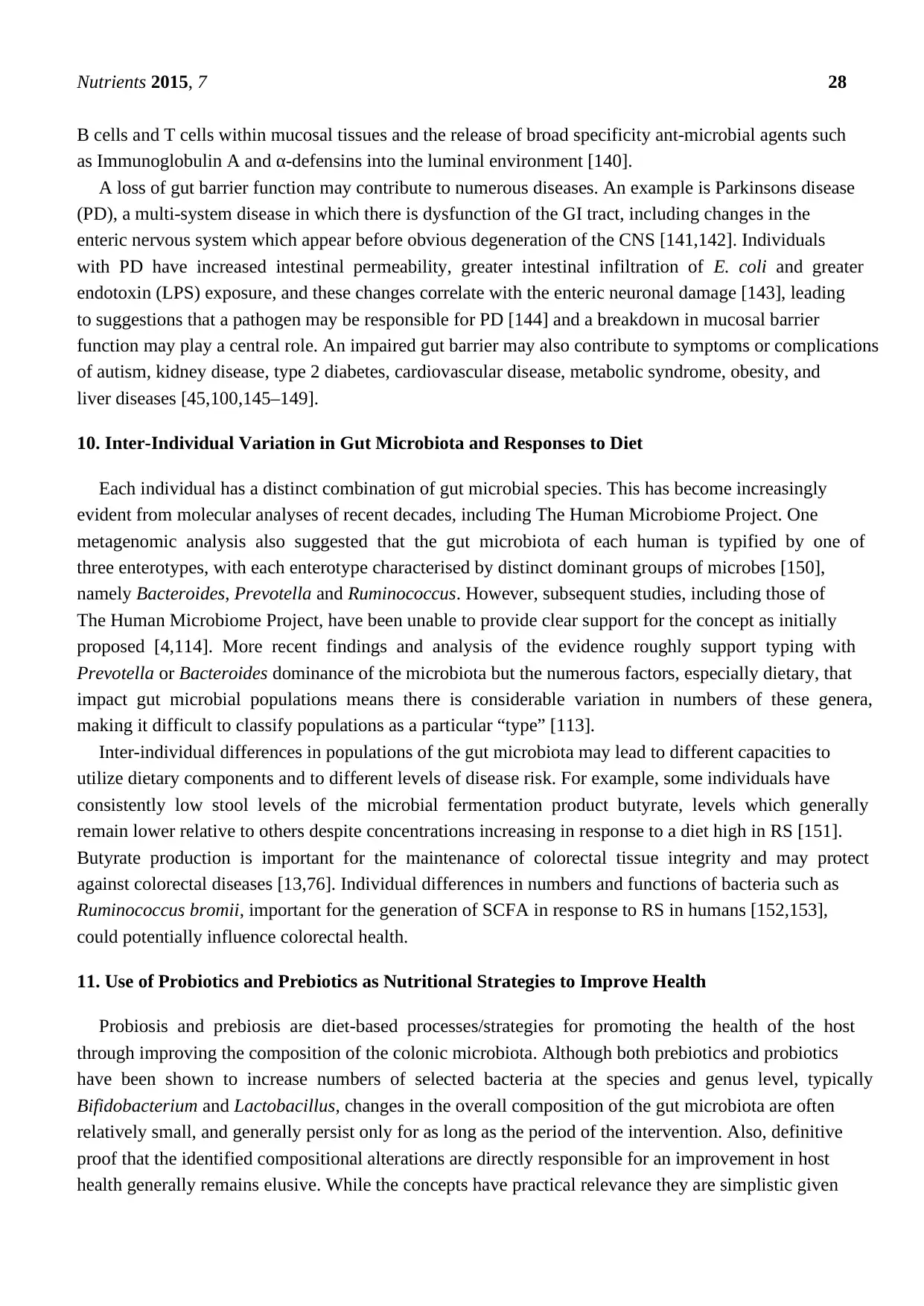
Nutrients 2015, 7 28
B cells and T cells within mucosal tissues and the release of broad specificity ant-microbial agents such
as Immunoglobulin A and α-defensins into the luminal environment [140].
A loss of gut barrier function may contribute to numerous diseases. An example is Parkinsons disease
(PD), a multi-system disease in which there is dysfunction of the GI tract, including changes in the
enteric nervous system which appear before obvious degeneration of the CNS [141,142]. Individuals
with PD have increased intestinal permeability, greater intestinal infiltration of E. coli and greater
endotoxin (LPS) exposure, and these changes correlate with the enteric neuronal damage [143], leading
to suggestions that a pathogen may be responsible for PD [144] and a breakdown in mucosal barrier
function may play a central role. An impaired gut barrier may also contribute to symptoms or complications
of autism, kidney disease, type 2 diabetes, cardiovascular disease, metabolic syndrome, obesity, and
liver diseases [45,100,145–149].
10. Inter-Individual Variation in Gut Microbiota and Responses to Diet
Each individual has a distinct combination of gut microbial species. This has become increasingly
evident from molecular analyses of recent decades, including The Human Microbiome Project. One
metagenomic analysis also suggested that the gut microbiota of each human is typified by one of
three enterotypes, with each enterotype characterised by distinct dominant groups of microbes [150],
namely Bacteroides, Prevotella and Ruminococcus. However, subsequent studies, including those of
The Human Microbiome Project, have been unable to provide clear support for the concept as initially
proposed [4,114]. More recent findings and analysis of the evidence roughly support typing with
Prevotella or Bacteroides dominance of the microbiota but the numerous factors, especially dietary, that
impact gut microbial populations means there is considerable variation in numbers of these genera,
making it difficult to classify populations as a particular “type” [113].
Inter-individual differences in populations of the gut microbiota may lead to different capacities to
utilize dietary components and to different levels of disease risk. For example, some individuals have
consistently low stool levels of the microbial fermentation product butyrate, levels which generally
remain lower relative to others despite concentrations increasing in response to a diet high in RS [151].
Butyrate production is important for the maintenance of colorectal tissue integrity and may protect
against colorectal diseases [13,76]. Individual differences in numbers and functions of bacteria such as
Ruminococcus bromii, important for the generation of SCFA in response to RS in humans [152,153],
could potentially influence colorectal health.
11. Use of Probiotics and Prebiotics as Nutritional Strategies to Improve Health
Probiosis and prebiosis are diet-based processes/strategies for promoting the health of the host
through improving the composition of the colonic microbiota. Although both prebiotics and probiotics
have been shown to increase numbers of selected bacteria at the species and genus level, typically
Bifidobacterium and Lactobacillus, changes in the overall composition of the gut microbiota are often
relatively small, and generally persist only for as long as the period of the intervention. Also, definitive
proof that the identified compositional alterations are directly responsible for an improvement in host
health generally remains elusive. While the concepts have practical relevance they are simplistic given
B cells and T cells within mucosal tissues and the release of broad specificity ant-microbial agents such
as Immunoglobulin A and α-defensins into the luminal environment [140].
A loss of gut barrier function may contribute to numerous diseases. An example is Parkinsons disease
(PD), a multi-system disease in which there is dysfunction of the GI tract, including changes in the
enteric nervous system which appear before obvious degeneration of the CNS [141,142]. Individuals
with PD have increased intestinal permeability, greater intestinal infiltration of E. coli and greater
endotoxin (LPS) exposure, and these changes correlate with the enteric neuronal damage [143], leading
to suggestions that a pathogen may be responsible for PD [144] and a breakdown in mucosal barrier
function may play a central role. An impaired gut barrier may also contribute to symptoms or complications
of autism, kidney disease, type 2 diabetes, cardiovascular disease, metabolic syndrome, obesity, and
liver diseases [45,100,145–149].
10. Inter-Individual Variation in Gut Microbiota and Responses to Diet
Each individual has a distinct combination of gut microbial species. This has become increasingly
evident from molecular analyses of recent decades, including The Human Microbiome Project. One
metagenomic analysis also suggested that the gut microbiota of each human is typified by one of
three enterotypes, with each enterotype characterised by distinct dominant groups of microbes [150],
namely Bacteroides, Prevotella and Ruminococcus. However, subsequent studies, including those of
The Human Microbiome Project, have been unable to provide clear support for the concept as initially
proposed [4,114]. More recent findings and analysis of the evidence roughly support typing with
Prevotella or Bacteroides dominance of the microbiota but the numerous factors, especially dietary, that
impact gut microbial populations means there is considerable variation in numbers of these genera,
making it difficult to classify populations as a particular “type” [113].
Inter-individual differences in populations of the gut microbiota may lead to different capacities to
utilize dietary components and to different levels of disease risk. For example, some individuals have
consistently low stool levels of the microbial fermentation product butyrate, levels which generally
remain lower relative to others despite concentrations increasing in response to a diet high in RS [151].
Butyrate production is important for the maintenance of colorectal tissue integrity and may protect
against colorectal diseases [13,76]. Individual differences in numbers and functions of bacteria such as
Ruminococcus bromii, important for the generation of SCFA in response to RS in humans [152,153],
could potentially influence colorectal health.
11. Use of Probiotics and Prebiotics as Nutritional Strategies to Improve Health
Probiosis and prebiosis are diet-based processes/strategies for promoting the health of the host
through improving the composition of the colonic microbiota. Although both prebiotics and probiotics
have been shown to increase numbers of selected bacteria at the species and genus level, typically
Bifidobacterium and Lactobacillus, changes in the overall composition of the gut microbiota are often
relatively small, and generally persist only for as long as the period of the intervention. Also, definitive
proof that the identified compositional alterations are directly responsible for an improvement in host
health generally remains elusive. While the concepts have practical relevance they are simplistic given
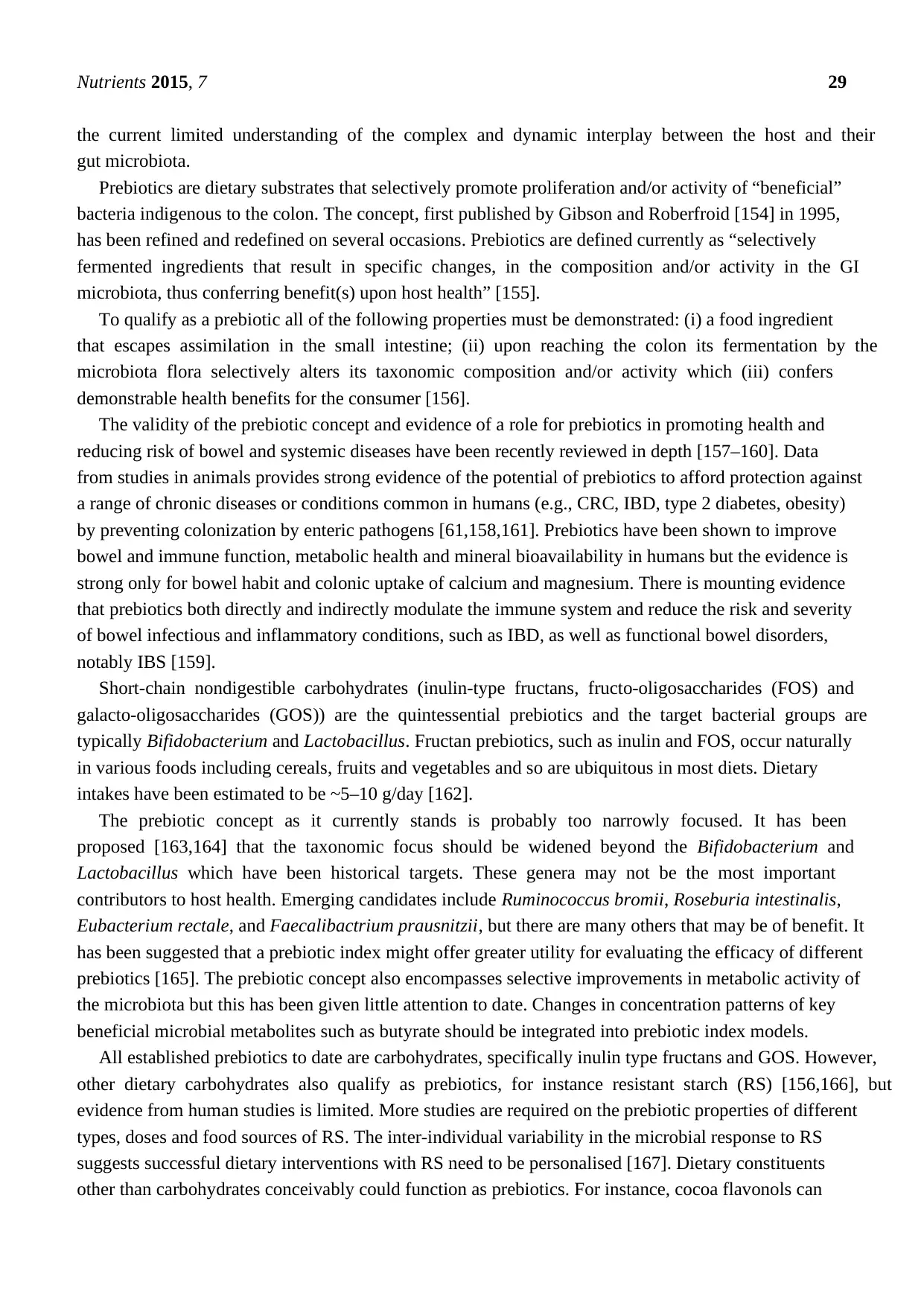
Nutrients 2015, 7 29
the current limited understanding of the complex and dynamic interplay between the host and their
gut microbiota.
Prebiotics are dietary substrates that selectively promote proliferation and/or activity of “beneficial”
bacteria indigenous to the colon. The concept, first published by Gibson and Roberfroid [154] in 1995,
has been refined and redefined on several occasions. Prebiotics are defined currently as “selectively
fermented ingredients that result in specific changes, in the composition and/or activity in the GI
microbiota, thus conferring benefit(s) upon host health” [155].
To qualify as a prebiotic all of the following properties must be demonstrated: (i) a food ingredient
that escapes assimilation in the small intestine; (ii) upon reaching the colon its fermentation by the
microbiota flora selectively alters its taxonomic composition and/or activity which (iii) confers
demonstrable health benefits for the consumer [156].
The validity of the prebiotic concept and evidence of a role for prebiotics in promoting health and
reducing risk of bowel and systemic diseases have been recently reviewed in depth [157–160]. Data
from studies in animals provides strong evidence of the potential of prebiotics to afford protection against
a range of chronic diseases or conditions common in humans (e.g., CRC, IBD, type 2 diabetes, obesity)
by preventing colonization by enteric pathogens [61,158,161]. Prebiotics have been shown to improve
bowel and immune function, metabolic health and mineral bioavailability in humans but the evidence is
strong only for bowel habit and colonic uptake of calcium and magnesium. There is mounting evidence
that prebiotics both directly and indirectly modulate the immune system and reduce the risk and severity
of bowel infectious and inflammatory conditions, such as IBD, as well as functional bowel disorders,
notably IBS [159].
Short-chain nondigestible carbohydrates (inulin-type fructans, fructo-oligosaccharides (FOS) and
galacto-oligosaccharides (GOS)) are the quintessential prebiotics and the target bacterial groups are
typically Bifidobacterium and Lactobacillus. Fructan prebiotics, such as inulin and FOS, occur naturally
in various foods including cereals, fruits and vegetables and so are ubiquitous in most diets. Dietary
intakes have been estimated to be ~5–10 g/day [162].
The prebiotic concept as it currently stands is probably too narrowly focused. It has been
proposed [163,164] that the taxonomic focus should be widened beyond the Bifidobacterium and
Lactobacillus which have been historical targets. These genera may not be the most important
contributors to host health. Emerging candidates include Ruminococcus bromii, Roseburia intestinalis,
Eubacterium rectale, and Faecalibactrium prausnitzii, but there are many others that may be of benefit. It
has been suggested that a prebiotic index might offer greater utility for evaluating the efficacy of different
prebiotics [165]. The prebiotic concept also encompasses selective improvements in metabolic activity of
the microbiota but this has been given little attention to date. Changes in concentration patterns of key
beneficial microbial metabolites such as butyrate should be integrated into prebiotic index models.
All established prebiotics to date are carbohydrates, specifically inulin type fructans and GOS. However,
other dietary carbohydrates also qualify as prebiotics, for instance resistant starch (RS) [156,166], but
evidence from human studies is limited. More studies are required on the prebiotic properties of different
types, doses and food sources of RS. The inter-individual variability in the microbial response to RS
suggests successful dietary interventions with RS need to be personalised [167]. Dietary constituents
other than carbohydrates conceivably could function as prebiotics. For instance, cocoa flavonols can
the current limited understanding of the complex and dynamic interplay between the host and their
gut microbiota.
Prebiotics are dietary substrates that selectively promote proliferation and/or activity of “beneficial”
bacteria indigenous to the colon. The concept, first published by Gibson and Roberfroid [154] in 1995,
has been refined and redefined on several occasions. Prebiotics are defined currently as “selectively
fermented ingredients that result in specific changes, in the composition and/or activity in the GI
microbiota, thus conferring benefit(s) upon host health” [155].
To qualify as a prebiotic all of the following properties must be demonstrated: (i) a food ingredient
that escapes assimilation in the small intestine; (ii) upon reaching the colon its fermentation by the
microbiota flora selectively alters its taxonomic composition and/or activity which (iii) confers
demonstrable health benefits for the consumer [156].
The validity of the prebiotic concept and evidence of a role for prebiotics in promoting health and
reducing risk of bowel and systemic diseases have been recently reviewed in depth [157–160]. Data
from studies in animals provides strong evidence of the potential of prebiotics to afford protection against
a range of chronic diseases or conditions common in humans (e.g., CRC, IBD, type 2 diabetes, obesity)
by preventing colonization by enteric pathogens [61,158,161]. Prebiotics have been shown to improve
bowel and immune function, metabolic health and mineral bioavailability in humans but the evidence is
strong only for bowel habit and colonic uptake of calcium and magnesium. There is mounting evidence
that prebiotics both directly and indirectly modulate the immune system and reduce the risk and severity
of bowel infectious and inflammatory conditions, such as IBD, as well as functional bowel disorders,
notably IBS [159].
Short-chain nondigestible carbohydrates (inulin-type fructans, fructo-oligosaccharides (FOS) and
galacto-oligosaccharides (GOS)) are the quintessential prebiotics and the target bacterial groups are
typically Bifidobacterium and Lactobacillus. Fructan prebiotics, such as inulin and FOS, occur naturally
in various foods including cereals, fruits and vegetables and so are ubiquitous in most diets. Dietary
intakes have been estimated to be ~5–10 g/day [162].
The prebiotic concept as it currently stands is probably too narrowly focused. It has been
proposed [163,164] that the taxonomic focus should be widened beyond the Bifidobacterium and
Lactobacillus which have been historical targets. These genera may not be the most important
contributors to host health. Emerging candidates include Ruminococcus bromii, Roseburia intestinalis,
Eubacterium rectale, and Faecalibactrium prausnitzii, but there are many others that may be of benefit. It
has been suggested that a prebiotic index might offer greater utility for evaluating the efficacy of different
prebiotics [165]. The prebiotic concept also encompasses selective improvements in metabolic activity of
the microbiota but this has been given little attention to date. Changes in concentration patterns of key
beneficial microbial metabolites such as butyrate should be integrated into prebiotic index models.
All established prebiotics to date are carbohydrates, specifically inulin type fructans and GOS. However,
other dietary carbohydrates also qualify as prebiotics, for instance resistant starch (RS) [156,166], but
evidence from human studies is limited. More studies are required on the prebiotic properties of different
types, doses and food sources of RS. The inter-individual variability in the microbial response to RS
suggests successful dietary interventions with RS need to be personalised [167]. Dietary constituents
other than carbohydrates conceivably could function as prebiotics. For instance, cocoa flavonols can
Paraphrase This Document
Need a fresh take? Get an instant paraphrase of this document with our AI Paraphraser
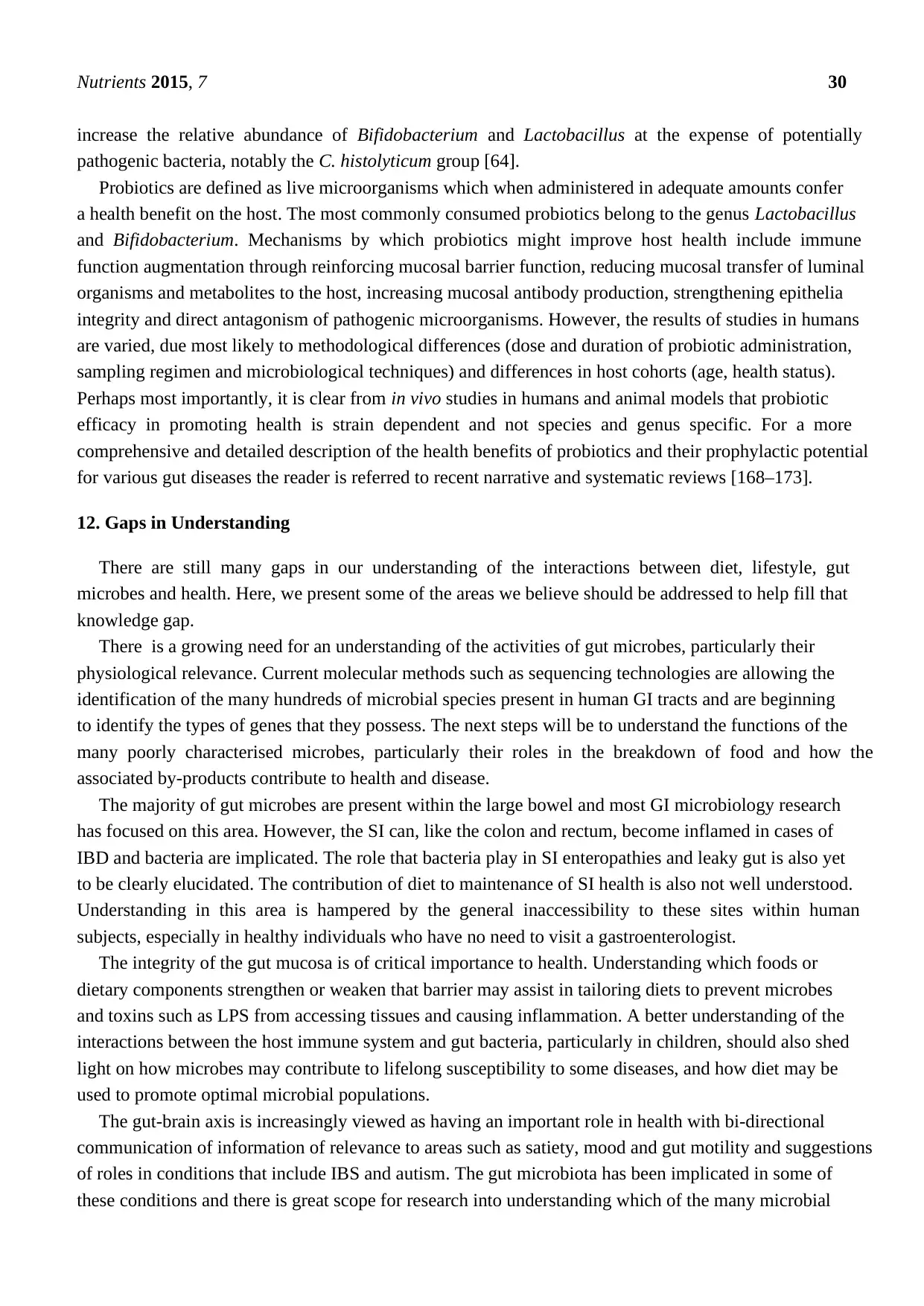
Nutrients 2015, 7 30
increase the relative abundance of Bifidobacterium and Lactobacillus at the expense of potentially
pathogenic bacteria, notably the C. histolyticum group [64].
Probiotics are defined as live microorganisms which when administered in adequate amounts confer
a health benefit on the host. The most commonly consumed probiotics belong to the genus Lactobacillus
and Bifidobacterium. Mechanisms by which probiotics might improve host health include immune
function augmentation through reinforcing mucosal barrier function, reducing mucosal transfer of luminal
organisms and metabolites to the host, increasing mucosal antibody production, strengthening epithelia
integrity and direct antagonism of pathogenic microorganisms. However, the results of studies in humans
are varied, due most likely to methodological differences (dose and duration of probiotic administration,
sampling regimen and microbiological techniques) and differences in host cohorts (age, health status).
Perhaps most importantly, it is clear from in vivo studies in humans and animal models that probiotic
efficacy in promoting health is strain dependent and not species and genus specific. For a more
comprehensive and detailed description of the health benefits of probiotics and their prophylactic potential
for various gut diseases the reader is referred to recent narrative and systematic reviews [168–173].
12. Gaps in Understanding
There are still many gaps in our understanding of the interactions between diet, lifestyle, gut
microbes and health. Here, we present some of the areas we believe should be addressed to help fill that
knowledge gap.
There is a growing need for an understanding of the activities of gut microbes, particularly their
physiological relevance. Current molecular methods such as sequencing technologies are allowing the
identification of the many hundreds of microbial species present in human GI tracts and are beginning
to identify the types of genes that they possess. The next steps will be to understand the functions of the
many poorly characterised microbes, particularly their roles in the breakdown of food and how the
associated by-products contribute to health and disease.
The majority of gut microbes are present within the large bowel and most GI microbiology research
has focused on this area. However, the SI can, like the colon and rectum, become inflamed in cases of
IBD and bacteria are implicated. The role that bacteria play in SI enteropathies and leaky gut is also yet
to be clearly elucidated. The contribution of diet to maintenance of SI health is also not well understood.
Understanding in this area is hampered by the general inaccessibility to these sites within human
subjects, especially in healthy individuals who have no need to visit a gastroenterologist.
The integrity of the gut mucosa is of critical importance to health. Understanding which foods or
dietary components strengthen or weaken that barrier may assist in tailoring diets to prevent microbes
and toxins such as LPS from accessing tissues and causing inflammation. A better understanding of the
interactions between the host immune system and gut bacteria, particularly in children, should also shed
light on how microbes may contribute to lifelong susceptibility to some diseases, and how diet may be
used to promote optimal microbial populations.
The gut-brain axis is increasingly viewed as having an important role in health with bi-directional
communication of information of relevance to areas such as satiety, mood and gut motility and suggestions
of roles in conditions that include IBS and autism. The gut microbiota has been implicated in some of
these conditions and there is great scope for research into understanding which of the many microbial
increase the relative abundance of Bifidobacterium and Lactobacillus at the expense of potentially
pathogenic bacteria, notably the C. histolyticum group [64].
Probiotics are defined as live microorganisms which when administered in adequate amounts confer
a health benefit on the host. The most commonly consumed probiotics belong to the genus Lactobacillus
and Bifidobacterium. Mechanisms by which probiotics might improve host health include immune
function augmentation through reinforcing mucosal barrier function, reducing mucosal transfer of luminal
organisms and metabolites to the host, increasing mucosal antibody production, strengthening epithelia
integrity and direct antagonism of pathogenic microorganisms. However, the results of studies in humans
are varied, due most likely to methodological differences (dose and duration of probiotic administration,
sampling regimen and microbiological techniques) and differences in host cohorts (age, health status).
Perhaps most importantly, it is clear from in vivo studies in humans and animal models that probiotic
efficacy in promoting health is strain dependent and not species and genus specific. For a more
comprehensive and detailed description of the health benefits of probiotics and their prophylactic potential
for various gut diseases the reader is referred to recent narrative and systematic reviews [168–173].
12. Gaps in Understanding
There are still many gaps in our understanding of the interactions between diet, lifestyle, gut
microbes and health. Here, we present some of the areas we believe should be addressed to help fill that
knowledge gap.
There is a growing need for an understanding of the activities of gut microbes, particularly their
physiological relevance. Current molecular methods such as sequencing technologies are allowing the
identification of the many hundreds of microbial species present in human GI tracts and are beginning
to identify the types of genes that they possess. The next steps will be to understand the functions of the
many poorly characterised microbes, particularly their roles in the breakdown of food and how the
associated by-products contribute to health and disease.
The majority of gut microbes are present within the large bowel and most GI microbiology research
has focused on this area. However, the SI can, like the colon and rectum, become inflamed in cases of
IBD and bacteria are implicated. The role that bacteria play in SI enteropathies and leaky gut is also yet
to be clearly elucidated. The contribution of diet to maintenance of SI health is also not well understood.
Understanding in this area is hampered by the general inaccessibility to these sites within human
subjects, especially in healthy individuals who have no need to visit a gastroenterologist.
The integrity of the gut mucosa is of critical importance to health. Understanding which foods or
dietary components strengthen or weaken that barrier may assist in tailoring diets to prevent microbes
and toxins such as LPS from accessing tissues and causing inflammation. A better understanding of the
interactions between the host immune system and gut bacteria, particularly in children, should also shed
light on how microbes may contribute to lifelong susceptibility to some diseases, and how diet may be
used to promote optimal microbial populations.
The gut-brain axis is increasingly viewed as having an important role in health with bi-directional
communication of information of relevance to areas such as satiety, mood and gut motility and suggestions
of roles in conditions that include IBS and autism. The gut microbiota has been implicated in some of
these conditions and there is great scope for research into understanding which of the many microbial
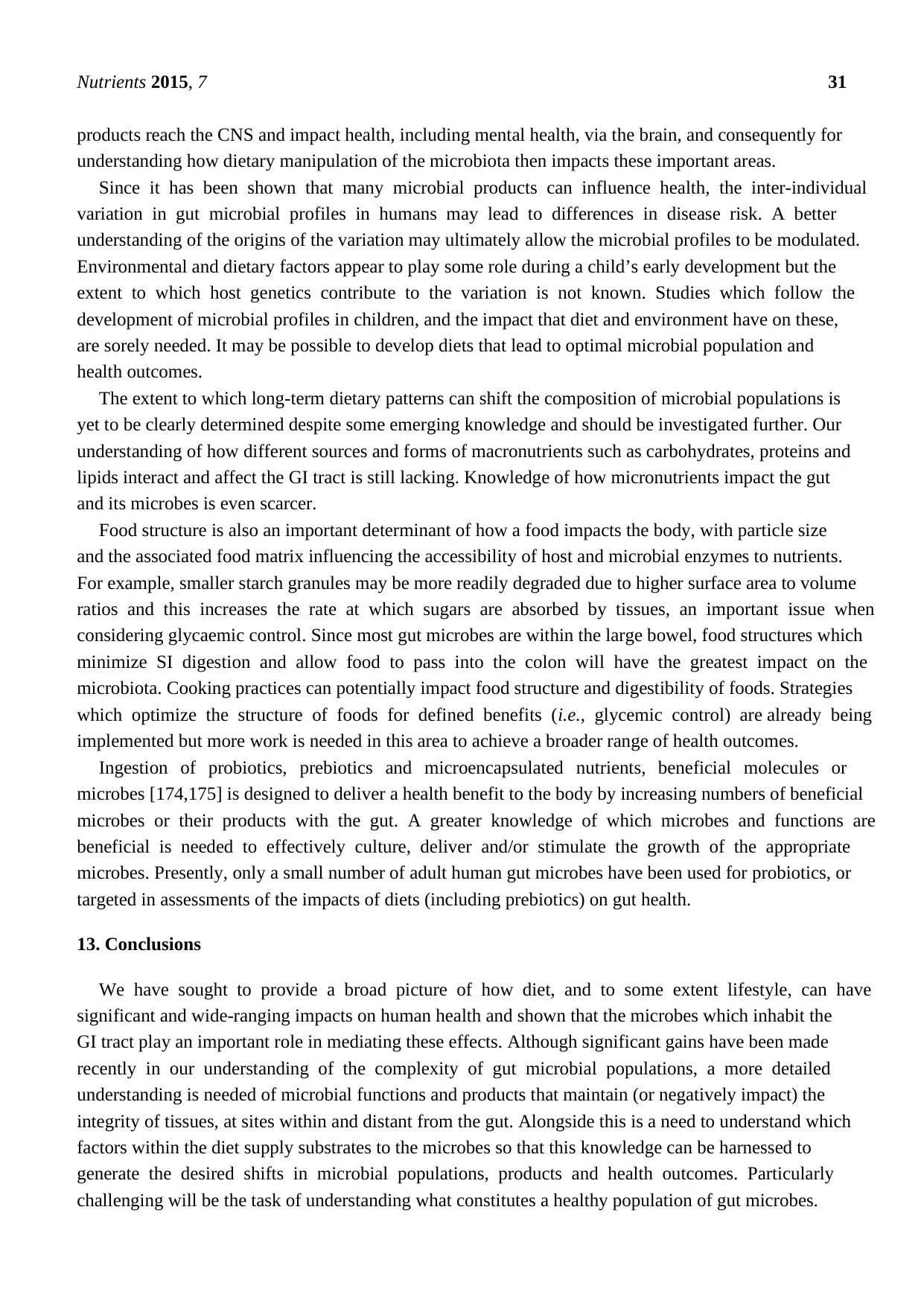
Nutrients 2015, 7 31
products reach the CNS and impact health, including mental health, via the brain, and consequently for
understanding how dietary manipulation of the microbiota then impacts these important areas.
Since it has been shown that many microbial products can influence health, the inter-individual
variation in gut microbial profiles in humans may lead to differences in disease risk. A better
understanding of the origins of the variation may ultimately allow the microbial profiles to be modulated.
Environmental and dietary factors appear to play some role during a child’s early development but the
extent to which host genetics contribute to the variation is not known. Studies which follow the
development of microbial profiles in children, and the impact that diet and environment have on these,
are sorely needed. It may be possible to develop diets that lead to optimal microbial population and
health outcomes.
The extent to which long-term dietary patterns can shift the composition of microbial populations is
yet to be clearly determined despite some emerging knowledge and should be investigated further. Our
understanding of how different sources and forms of macronutrients such as carbohydrates, proteins and
lipids interact and affect the GI tract is still lacking. Knowledge of how micronutrients impact the gut
and its microbes is even scarcer.
Food structure is also an important determinant of how a food impacts the body, with particle size
and the associated food matrix influencing the accessibility of host and microbial enzymes to nutrients.
For example, smaller starch granules may be more readily degraded due to higher surface area to volume
ratios and this increases the rate at which sugars are absorbed by tissues, an important issue when
considering glycaemic control. Since most gut microbes are within the large bowel, food structures which
minimize SI digestion and allow food to pass into the colon will have the greatest impact on the
microbiota. Cooking practices can potentially impact food structure and digestibility of foods. Strategies
which optimize the structure of foods for defined benefits (i.e., glycemic control) are already being
implemented but more work is needed in this area to achieve a broader range of health outcomes.
Ingestion of probiotics, prebiotics and microencapsulated nutrients, beneficial molecules or
microbes [174,175] is designed to deliver a health benefit to the body by increasing numbers of beneficial
microbes or their products with the gut. A greater knowledge of which microbes and functions are
beneficial is needed to effectively culture, deliver and/or stimulate the growth of the appropriate
microbes. Presently, only a small number of adult human gut microbes have been used for probiotics, or
targeted in assessments of the impacts of diets (including prebiotics) on gut health.
13. Conclusions
We have sought to provide a broad picture of how diet, and to some extent lifestyle, can have
significant and wide-ranging impacts on human health and shown that the microbes which inhabit the
GI tract play an important role in mediating these effects. Although significant gains have been made
recently in our understanding of the complexity of gut microbial populations, a more detailed
understanding is needed of microbial functions and products that maintain (or negatively impact) the
integrity of tissues, at sites within and distant from the gut. Alongside this is a need to understand which
factors within the diet supply substrates to the microbes so that this knowledge can be harnessed to
generate the desired shifts in microbial populations, products and health outcomes. Particularly
challenging will be the task of understanding what constitutes a healthy population of gut microbes.
products reach the CNS and impact health, including mental health, via the brain, and consequently for
understanding how dietary manipulation of the microbiota then impacts these important areas.
Since it has been shown that many microbial products can influence health, the inter-individual
variation in gut microbial profiles in humans may lead to differences in disease risk. A better
understanding of the origins of the variation may ultimately allow the microbial profiles to be modulated.
Environmental and dietary factors appear to play some role during a child’s early development but the
extent to which host genetics contribute to the variation is not known. Studies which follow the
development of microbial profiles in children, and the impact that diet and environment have on these,
are sorely needed. It may be possible to develop diets that lead to optimal microbial population and
health outcomes.
The extent to which long-term dietary patterns can shift the composition of microbial populations is
yet to be clearly determined despite some emerging knowledge and should be investigated further. Our
understanding of how different sources and forms of macronutrients such as carbohydrates, proteins and
lipids interact and affect the GI tract is still lacking. Knowledge of how micronutrients impact the gut
and its microbes is even scarcer.
Food structure is also an important determinant of how a food impacts the body, with particle size
and the associated food matrix influencing the accessibility of host and microbial enzymes to nutrients.
For example, smaller starch granules may be more readily degraded due to higher surface area to volume
ratios and this increases the rate at which sugars are absorbed by tissues, an important issue when
considering glycaemic control. Since most gut microbes are within the large bowel, food structures which
minimize SI digestion and allow food to pass into the colon will have the greatest impact on the
microbiota. Cooking practices can potentially impact food structure and digestibility of foods. Strategies
which optimize the structure of foods for defined benefits (i.e., glycemic control) are already being
implemented but more work is needed in this area to achieve a broader range of health outcomes.
Ingestion of probiotics, prebiotics and microencapsulated nutrients, beneficial molecules or
microbes [174,175] is designed to deliver a health benefit to the body by increasing numbers of beneficial
microbes or their products with the gut. A greater knowledge of which microbes and functions are
beneficial is needed to effectively culture, deliver and/or stimulate the growth of the appropriate
microbes. Presently, only a small number of adult human gut microbes have been used for probiotics, or
targeted in assessments of the impacts of diets (including prebiotics) on gut health.
13. Conclusions
We have sought to provide a broad picture of how diet, and to some extent lifestyle, can have
significant and wide-ranging impacts on human health and shown that the microbes which inhabit the
GI tract play an important role in mediating these effects. Although significant gains have been made
recently in our understanding of the complexity of gut microbial populations, a more detailed
understanding is needed of microbial functions and products that maintain (or negatively impact) the
integrity of tissues, at sites within and distant from the gut. Alongside this is a need to understand which
factors within the diet supply substrates to the microbes so that this knowledge can be harnessed to
generate the desired shifts in microbial populations, products and health outcomes. Particularly
challenging will be the task of understanding what constitutes a healthy population of gut microbes.
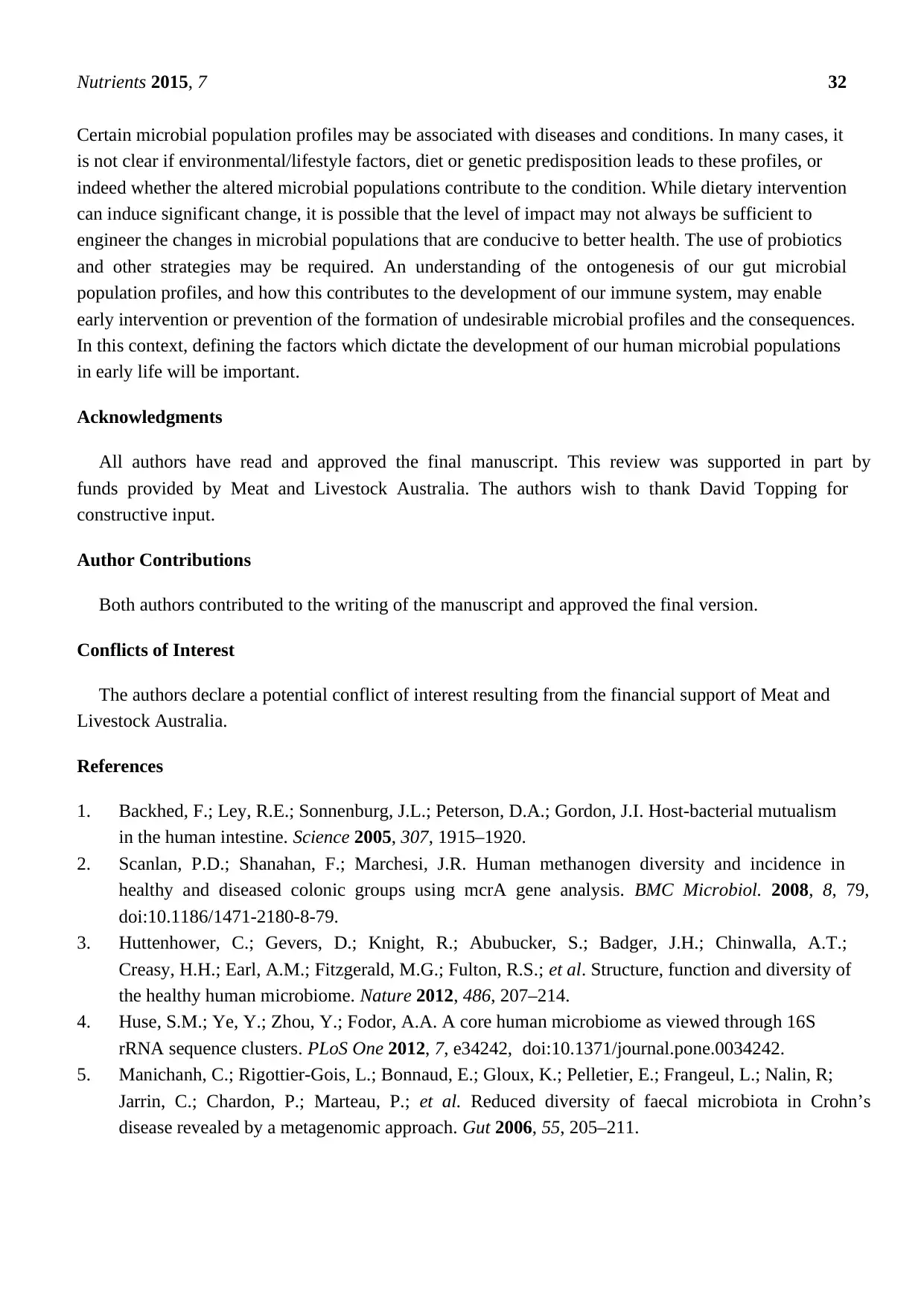
Nutrients 2015, 7 32
Certain microbial population profiles may be associated with diseases and conditions. In many cases, it
is not clear if environmental/lifestyle factors, diet or genetic predisposition leads to these profiles, or
indeed whether the altered microbial populations contribute to the condition. While dietary intervention
can induce significant change, it is possible that the level of impact may not always be sufficient to
engineer the changes in microbial populations that are conducive to better health. The use of probiotics
and other strategies may be required. An understanding of the ontogenesis of our gut microbial
population profiles, and how this contributes to the development of our immune system, may enable
early intervention or prevention of the formation of undesirable microbial profiles and the consequences.
In this context, defining the factors which dictate the development of our human microbial populations
in early life will be important.
Acknowledgments
All authors have read and approved the final manuscript. This review was supported in part by
funds provided by Meat and Livestock Australia. The authors wish to thank David Topping for
constructive input.
Author Contributions
Both authors contributed to the writing of the manuscript and approved the final version.
Conflicts of Interest
The authors declare a potential conflict of interest resulting from the financial support of Meat and
Livestock Australia.
References
1. Backhed, F.; Ley, R.E.; Sonnenburg, J.L.; Peterson, D.A.; Gordon, J.I. Host-bacterial mutualism
in the human intestine. Science 2005, 307, 1915–1920.
2. Scanlan, P.D.; Shanahan, F.; Marchesi, J.R. Human methanogen diversity and incidence in
healthy and diseased colonic groups using mcrA gene analysis. BMC Microbiol. 2008, 8, 79,
doi:10.1186/1471-2180-8-79.
3. Huttenhower, C.; Gevers, D.; Knight, R.; Abubucker, S.; Badger, J.H.; Chinwalla, A.T.;
Creasy, H.H.; Earl, A.M.; Fitzgerald, M.G.; Fulton, R.S.; et al. Structure, function and diversity of
the healthy human microbiome. Nature 2012, 486, 207–214.
4. Huse, S.M.; Ye, Y.; Zhou, Y.; Fodor, A.A. A core human microbiome as viewed through 16S
rRNA sequence clusters. PLoS One 2012, 7, e34242, doi:10.1371/journal.pone.0034242.
5. Manichanh, C.; Rigottier-Gois, L.; Bonnaud, E.; Gloux, K.; Pelletier, E.; Frangeul, L.; Nalin, R;
Jarrin, C.; Chardon, P.; Marteau, P.; et al. Reduced diversity of faecal microbiota in Crohn’s
disease revealed by a metagenomic approach. Gut 2006, 55, 205–211.
Certain microbial population profiles may be associated with diseases and conditions. In many cases, it
is not clear if environmental/lifestyle factors, diet or genetic predisposition leads to these profiles, or
indeed whether the altered microbial populations contribute to the condition. While dietary intervention
can induce significant change, it is possible that the level of impact may not always be sufficient to
engineer the changes in microbial populations that are conducive to better health. The use of probiotics
and other strategies may be required. An understanding of the ontogenesis of our gut microbial
population profiles, and how this contributes to the development of our immune system, may enable
early intervention or prevention of the formation of undesirable microbial profiles and the consequences.
In this context, defining the factors which dictate the development of our human microbial populations
in early life will be important.
Acknowledgments
All authors have read and approved the final manuscript. This review was supported in part by
funds provided by Meat and Livestock Australia. The authors wish to thank David Topping for
constructive input.
Author Contributions
Both authors contributed to the writing of the manuscript and approved the final version.
Conflicts of Interest
The authors declare a potential conflict of interest resulting from the financial support of Meat and
Livestock Australia.
References
1. Backhed, F.; Ley, R.E.; Sonnenburg, J.L.; Peterson, D.A.; Gordon, J.I. Host-bacterial mutualism
in the human intestine. Science 2005, 307, 1915–1920.
2. Scanlan, P.D.; Shanahan, F.; Marchesi, J.R. Human methanogen diversity and incidence in
healthy and diseased colonic groups using mcrA gene analysis. BMC Microbiol. 2008, 8, 79,
doi:10.1186/1471-2180-8-79.
3. Huttenhower, C.; Gevers, D.; Knight, R.; Abubucker, S.; Badger, J.H.; Chinwalla, A.T.;
Creasy, H.H.; Earl, A.M.; Fitzgerald, M.G.; Fulton, R.S.; et al. Structure, function and diversity of
the healthy human microbiome. Nature 2012, 486, 207–214.
4. Huse, S.M.; Ye, Y.; Zhou, Y.; Fodor, A.A. A core human microbiome as viewed through 16S
rRNA sequence clusters. PLoS One 2012, 7, e34242, doi:10.1371/journal.pone.0034242.
5. Manichanh, C.; Rigottier-Gois, L.; Bonnaud, E.; Gloux, K.; Pelletier, E.; Frangeul, L.; Nalin, R;
Jarrin, C.; Chardon, P.; Marteau, P.; et al. Reduced diversity of faecal microbiota in Crohn’s
disease revealed by a metagenomic approach. Gut 2006, 55, 205–211.
Secure Best Marks with AI Grader
Need help grading? Try our AI Grader for instant feedback on your assignments.
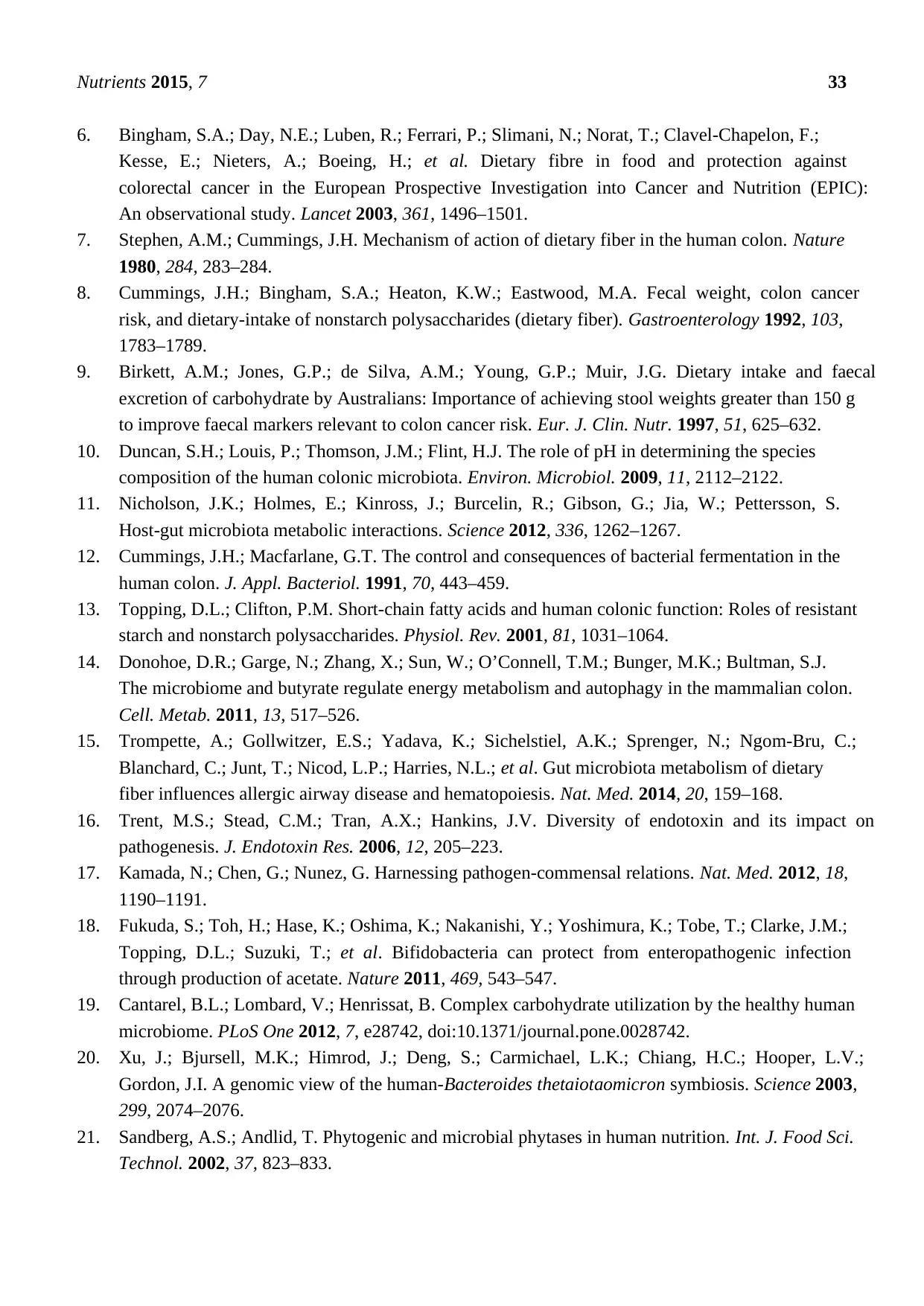
Nutrients 2015, 7 33
6. Bingham, S.A.; Day, N.E.; Luben, R.; Ferrari, P.; Slimani, N.; Norat, T.; Clavel-Chapelon, F.;
Kesse, E.; Nieters, A.; Boeing, H.; et al. Dietary fibre in food and protection against
colorectal cancer in the European Prospective Investigation into Cancer and Nutrition (EPIC):
An observational study. Lancet 2003, 361, 1496–1501.
7. Stephen, A.M.; Cummings, J.H. Mechanism of action of dietary fiber in the human colon. Nature
1980, 284, 283–284.
8. Cummings, J.H.; Bingham, S.A.; Heaton, K.W.; Eastwood, M.A. Fecal weight, colon cancer
risk, and dietary-intake of nonstarch polysaccharides (dietary fiber). Gastroenterology 1992, 103,
1783–1789.
9. Birkett, A.M.; Jones, G.P.; de Silva, A.M.; Young, G.P.; Muir, J.G. Dietary intake and faecal
excretion of carbohydrate by Australians: Importance of achieving stool weights greater than 150 g
to improve faecal markers relevant to colon cancer risk. Eur. J. Clin. Nutr. 1997, 51, 625–632.
10. Duncan, S.H.; Louis, P.; Thomson, J.M.; Flint, H.J. The role of pH in determining the species
composition of the human colonic microbiota. Environ. Microbiol. 2009, 11, 2112–2122.
11. Nicholson, J.K.; Holmes, E.; Kinross, J.; Burcelin, R.; Gibson, G.; Jia, W.; Pettersson, S.
Host-gut microbiota metabolic interactions. Science 2012, 336, 1262–1267.
12. Cummings, J.H.; Macfarlane, G.T. The control and consequences of bacterial fermentation in the
human colon. J. Appl. Bacteriol. 1991, 70, 443–459.
13. Topping, D.L.; Clifton, P.M. Short-chain fatty acids and human colonic function: Roles of resistant
starch and nonstarch polysaccharides. Physiol. Rev. 2001, 81, 1031–1064.
14. Donohoe, D.R.; Garge, N.; Zhang, X.; Sun, W.; O’Connell, T.M.; Bunger, M.K.; Bultman, S.J.
The microbiome and butyrate regulate energy metabolism and autophagy in the mammalian colon.
Cell. Metab. 2011, 13, 517–526.
15. Trompette, A.; Gollwitzer, E.S.; Yadava, K.; Sichelstiel, A.K.; Sprenger, N.; Ngom-Bru, C.;
Blanchard, C.; Junt, T.; Nicod, L.P.; Harries, N.L.; et al. Gut microbiota metabolism of dietary
fiber influences allergic airway disease and hematopoiesis. Nat. Med. 2014, 20, 159–168.
16. Trent, M.S.; Stead, C.M.; Tran, A.X.; Hankins, J.V. Diversity of endotoxin and its impact on
pathogenesis. J. Endotoxin Res. 2006, 12, 205–223.
17. Kamada, N.; Chen, G.; Nunez, G. Harnessing pathogen-commensal relations. Nat. Med. 2012, 18,
1190–1191.
18. Fukuda, S.; Toh, H.; Hase, K.; Oshima, K.; Nakanishi, Y.; Yoshimura, K.; Tobe, T.; Clarke, J.M.;
Topping, D.L.; Suzuki, T.; et al. Bifidobacteria can protect from enteropathogenic infection
through production of acetate. Nature 2011, 469, 543–547.
19. Cantarel, B.L.; Lombard, V.; Henrissat, B. Complex carbohydrate utilization by the healthy human
microbiome. PLoS One 2012, 7, e28742, doi:10.1371/journal.pone.0028742.
20. Xu, J.; Bjursell, M.K.; Himrod, J.; Deng, S.; Carmichael, L.K.; Chiang, H.C.; Hooper, L.V.;
Gordon, J.I. A genomic view of the human-Bacteroides thetaiotaomicron symbiosis. Science 2003,
299, 2074–2076.
21. Sandberg, A.S.; Andlid, T. Phytogenic and microbial phytases in human nutrition. Int. J. Food Sci.
Technol. 2002, 37, 823–833.
6. Bingham, S.A.; Day, N.E.; Luben, R.; Ferrari, P.; Slimani, N.; Norat, T.; Clavel-Chapelon, F.;
Kesse, E.; Nieters, A.; Boeing, H.; et al. Dietary fibre in food and protection against
colorectal cancer in the European Prospective Investigation into Cancer and Nutrition (EPIC):
An observational study. Lancet 2003, 361, 1496–1501.
7. Stephen, A.M.; Cummings, J.H. Mechanism of action of dietary fiber in the human colon. Nature
1980, 284, 283–284.
8. Cummings, J.H.; Bingham, S.A.; Heaton, K.W.; Eastwood, M.A. Fecal weight, colon cancer
risk, and dietary-intake of nonstarch polysaccharides (dietary fiber). Gastroenterology 1992, 103,
1783–1789.
9. Birkett, A.M.; Jones, G.P.; de Silva, A.M.; Young, G.P.; Muir, J.G. Dietary intake and faecal
excretion of carbohydrate by Australians: Importance of achieving stool weights greater than 150 g
to improve faecal markers relevant to colon cancer risk. Eur. J. Clin. Nutr. 1997, 51, 625–632.
10. Duncan, S.H.; Louis, P.; Thomson, J.M.; Flint, H.J. The role of pH in determining the species
composition of the human colonic microbiota. Environ. Microbiol. 2009, 11, 2112–2122.
11. Nicholson, J.K.; Holmes, E.; Kinross, J.; Burcelin, R.; Gibson, G.; Jia, W.; Pettersson, S.
Host-gut microbiota metabolic interactions. Science 2012, 336, 1262–1267.
12. Cummings, J.H.; Macfarlane, G.T. The control and consequences of bacterial fermentation in the
human colon. J. Appl. Bacteriol. 1991, 70, 443–459.
13. Topping, D.L.; Clifton, P.M. Short-chain fatty acids and human colonic function: Roles of resistant
starch and nonstarch polysaccharides. Physiol. Rev. 2001, 81, 1031–1064.
14. Donohoe, D.R.; Garge, N.; Zhang, X.; Sun, W.; O’Connell, T.M.; Bunger, M.K.; Bultman, S.J.
The microbiome and butyrate regulate energy metabolism and autophagy in the mammalian colon.
Cell. Metab. 2011, 13, 517–526.
15. Trompette, A.; Gollwitzer, E.S.; Yadava, K.; Sichelstiel, A.K.; Sprenger, N.; Ngom-Bru, C.;
Blanchard, C.; Junt, T.; Nicod, L.P.; Harries, N.L.; et al. Gut microbiota metabolism of dietary
fiber influences allergic airway disease and hematopoiesis. Nat. Med. 2014, 20, 159–168.
16. Trent, M.S.; Stead, C.M.; Tran, A.X.; Hankins, J.V. Diversity of endotoxin and its impact on
pathogenesis. J. Endotoxin Res. 2006, 12, 205–223.
17. Kamada, N.; Chen, G.; Nunez, G. Harnessing pathogen-commensal relations. Nat. Med. 2012, 18,
1190–1191.
18. Fukuda, S.; Toh, H.; Hase, K.; Oshima, K.; Nakanishi, Y.; Yoshimura, K.; Tobe, T.; Clarke, J.M.;
Topping, D.L.; Suzuki, T.; et al. Bifidobacteria can protect from enteropathogenic infection
through production of acetate. Nature 2011, 469, 543–547.
19. Cantarel, B.L.; Lombard, V.; Henrissat, B. Complex carbohydrate utilization by the healthy human
microbiome. PLoS One 2012, 7, e28742, doi:10.1371/journal.pone.0028742.
20. Xu, J.; Bjursell, M.K.; Himrod, J.; Deng, S.; Carmichael, L.K.; Chiang, H.C.; Hooper, L.V.;
Gordon, J.I. A genomic view of the human-Bacteroides thetaiotaomicron symbiosis. Science 2003,
299, 2074–2076.
21. Sandberg, A.S.; Andlid, T. Phytogenic and microbial phytases in human nutrition. Int. J. Food Sci.
Technol. 2002, 37, 823–833.
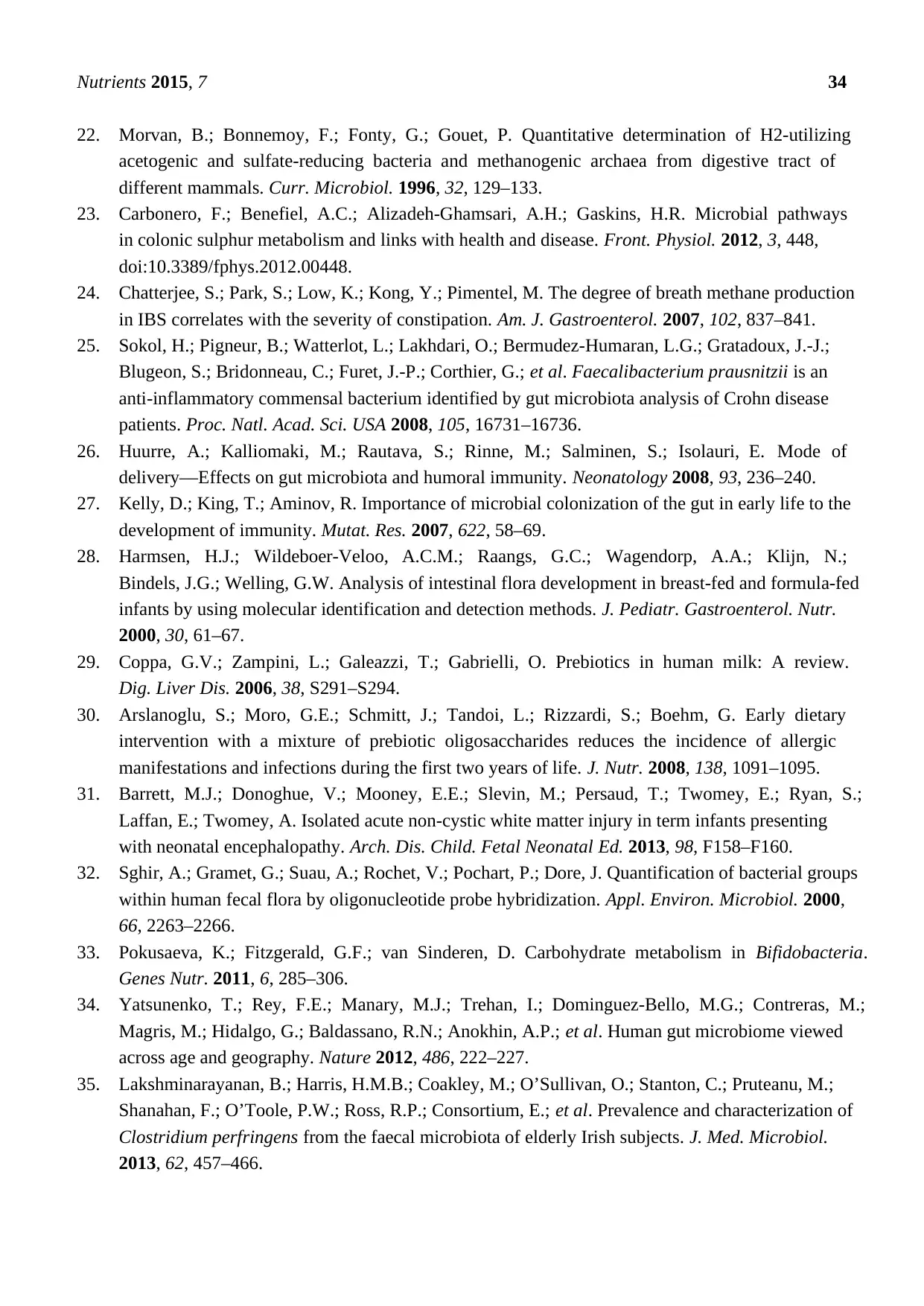
Nutrients 2015, 7 34
22. Morvan, B.; Bonnemoy, F.; Fonty, G.; Gouet, P. Quantitative determination of H2-utilizing
acetogenic and sulfate-reducing bacteria and methanogenic archaea from digestive tract of
different mammals. Curr. Microbiol. 1996, 32, 129–133.
23. Carbonero, F.; Benefiel, A.C.; Alizadeh-Ghamsari, A.H.; Gaskins, H.R. Microbial pathways
in colonic sulphur metabolism and links with health and disease. Front. Physiol. 2012, 3, 448,
doi:10.3389/fphys.2012.00448.
24. Chatterjee, S.; Park, S.; Low, K.; Kong, Y.; Pimentel, M. The degree of breath methane production
in IBS correlates with the severity of constipation. Am. J. Gastroenterol. 2007, 102, 837–841.
25. Sokol, H.; Pigneur, B.; Watterlot, L.; Lakhdari, O.; Bermudez-Humaran, L.G.; Gratadoux, J.-J.;
Blugeon, S.; Bridonneau, C.; Furet, J.-P.; Corthier, G.; et al. Faecalibacterium prausnitzii is an
anti-inflammatory commensal bacterium identified by gut microbiota analysis of Crohn disease
patients. Proc. Natl. Acad. Sci. USA 2008, 105, 16731–16736.
26. Huurre, A.; Kalliomaki, M.; Rautava, S.; Rinne, M.; Salminen, S.; Isolauri, E. Mode of
delivery—Effects on gut microbiota and humoral immunity. Neonatology 2008, 93, 236–240.
27. Kelly, D.; King, T.; Aminov, R. Importance of microbial colonization of the gut in early life to the
development of immunity. Mutat. Res. 2007, 622, 58–69.
28. Harmsen, H.J.; Wildeboer-Veloo, A.C.M.; Raangs, G.C.; Wagendorp, A.A.; Klijn, N.;
Bindels, J.G.; Welling, G.W. Analysis of intestinal flora development in breast-fed and formula-fed
infants by using molecular identification and detection methods. J. Pediatr. Gastroenterol. Nutr.
2000, 30, 61–67.
29. Coppa, G.V.; Zampini, L.; Galeazzi, T.; Gabrielli, O. Prebiotics in human milk: A review.
Dig. Liver Dis. 2006, 38, S291–S294.
30. Arslanoglu, S.; Moro, G.E.; Schmitt, J.; Tandoi, L.; Rizzardi, S.; Boehm, G. Early dietary
intervention with a mixture of prebiotic oligosaccharides reduces the incidence of allergic
manifestations and infections during the first two years of life. J. Nutr. 2008, 138, 1091–1095.
31. Barrett, M.J.; Donoghue, V.; Mooney, E.E.; Slevin, M.; Persaud, T.; Twomey, E.; Ryan, S.;
Laffan, E.; Twomey, A. Isolated acute non-cystic white matter injury in term infants presenting
with neonatal encephalopathy. Arch. Dis. Child. Fetal Neonatal Ed. 2013, 98, F158–F160.
32. Sghir, A.; Gramet, G.; Suau, A.; Rochet, V.; Pochart, P.; Dore, J. Quantification of bacterial groups
within human fecal flora by oligonucleotide probe hybridization. Appl. Environ. Microbiol. 2000,
66, 2263–2266.
33. Pokusaeva, K.; Fitzgerald, G.F.; van Sinderen, D. Carbohydrate metabolism in Bifidobacteria.
Genes Nutr. 2011, 6, 285–306.
34. Yatsunenko, T.; Rey, F.E.; Manary, M.J.; Trehan, I.; Dominguez-Bello, M.G.; Contreras, M.;
Magris, M.; Hidalgo, G.; Baldassano, R.N.; Anokhin, A.P.; et al. Human gut microbiome viewed
across age and geography. Nature 2012, 486, 222–227.
35. Lakshminarayanan, B.; Harris, H.M.B.; Coakley, M.; O’Sullivan, O.; Stanton, C.; Pruteanu, M.;
Shanahan, F.; O’Toole, P.W.; Ross, R.P.; Consortium, E.; et al. Prevalence and characterization of
Clostridium perfringens from the faecal microbiota of elderly Irish subjects. J. Med. Microbiol.
2013, 62, 457–466.
22. Morvan, B.; Bonnemoy, F.; Fonty, G.; Gouet, P. Quantitative determination of H2-utilizing
acetogenic and sulfate-reducing bacteria and methanogenic archaea from digestive tract of
different mammals. Curr. Microbiol. 1996, 32, 129–133.
23. Carbonero, F.; Benefiel, A.C.; Alizadeh-Ghamsari, A.H.; Gaskins, H.R. Microbial pathways
in colonic sulphur metabolism and links with health and disease. Front. Physiol. 2012, 3, 448,
doi:10.3389/fphys.2012.00448.
24. Chatterjee, S.; Park, S.; Low, K.; Kong, Y.; Pimentel, M. The degree of breath methane production
in IBS correlates with the severity of constipation. Am. J. Gastroenterol. 2007, 102, 837–841.
25. Sokol, H.; Pigneur, B.; Watterlot, L.; Lakhdari, O.; Bermudez-Humaran, L.G.; Gratadoux, J.-J.;
Blugeon, S.; Bridonneau, C.; Furet, J.-P.; Corthier, G.; et al. Faecalibacterium prausnitzii is an
anti-inflammatory commensal bacterium identified by gut microbiota analysis of Crohn disease
patients. Proc. Natl. Acad. Sci. USA 2008, 105, 16731–16736.
26. Huurre, A.; Kalliomaki, M.; Rautava, S.; Rinne, M.; Salminen, S.; Isolauri, E. Mode of
delivery—Effects on gut microbiota and humoral immunity. Neonatology 2008, 93, 236–240.
27. Kelly, D.; King, T.; Aminov, R. Importance of microbial colonization of the gut in early life to the
development of immunity. Mutat. Res. 2007, 622, 58–69.
28. Harmsen, H.J.; Wildeboer-Veloo, A.C.M.; Raangs, G.C.; Wagendorp, A.A.; Klijn, N.;
Bindels, J.G.; Welling, G.W. Analysis of intestinal flora development in breast-fed and formula-fed
infants by using molecular identification and detection methods. J. Pediatr. Gastroenterol. Nutr.
2000, 30, 61–67.
29. Coppa, G.V.; Zampini, L.; Galeazzi, T.; Gabrielli, O. Prebiotics in human milk: A review.
Dig. Liver Dis. 2006, 38, S291–S294.
30. Arslanoglu, S.; Moro, G.E.; Schmitt, J.; Tandoi, L.; Rizzardi, S.; Boehm, G. Early dietary
intervention with a mixture of prebiotic oligosaccharides reduces the incidence of allergic
manifestations and infections during the first two years of life. J. Nutr. 2008, 138, 1091–1095.
31. Barrett, M.J.; Donoghue, V.; Mooney, E.E.; Slevin, M.; Persaud, T.; Twomey, E.; Ryan, S.;
Laffan, E.; Twomey, A. Isolated acute non-cystic white matter injury in term infants presenting
with neonatal encephalopathy. Arch. Dis. Child. Fetal Neonatal Ed. 2013, 98, F158–F160.
32. Sghir, A.; Gramet, G.; Suau, A.; Rochet, V.; Pochart, P.; Dore, J. Quantification of bacterial groups
within human fecal flora by oligonucleotide probe hybridization. Appl. Environ. Microbiol. 2000,
66, 2263–2266.
33. Pokusaeva, K.; Fitzgerald, G.F.; van Sinderen, D. Carbohydrate metabolism in Bifidobacteria.
Genes Nutr. 2011, 6, 285–306.
34. Yatsunenko, T.; Rey, F.E.; Manary, M.J.; Trehan, I.; Dominguez-Bello, M.G.; Contreras, M.;
Magris, M.; Hidalgo, G.; Baldassano, R.N.; Anokhin, A.P.; et al. Human gut microbiome viewed
across age and geography. Nature 2012, 486, 222–227.
35. Lakshminarayanan, B.; Harris, H.M.B.; Coakley, M.; O’Sullivan, O.; Stanton, C.; Pruteanu, M.;
Shanahan, F.; O’Toole, P.W.; Ross, R.P.; Consortium, E.; et al. Prevalence and characterization of
Clostridium perfringens from the faecal microbiota of elderly Irish subjects. J. Med. Microbiol.
2013, 62, 457–466.
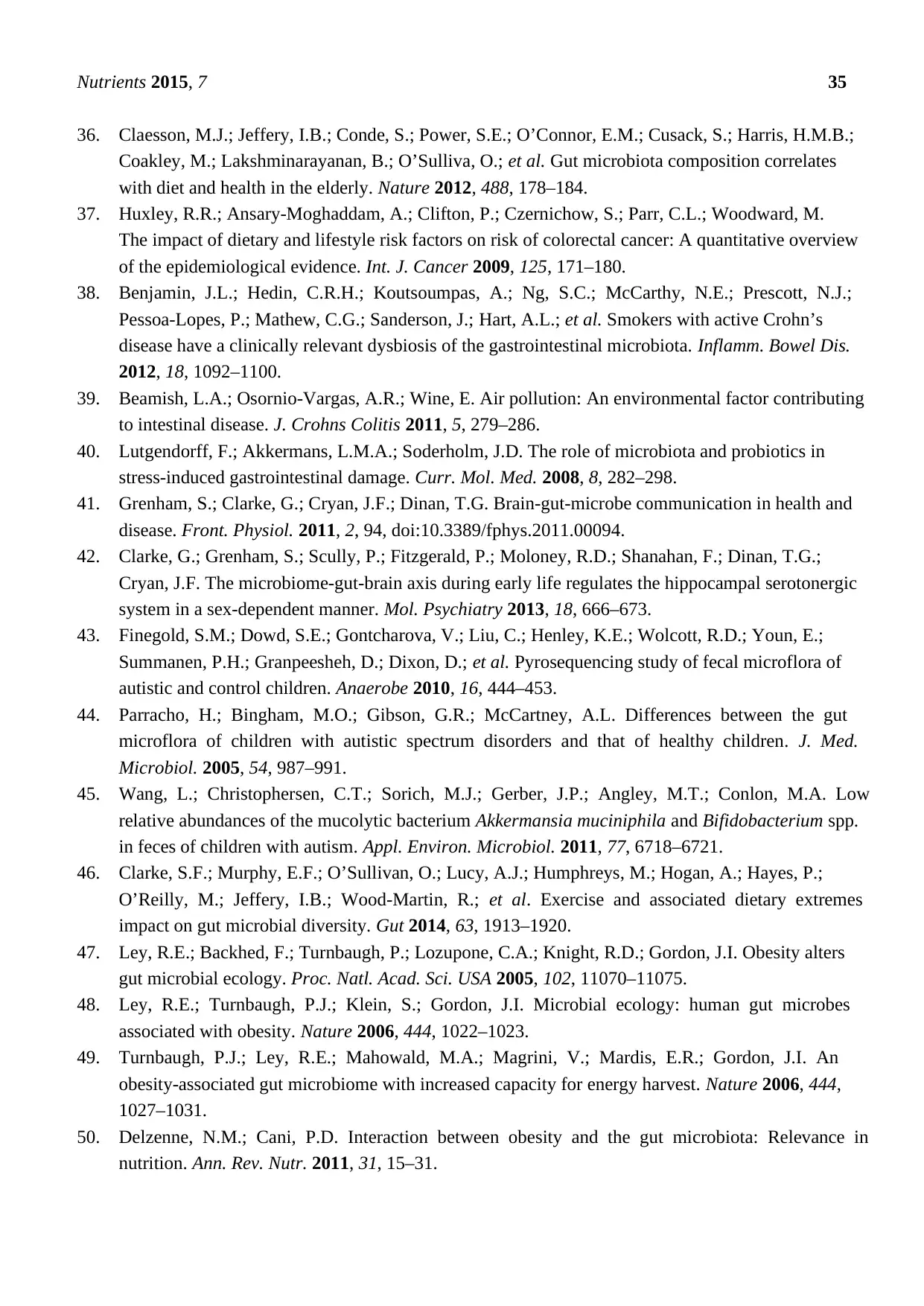
Nutrients 2015, 7 35
36. Claesson, M.J.; Jeffery, I.B.; Conde, S.; Power, S.E.; O’Connor, E.M.; Cusack, S.; Harris, H.M.B.;
Coakley, M.; Lakshminarayanan, B.; O’Sulliva, O.; et al. Gut microbiota composition correlates
with diet and health in the elderly. Nature 2012, 488, 178–184.
37. Huxley, R.R.; Ansary-Moghaddam, A.; Clifton, P.; Czernichow, S.; Parr, C.L.; Woodward, M.
The impact of dietary and lifestyle risk factors on risk of colorectal cancer: A quantitative overview
of the epidemiological evidence. Int. J. Cancer 2009, 125, 171–180.
38. Benjamin, J.L.; Hedin, C.R.H.; Koutsoumpas, A.; Ng, S.C.; McCarthy, N.E.; Prescott, N.J.;
Pessoa-Lopes, P.; Mathew, C.G.; Sanderson, J.; Hart, A.L.; et al. Smokers with active Crohn’s
disease have a clinically relevant dysbiosis of the gastrointestinal microbiota. Inflamm. Bowel Dis.
2012, 18, 1092–1100.
39. Beamish, L.A.; Osornio-Vargas, A.R.; Wine, E. Air pollution: An environmental factor contributing
to intestinal disease. J. Crohns Colitis 2011, 5, 279–286.
40. Lutgendorff, F.; Akkermans, L.M.A.; Soderholm, J.D. The role of microbiota and probiotics in
stress-induced gastrointestinal damage. Curr. Mol. Med. 2008, 8, 282–298.
41. Grenham, S.; Clarke, G.; Cryan, J.F.; Dinan, T.G. Brain-gut-microbe communication in health and
disease. Front. Physiol. 2011, 2, 94, doi:10.3389/fphys.2011.00094.
42. Clarke, G.; Grenham, S.; Scully, P.; Fitzgerald, P.; Moloney, R.D.; Shanahan, F.; Dinan, T.G.;
Cryan, J.F. The microbiome-gut-brain axis during early life regulates the hippocampal serotonergic
system in a sex-dependent manner. Mol. Psychiatry 2013, 18, 666–673.
43. Finegold, S.M.; Dowd, S.E.; Gontcharova, V.; Liu, C.; Henley, K.E.; Wolcott, R.D.; Youn, E.;
Summanen, P.H.; Granpeesheh, D.; Dixon, D.; et al. Pyrosequencing study of fecal microflora of
autistic and control children. Anaerobe 2010, 16, 444–453.
44. Parracho, H.; Bingham, M.O.; Gibson, G.R.; McCartney, A.L. Differences between the gut
microflora of children with autistic spectrum disorders and that of healthy children. J. Med.
Microbiol. 2005, 54, 987–991.
45. Wang, L.; Christophersen, C.T.; Sorich, M.J.; Gerber, J.P.; Angley, M.T.; Conlon, M.A. Low
relative abundances of the mucolytic bacterium Akkermansia muciniphila and Bifidobacterium spp.
in feces of children with autism. Appl. Environ. Microbiol. 2011, 77, 6718–6721.
46. Clarke, S.F.; Murphy, E.F.; O’Sullivan, O.; Lucy, A.J.; Humphreys, M.; Hogan, A.; Hayes, P.;
O’Reilly, M.; Jeffery, I.B.; Wood-Martin, R.; et al. Exercise and associated dietary extremes
impact on gut microbial diversity. Gut 2014, 63, 1913–1920.
47. Ley, R.E.; Backhed, F.; Turnbaugh, P.; Lozupone, C.A.; Knight, R.D.; Gordon, J.I. Obesity alters
gut microbial ecology. Proc. Natl. Acad. Sci. USA 2005, 102, 11070–11075.
48. Ley, R.E.; Turnbaugh, P.J.; Klein, S.; Gordon, J.I. Microbial ecology: human gut microbes
associated with obesity. Nature 2006, 444, 1022–1023.
49. Turnbaugh, P.J.; Ley, R.E.; Mahowald, M.A.; Magrini, V.; Mardis, E.R.; Gordon, J.I. An
obesity-associated gut microbiome with increased capacity for energy harvest. Nature 2006, 444,
1027–1031.
50. Delzenne, N.M.; Cani, P.D. Interaction between obesity and the gut microbiota: Relevance in
nutrition. Ann. Rev. Nutr. 2011, 31, 15–31.
36. Claesson, M.J.; Jeffery, I.B.; Conde, S.; Power, S.E.; O’Connor, E.M.; Cusack, S.; Harris, H.M.B.;
Coakley, M.; Lakshminarayanan, B.; O’Sulliva, O.; et al. Gut microbiota composition correlates
with diet and health in the elderly. Nature 2012, 488, 178–184.
37. Huxley, R.R.; Ansary-Moghaddam, A.; Clifton, P.; Czernichow, S.; Parr, C.L.; Woodward, M.
The impact of dietary and lifestyle risk factors on risk of colorectal cancer: A quantitative overview
of the epidemiological evidence. Int. J. Cancer 2009, 125, 171–180.
38. Benjamin, J.L.; Hedin, C.R.H.; Koutsoumpas, A.; Ng, S.C.; McCarthy, N.E.; Prescott, N.J.;
Pessoa-Lopes, P.; Mathew, C.G.; Sanderson, J.; Hart, A.L.; et al. Smokers with active Crohn’s
disease have a clinically relevant dysbiosis of the gastrointestinal microbiota. Inflamm. Bowel Dis.
2012, 18, 1092–1100.
39. Beamish, L.A.; Osornio-Vargas, A.R.; Wine, E. Air pollution: An environmental factor contributing
to intestinal disease. J. Crohns Colitis 2011, 5, 279–286.
40. Lutgendorff, F.; Akkermans, L.M.A.; Soderholm, J.D. The role of microbiota and probiotics in
stress-induced gastrointestinal damage. Curr. Mol. Med. 2008, 8, 282–298.
41. Grenham, S.; Clarke, G.; Cryan, J.F.; Dinan, T.G. Brain-gut-microbe communication in health and
disease. Front. Physiol. 2011, 2, 94, doi:10.3389/fphys.2011.00094.
42. Clarke, G.; Grenham, S.; Scully, P.; Fitzgerald, P.; Moloney, R.D.; Shanahan, F.; Dinan, T.G.;
Cryan, J.F. The microbiome-gut-brain axis during early life regulates the hippocampal serotonergic
system in a sex-dependent manner. Mol. Psychiatry 2013, 18, 666–673.
43. Finegold, S.M.; Dowd, S.E.; Gontcharova, V.; Liu, C.; Henley, K.E.; Wolcott, R.D.; Youn, E.;
Summanen, P.H.; Granpeesheh, D.; Dixon, D.; et al. Pyrosequencing study of fecal microflora of
autistic and control children. Anaerobe 2010, 16, 444–453.
44. Parracho, H.; Bingham, M.O.; Gibson, G.R.; McCartney, A.L. Differences between the gut
microflora of children with autistic spectrum disorders and that of healthy children. J. Med.
Microbiol. 2005, 54, 987–991.
45. Wang, L.; Christophersen, C.T.; Sorich, M.J.; Gerber, J.P.; Angley, M.T.; Conlon, M.A. Low
relative abundances of the mucolytic bacterium Akkermansia muciniphila and Bifidobacterium spp.
in feces of children with autism. Appl. Environ. Microbiol. 2011, 77, 6718–6721.
46. Clarke, S.F.; Murphy, E.F.; O’Sullivan, O.; Lucy, A.J.; Humphreys, M.; Hogan, A.; Hayes, P.;
O’Reilly, M.; Jeffery, I.B.; Wood-Martin, R.; et al. Exercise and associated dietary extremes
impact on gut microbial diversity. Gut 2014, 63, 1913–1920.
47. Ley, R.E.; Backhed, F.; Turnbaugh, P.; Lozupone, C.A.; Knight, R.D.; Gordon, J.I. Obesity alters
gut microbial ecology. Proc. Natl. Acad. Sci. USA 2005, 102, 11070–11075.
48. Ley, R.E.; Turnbaugh, P.J.; Klein, S.; Gordon, J.I. Microbial ecology: human gut microbes
associated with obesity. Nature 2006, 444, 1022–1023.
49. Turnbaugh, P.J.; Ley, R.E.; Mahowald, M.A.; Magrini, V.; Mardis, E.R.; Gordon, J.I. An
obesity-associated gut microbiome with increased capacity for energy harvest. Nature 2006, 444,
1027–1031.
50. Delzenne, N.M.; Cani, P.D. Interaction between obesity and the gut microbiota: Relevance in
nutrition. Ann. Rev. Nutr. 2011, 31, 15–31.
Paraphrase This Document
Need a fresh take? Get an instant paraphrase of this document with our AI Paraphraser
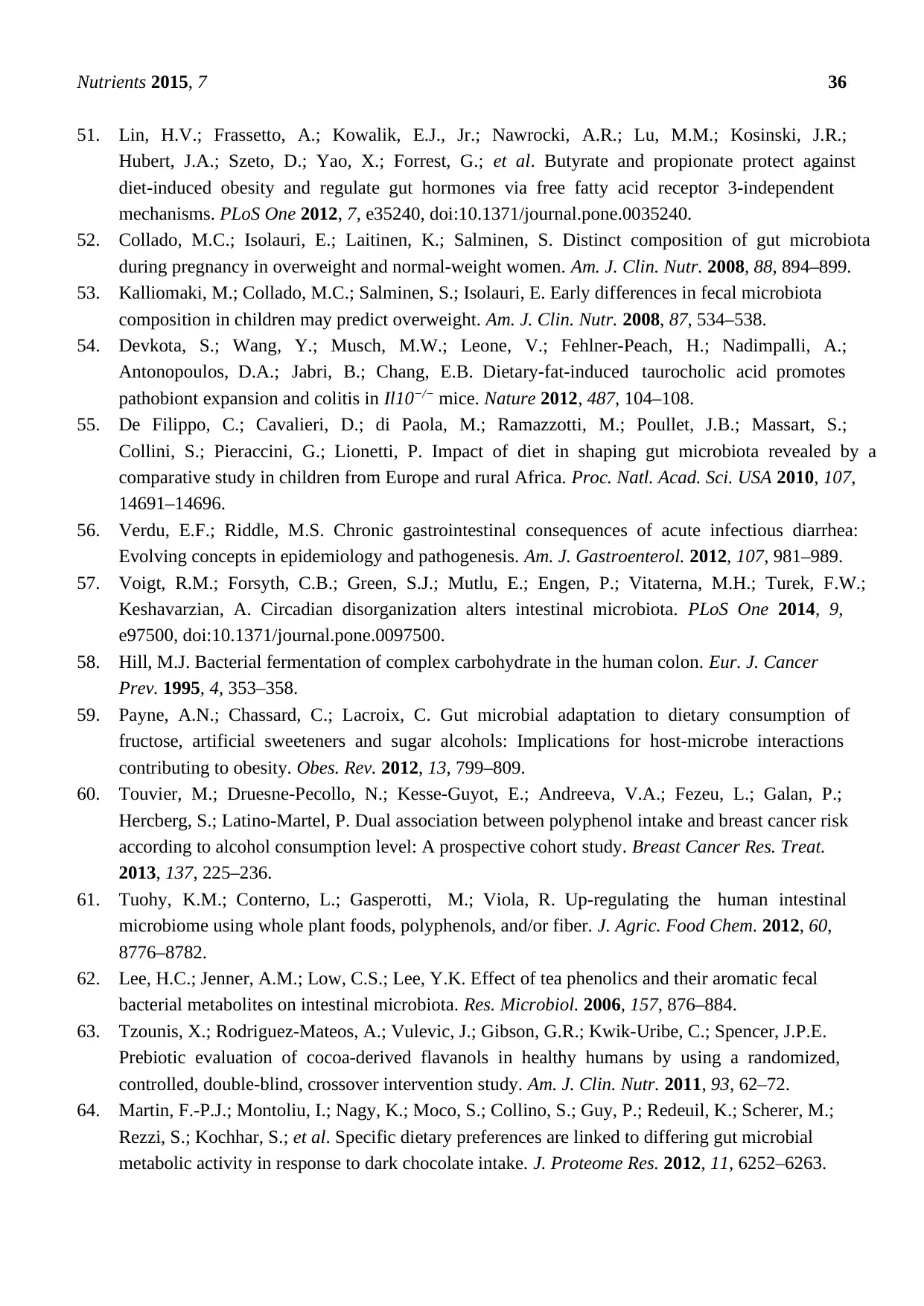
Nutrients 2015, 7 36
51. Lin, H.V.; Frassetto, A.; Kowalik, E.J., Jr.; Nawrocki, A.R.; Lu, M.M.; Kosinski, J.R.;
Hubert, J.A.; Szeto, D.; Yao, X.; Forrest, G.; et al. Butyrate and propionate protect against
diet-induced obesity and regulate gut hormones via free fatty acid receptor 3-independent
mechanisms. PLoS One 2012, 7, e35240, doi:10.1371/journal.pone.0035240.
52. Collado, M.C.; Isolauri, E.; Laitinen, K.; Salminen, S. Distinct composition of gut microbiota
during pregnancy in overweight and normal-weight women. Am. J. Clin. Nutr. 2008, 88, 894–899.
53. Kalliomaki, M.; Collado, M.C.; Salminen, S.; Isolauri, E. Early differences in fecal microbiota
composition in children may predict overweight. Am. J. Clin. Nutr. 2008, 87, 534–538.
54. Devkota, S.; Wang, Y.; Musch, M.W.; Leone, V.; Fehlner-Peach, H.; Nadimpalli, A.;
Antonopoulos, D.A.; Jabri, B.; Chang, E.B. Dietary-fat-induced taurocholic acid promotes
pathobiont expansion and colitis in Il10−/− mice. Nature 2012, 487, 104–108.
55. De Filippo, C.; Cavalieri, D.; di Paola, M.; Ramazzotti, M.; Poullet, J.B.; Massart, S.;
Collini, S.; Pieraccini, G.; Lionetti, P. Impact of diet in shaping gut microbiota revealed by a
comparative study in children from Europe and rural Africa. Proc. Natl. Acad. Sci. USA 2010, 107,
14691–14696.
56. Verdu, E.F.; Riddle, M.S. Chronic gastrointestinal consequences of acute infectious diarrhea:
Evolving concepts in epidemiology and pathogenesis. Am. J. Gastroenterol. 2012, 107, 981–989.
57. Voigt, R.M.; Forsyth, C.B.; Green, S.J.; Mutlu, E.; Engen, P.; Vitaterna, M.H.; Turek, F.W.;
Keshavarzian, A. Circadian disorganization alters intestinal microbiota. PLoS One 2014, 9,
e97500, doi:10.1371/journal.pone.0097500.
58. Hill, M.J. Bacterial fermentation of complex carbohydrate in the human colon. Eur. J. Cancer
Prev. 1995, 4, 353–358.
59. Payne, A.N.; Chassard, C.; Lacroix, C. Gut microbial adaptation to dietary consumption of
fructose, artificial sweeteners and sugar alcohols: Implications for host-microbe interactions
contributing to obesity. Obes. Rev. 2012, 13, 799–809.
60. Touvier, M.; Druesne-Pecollo, N.; Kesse-Guyot, E.; Andreeva, V.A.; Fezeu, L.; Galan, P.;
Hercberg, S.; Latino-Martel, P. Dual association between polyphenol intake and breast cancer risk
according to alcohol consumption level: A prospective cohort study. Breast Cancer Res. Treat.
2013, 137, 225–236.
61. Tuohy, K.M.; Conterno, L.; Gasperotti, M.; Viola, R. Up-regulating the human intestinal
microbiome using whole plant foods, polyphenols, and/or fiber. J. Agric. Food Chem. 2012, 60,
8776–8782.
62. Lee, H.C.; Jenner, A.M.; Low, C.S.; Lee, Y.K. Effect of tea phenolics and their aromatic fecal
bacterial metabolites on intestinal microbiota. Res. Microbiol. 2006, 157, 876–884.
63. Tzounis, X.; Rodriguez-Mateos, A.; Vulevic, J.; Gibson, G.R.; Kwik-Uribe, C.; Spencer, J.P.E.
Prebiotic evaluation of cocoa-derived flavanols in healthy humans by using a randomized,
controlled, double-blind, crossover intervention study. Am. J. Clin. Nutr. 2011, 93, 62–72.
64. Martin, F.-P.J.; Montoliu, I.; Nagy, K.; Moco, S.; Collino, S.; Guy, P.; Redeuil, K.; Scherer, M.;
Rezzi, S.; Kochhar, S.; et al. Specific dietary preferences are linked to differing gut microbial
metabolic activity in response to dark chocolate intake. J. Proteome Res. 2012, 11, 6252–6263.
51. Lin, H.V.; Frassetto, A.; Kowalik, E.J., Jr.; Nawrocki, A.R.; Lu, M.M.; Kosinski, J.R.;
Hubert, J.A.; Szeto, D.; Yao, X.; Forrest, G.; et al. Butyrate and propionate protect against
diet-induced obesity and regulate gut hormones via free fatty acid receptor 3-independent
mechanisms. PLoS One 2012, 7, e35240, doi:10.1371/journal.pone.0035240.
52. Collado, M.C.; Isolauri, E.; Laitinen, K.; Salminen, S. Distinct composition of gut microbiota
during pregnancy in overweight and normal-weight women. Am. J. Clin. Nutr. 2008, 88, 894–899.
53. Kalliomaki, M.; Collado, M.C.; Salminen, S.; Isolauri, E. Early differences in fecal microbiota
composition in children may predict overweight. Am. J. Clin. Nutr. 2008, 87, 534–538.
54. Devkota, S.; Wang, Y.; Musch, M.W.; Leone, V.; Fehlner-Peach, H.; Nadimpalli, A.;
Antonopoulos, D.A.; Jabri, B.; Chang, E.B. Dietary-fat-induced taurocholic acid promotes
pathobiont expansion and colitis in Il10−/− mice. Nature 2012, 487, 104–108.
55. De Filippo, C.; Cavalieri, D.; di Paola, M.; Ramazzotti, M.; Poullet, J.B.; Massart, S.;
Collini, S.; Pieraccini, G.; Lionetti, P. Impact of diet in shaping gut microbiota revealed by a
comparative study in children from Europe and rural Africa. Proc. Natl. Acad. Sci. USA 2010, 107,
14691–14696.
56. Verdu, E.F.; Riddle, M.S. Chronic gastrointestinal consequences of acute infectious diarrhea:
Evolving concepts in epidemiology and pathogenesis. Am. J. Gastroenterol. 2012, 107, 981–989.
57. Voigt, R.M.; Forsyth, C.B.; Green, S.J.; Mutlu, E.; Engen, P.; Vitaterna, M.H.; Turek, F.W.;
Keshavarzian, A. Circadian disorganization alters intestinal microbiota. PLoS One 2014, 9,
e97500, doi:10.1371/journal.pone.0097500.
58. Hill, M.J. Bacterial fermentation of complex carbohydrate in the human colon. Eur. J. Cancer
Prev. 1995, 4, 353–358.
59. Payne, A.N.; Chassard, C.; Lacroix, C. Gut microbial adaptation to dietary consumption of
fructose, artificial sweeteners and sugar alcohols: Implications for host-microbe interactions
contributing to obesity. Obes. Rev. 2012, 13, 799–809.
60. Touvier, M.; Druesne-Pecollo, N.; Kesse-Guyot, E.; Andreeva, V.A.; Fezeu, L.; Galan, P.;
Hercberg, S.; Latino-Martel, P. Dual association between polyphenol intake and breast cancer risk
according to alcohol consumption level: A prospective cohort study. Breast Cancer Res. Treat.
2013, 137, 225–236.
61. Tuohy, K.M.; Conterno, L.; Gasperotti, M.; Viola, R. Up-regulating the human intestinal
microbiome using whole plant foods, polyphenols, and/or fiber. J. Agric. Food Chem. 2012, 60,
8776–8782.
62. Lee, H.C.; Jenner, A.M.; Low, C.S.; Lee, Y.K. Effect of tea phenolics and their aromatic fecal
bacterial metabolites on intestinal microbiota. Res. Microbiol. 2006, 157, 876–884.
63. Tzounis, X.; Rodriguez-Mateos, A.; Vulevic, J.; Gibson, G.R.; Kwik-Uribe, C.; Spencer, J.P.E.
Prebiotic evaluation of cocoa-derived flavanols in healthy humans by using a randomized,
controlled, double-blind, crossover intervention study. Am. J. Clin. Nutr. 2011, 93, 62–72.
64. Martin, F.-P.J.; Montoliu, I.; Nagy, K.; Moco, S.; Collino, S.; Guy, P.; Redeuil, K.; Scherer, M.;
Rezzi, S.; Kochhar, S.; et al. Specific dietary preferences are linked to differing gut microbial
metabolic activity in response to dark chocolate intake. J. Proteome Res. 2012, 11, 6252–6263.
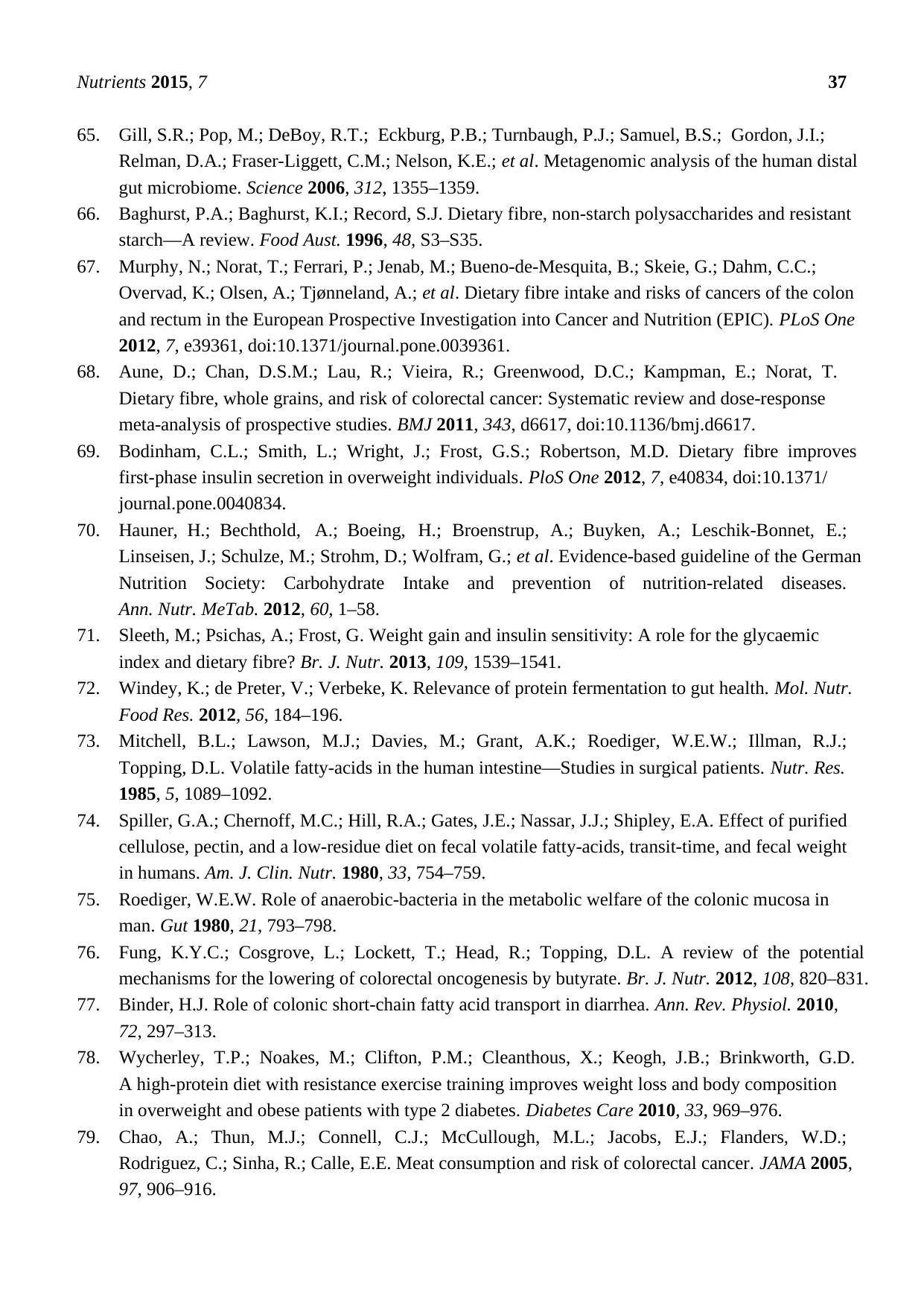
Nutrients 2015, 7 37
65. Gill, S.R.; Pop, M.; DeBoy, R.T.; Eckburg, P.B.; Turnbaugh, P.J.; Samuel, B.S.; Gordon, J.I.;
Relman, D.A.; Fraser-Liggett, C.M.; Nelson, K.E.; et al. Metagenomic analysis of the human distal
gut microbiome. Science 2006, 312, 1355–1359.
66. Baghurst, P.A.; Baghurst, K.I.; Record, S.J. Dietary fibre, non-starch polysaccharides and resistant
starch—A review. Food Aust. 1996, 48, S3–S35.
67. Murphy, N.; Norat, T.; Ferrari, P.; Jenab, M.; Bueno-de-Mesquita, B.; Skeie, G.; Dahm, C.C.;
Overvad, K.; Olsen, A.; Tjønneland, A.; et al. Dietary fibre intake and risks of cancers of the colon
and rectum in the European Prospective Investigation into Cancer and Nutrition (EPIC). PLoS One
2012, 7, e39361, doi:10.1371/journal.pone.0039361.
68. Aune, D.; Chan, D.S.M.; Lau, R.; Vieira, R.; Greenwood, D.C.; Kampman, E.; Norat, T.
Dietary fibre, whole grains, and risk of colorectal cancer: Systematic review and dose-response
meta-analysis of prospective studies. BMJ 2011, 343, d6617, doi:10.1136/bmj.d6617.
69. Bodinham, C.L.; Smith, L.; Wright, J.; Frost, G.S.; Robertson, M.D. Dietary fibre improves
first-phase insulin secretion in overweight individuals. PloS One 2012, 7, e40834, doi:10.1371/
journal.pone.0040834.
70. Hauner, H.; Bechthold, A.; Boeing, H.; Broenstrup, A.; Buyken, A.; Leschik-Bonnet, E.;
Linseisen, J.; Schulze, M.; Strohm, D.; Wolfram, G.; et al. Evidence-based guideline of the German
Nutrition Society: Carbohydrate Intake and prevention of nutrition-related diseases.
Ann. Nutr. MeTab. 2012, 60, 1–58.
71. Sleeth, M.; Psichas, A.; Frost, G. Weight gain and insulin sensitivity: A role for the glycaemic
index and dietary fibre? Br. J. Nutr. 2013, 109, 1539–1541.
72. Windey, K.; de Preter, V.; Verbeke, K. Relevance of protein fermentation to gut health. Mol. Nutr.
Food Res. 2012, 56, 184–196.
73. Mitchell, B.L.; Lawson, M.J.; Davies, M.; Grant, A.K.; Roediger, W.E.W.; Illman, R.J.;
Topping, D.L. Volatile fatty-acids in the human intestine—Studies in surgical patients. Nutr. Res.
1985, 5, 1089–1092.
74. Spiller, G.A.; Chernoff, M.C.; Hill, R.A.; Gates, J.E.; Nassar, J.J.; Shipley, E.A. Effect of purified
cellulose, pectin, and a low-residue diet on fecal volatile fatty-acids, transit-time, and fecal weight
in humans. Am. J. Clin. Nutr. 1980, 33, 754–759.
75. Roediger, W.E.W. Role of anaerobic-bacteria in the metabolic welfare of the colonic mucosa in
man. Gut 1980, 21, 793–798.
76. Fung, K.Y.C.; Cosgrove, L.; Lockett, T.; Head, R.; Topping, D.L. A review of the potential
mechanisms for the lowering of colorectal oncogenesis by butyrate. Br. J. Nutr. 2012, 108, 820–831.
77. Binder, H.J. Role of colonic short-chain fatty acid transport in diarrhea. Ann. Rev. Physiol. 2010,
72, 297–313.
78. Wycherley, T.P.; Noakes, M.; Clifton, P.M.; Cleanthous, X.; Keogh, J.B.; Brinkworth, G.D.
A high-protein diet with resistance exercise training improves weight loss and body composition
in overweight and obese patients with type 2 diabetes. Diabetes Care 2010, 33, 969–976.
79. Chao, A.; Thun, M.J.; Connell, C.J.; McCullough, M.L.; Jacobs, E.J.; Flanders, W.D.;
Rodriguez, C.; Sinha, R.; Calle, E.E. Meat consumption and risk of colorectal cancer. JAMA 2005,
97, 906–916.
65. Gill, S.R.; Pop, M.; DeBoy, R.T.; Eckburg, P.B.; Turnbaugh, P.J.; Samuel, B.S.; Gordon, J.I.;
Relman, D.A.; Fraser-Liggett, C.M.; Nelson, K.E.; et al. Metagenomic analysis of the human distal
gut microbiome. Science 2006, 312, 1355–1359.
66. Baghurst, P.A.; Baghurst, K.I.; Record, S.J. Dietary fibre, non-starch polysaccharides and resistant
starch—A review. Food Aust. 1996, 48, S3–S35.
67. Murphy, N.; Norat, T.; Ferrari, P.; Jenab, M.; Bueno-de-Mesquita, B.; Skeie, G.; Dahm, C.C.;
Overvad, K.; Olsen, A.; Tjønneland, A.; et al. Dietary fibre intake and risks of cancers of the colon
and rectum in the European Prospective Investigation into Cancer and Nutrition (EPIC). PLoS One
2012, 7, e39361, doi:10.1371/journal.pone.0039361.
68. Aune, D.; Chan, D.S.M.; Lau, R.; Vieira, R.; Greenwood, D.C.; Kampman, E.; Norat, T.
Dietary fibre, whole grains, and risk of colorectal cancer: Systematic review and dose-response
meta-analysis of prospective studies. BMJ 2011, 343, d6617, doi:10.1136/bmj.d6617.
69. Bodinham, C.L.; Smith, L.; Wright, J.; Frost, G.S.; Robertson, M.D. Dietary fibre improves
first-phase insulin secretion in overweight individuals. PloS One 2012, 7, e40834, doi:10.1371/
journal.pone.0040834.
70. Hauner, H.; Bechthold, A.; Boeing, H.; Broenstrup, A.; Buyken, A.; Leschik-Bonnet, E.;
Linseisen, J.; Schulze, M.; Strohm, D.; Wolfram, G.; et al. Evidence-based guideline of the German
Nutrition Society: Carbohydrate Intake and prevention of nutrition-related diseases.
Ann. Nutr. MeTab. 2012, 60, 1–58.
71. Sleeth, M.; Psichas, A.; Frost, G. Weight gain and insulin sensitivity: A role for the glycaemic
index and dietary fibre? Br. J. Nutr. 2013, 109, 1539–1541.
72. Windey, K.; de Preter, V.; Verbeke, K. Relevance of protein fermentation to gut health. Mol. Nutr.
Food Res. 2012, 56, 184–196.
73. Mitchell, B.L.; Lawson, M.J.; Davies, M.; Grant, A.K.; Roediger, W.E.W.; Illman, R.J.;
Topping, D.L. Volatile fatty-acids in the human intestine—Studies in surgical patients. Nutr. Res.
1985, 5, 1089–1092.
74. Spiller, G.A.; Chernoff, M.C.; Hill, R.A.; Gates, J.E.; Nassar, J.J.; Shipley, E.A. Effect of purified
cellulose, pectin, and a low-residue diet on fecal volatile fatty-acids, transit-time, and fecal weight
in humans. Am. J. Clin. Nutr. 1980, 33, 754–759.
75. Roediger, W.E.W. Role of anaerobic-bacteria in the metabolic welfare of the colonic mucosa in
man. Gut 1980, 21, 793–798.
76. Fung, K.Y.C.; Cosgrove, L.; Lockett, T.; Head, R.; Topping, D.L. A review of the potential
mechanisms for the lowering of colorectal oncogenesis by butyrate. Br. J. Nutr. 2012, 108, 820–831.
77. Binder, H.J. Role of colonic short-chain fatty acid transport in diarrhea. Ann. Rev. Physiol. 2010,
72, 297–313.
78. Wycherley, T.P.; Noakes, M.; Clifton, P.M.; Cleanthous, X.; Keogh, J.B.; Brinkworth, G.D.
A high-protein diet with resistance exercise training improves weight loss and body composition
in overweight and obese patients with type 2 diabetes. Diabetes Care 2010, 33, 969–976.
79. Chao, A.; Thun, M.J.; Connell, C.J.; McCullough, M.L.; Jacobs, E.J.; Flanders, W.D.;
Rodriguez, C.; Sinha, R.; Calle, E.E. Meat consumption and risk of colorectal cancer. JAMA 2005,
97, 906–916.
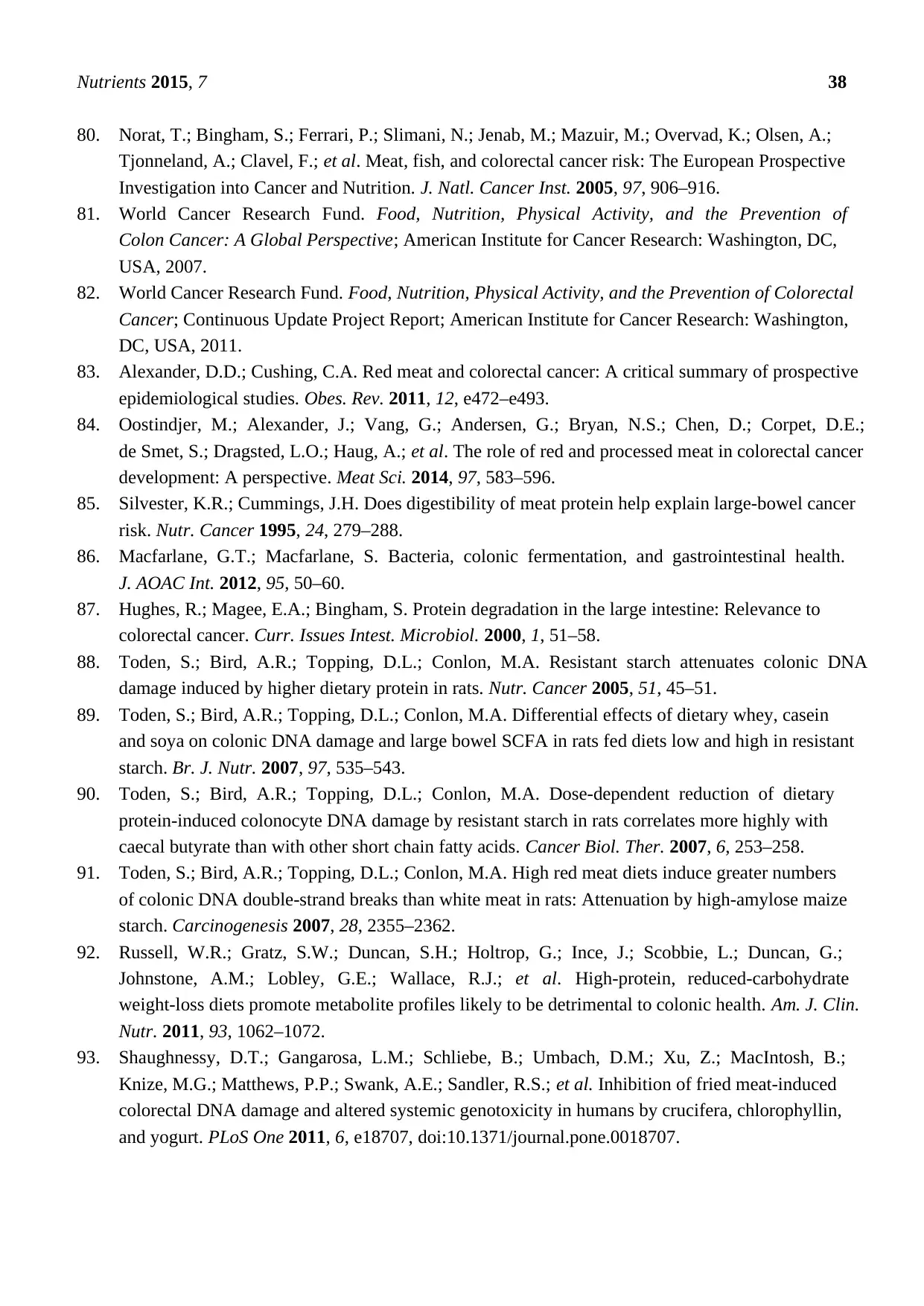
Nutrients 2015, 7 38
80. Norat, T.; Bingham, S.; Ferrari, P.; Slimani, N.; Jenab, M.; Mazuir, M.; Overvad, K.; Olsen, A.;
Tjonneland, A.; Clavel, F.; et al. Meat, fish, and colorectal cancer risk: The European Prospective
Investigation into Cancer and Nutrition. J. Natl. Cancer Inst. 2005, 97, 906–916.
81. World Cancer Research Fund. Food, Nutrition, Physical Activity, and the Prevention of
Colon Cancer: A Global Perspective; American Institute for Cancer Research: Washington, DC,
USA, 2007.
82. World Cancer Research Fund. Food, Nutrition, Physical Activity, and the Prevention of Colorectal
Cancer; Continuous Update Project Report; American Institute for Cancer Research: Washington,
DC, USA, 2011.
83. Alexander, D.D.; Cushing, C.A. Red meat and colorectal cancer: A critical summary of prospective
epidemiological studies. Obes. Rev. 2011, 12, e472–e493.
84. Oostindjer, M.; Alexander, J.; Vang, G.; Andersen, G.; Bryan, N.S.; Chen, D.; Corpet, D.E.;
de Smet, S.; Dragsted, L.O.; Haug, A.; et al. The role of red and processed meat in colorectal cancer
development: A perspective. Meat Sci. 2014, 97, 583–596.
85. Silvester, K.R.; Cummings, J.H. Does digestibility of meat protein help explain large-bowel cancer
risk. Nutr. Cancer 1995, 24, 279–288.
86. Macfarlane, G.T.; Macfarlane, S. Bacteria, colonic fermentation, and gastrointestinal health.
J. AOAC Int. 2012, 95, 50–60.
87. Hughes, R.; Magee, E.A.; Bingham, S. Protein degradation in the large intestine: Relevance to
colorectal cancer. Curr. Issues Intest. Microbiol. 2000, 1, 51–58.
88. Toden, S.; Bird, A.R.; Topping, D.L.; Conlon, M.A. Resistant starch attenuates colonic DNA
damage induced by higher dietary protein in rats. Nutr. Cancer 2005, 51, 45–51.
89. Toden, S.; Bird, A.R.; Topping, D.L.; Conlon, M.A. Differential effects of dietary whey, casein
and soya on colonic DNA damage and large bowel SCFA in rats fed diets low and high in resistant
starch. Br. J. Nutr. 2007, 97, 535–543.
90. Toden, S.; Bird, A.R.; Topping, D.L.; Conlon, M.A. Dose-dependent reduction of dietary
protein-induced colonocyte DNA damage by resistant starch in rats correlates more highly with
caecal butyrate than with other short chain fatty acids. Cancer Biol. Ther. 2007, 6, 253–258.
91. Toden, S.; Bird, A.R.; Topping, D.L.; Conlon, M.A. High red meat diets induce greater numbers
of colonic DNA double-strand breaks than white meat in rats: Attenuation by high-amylose maize
starch. Carcinogenesis 2007, 28, 2355–2362.
92. Russell, W.R.; Gratz, S.W.; Duncan, S.H.; Holtrop, G.; Ince, J.; Scobbie, L.; Duncan, G.;
Johnstone, A.M.; Lobley, G.E.; Wallace, R.J.; et al. High-protein, reduced-carbohydrate
weight-loss diets promote metabolite profiles likely to be detrimental to colonic health. Am. J. Clin.
Nutr. 2011, 93, 1062–1072.
93. Shaughnessy, D.T.; Gangarosa, L.M.; Schliebe, B.; Umbach, D.M.; Xu, Z.; MacIntosh, B.;
Knize, M.G.; Matthews, P.P.; Swank, A.E.; Sandler, R.S.; et al. Inhibition of fried meat-induced
colorectal DNA damage and altered systemic genotoxicity in humans by crucifera, chlorophyllin,
and yogurt. PLoS One 2011, 6, e18707, doi:10.1371/journal.pone.0018707.
80. Norat, T.; Bingham, S.; Ferrari, P.; Slimani, N.; Jenab, M.; Mazuir, M.; Overvad, K.; Olsen, A.;
Tjonneland, A.; Clavel, F.; et al. Meat, fish, and colorectal cancer risk: The European Prospective
Investigation into Cancer and Nutrition. J. Natl. Cancer Inst. 2005, 97, 906–916.
81. World Cancer Research Fund. Food, Nutrition, Physical Activity, and the Prevention of
Colon Cancer: A Global Perspective; American Institute for Cancer Research: Washington, DC,
USA, 2007.
82. World Cancer Research Fund. Food, Nutrition, Physical Activity, and the Prevention of Colorectal
Cancer; Continuous Update Project Report; American Institute for Cancer Research: Washington,
DC, USA, 2011.
83. Alexander, D.D.; Cushing, C.A. Red meat and colorectal cancer: A critical summary of prospective
epidemiological studies. Obes. Rev. 2011, 12, e472–e493.
84. Oostindjer, M.; Alexander, J.; Vang, G.; Andersen, G.; Bryan, N.S.; Chen, D.; Corpet, D.E.;
de Smet, S.; Dragsted, L.O.; Haug, A.; et al. The role of red and processed meat in colorectal cancer
development: A perspective. Meat Sci. 2014, 97, 583–596.
85. Silvester, K.R.; Cummings, J.H. Does digestibility of meat protein help explain large-bowel cancer
risk. Nutr. Cancer 1995, 24, 279–288.
86. Macfarlane, G.T.; Macfarlane, S. Bacteria, colonic fermentation, and gastrointestinal health.
J. AOAC Int. 2012, 95, 50–60.
87. Hughes, R.; Magee, E.A.; Bingham, S. Protein degradation in the large intestine: Relevance to
colorectal cancer. Curr. Issues Intest. Microbiol. 2000, 1, 51–58.
88. Toden, S.; Bird, A.R.; Topping, D.L.; Conlon, M.A. Resistant starch attenuates colonic DNA
damage induced by higher dietary protein in rats. Nutr. Cancer 2005, 51, 45–51.
89. Toden, S.; Bird, A.R.; Topping, D.L.; Conlon, M.A. Differential effects of dietary whey, casein
and soya on colonic DNA damage and large bowel SCFA in rats fed diets low and high in resistant
starch. Br. J. Nutr. 2007, 97, 535–543.
90. Toden, S.; Bird, A.R.; Topping, D.L.; Conlon, M.A. Dose-dependent reduction of dietary
protein-induced colonocyte DNA damage by resistant starch in rats correlates more highly with
caecal butyrate than with other short chain fatty acids. Cancer Biol. Ther. 2007, 6, 253–258.
91. Toden, S.; Bird, A.R.; Topping, D.L.; Conlon, M.A. High red meat diets induce greater numbers
of colonic DNA double-strand breaks than white meat in rats: Attenuation by high-amylose maize
starch. Carcinogenesis 2007, 28, 2355–2362.
92. Russell, W.R.; Gratz, S.W.; Duncan, S.H.; Holtrop, G.; Ince, J.; Scobbie, L.; Duncan, G.;
Johnstone, A.M.; Lobley, G.E.; Wallace, R.J.; et al. High-protein, reduced-carbohydrate
weight-loss diets promote metabolite profiles likely to be detrimental to colonic health. Am. J. Clin.
Nutr. 2011, 93, 1062–1072.
93. Shaughnessy, D.T.; Gangarosa, L.M.; Schliebe, B.; Umbach, D.M.; Xu, Z.; MacIntosh, B.;
Knize, M.G.; Matthews, P.P.; Swank, A.E.; Sandler, R.S.; et al. Inhibition of fried meat-induced
colorectal DNA damage and altered systemic genotoxicity in humans by crucifera, chlorophyllin,
and yogurt. PLoS One 2011, 6, e18707, doi:10.1371/journal.pone.0018707.
Secure Best Marks with AI Grader
Need help grading? Try our AI Grader for instant feedback on your assignments.
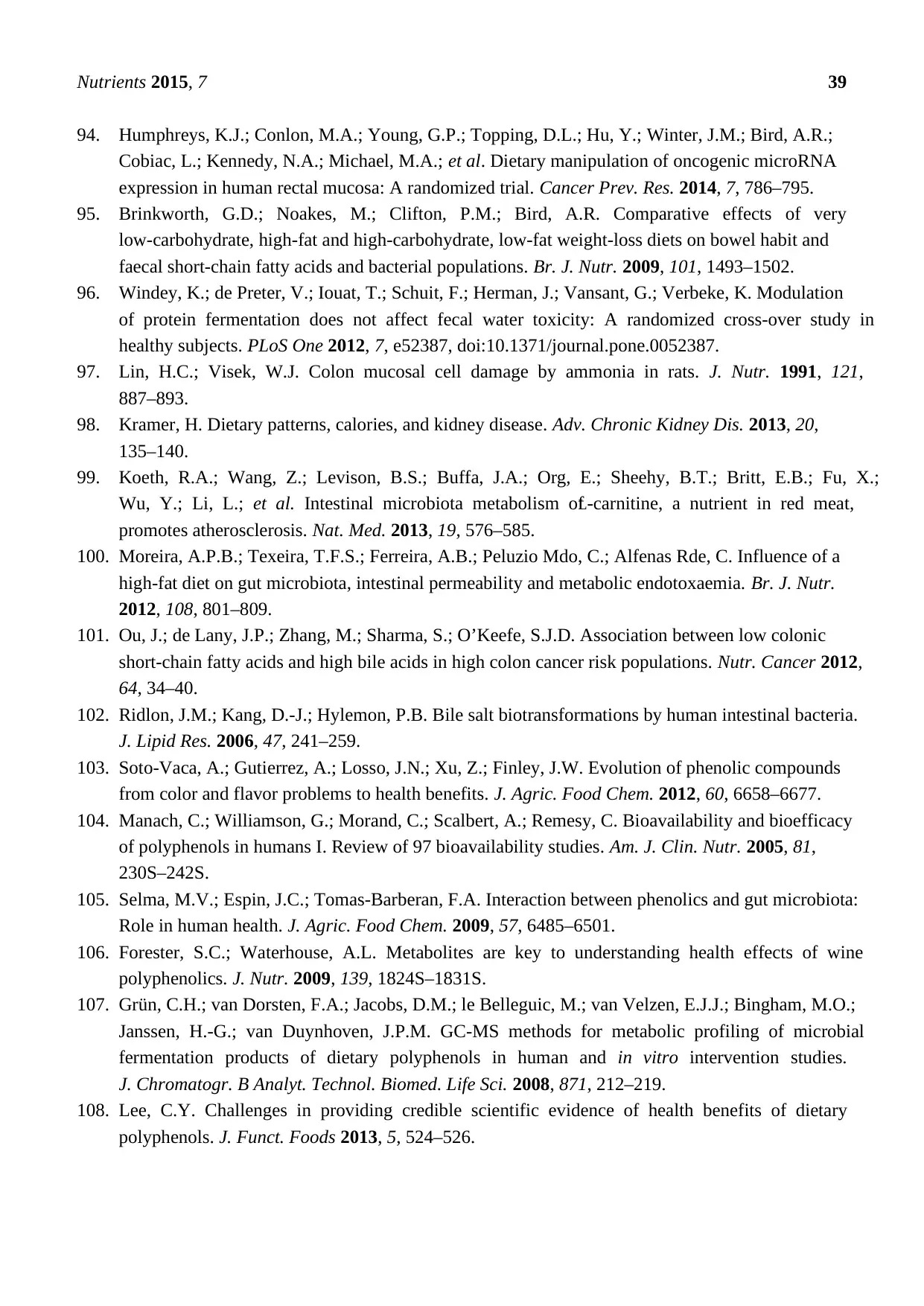
Nutrients 2015, 7 39
94. Humphreys, K.J.; Conlon, M.A.; Young, G.P.; Topping, D.L.; Hu, Y.; Winter, J.M.; Bird, A.R.;
Cobiac, L.; Kennedy, N.A.; Michael, M.A.; et al. Dietary manipulation of oncogenic microRNA
expression in human rectal mucosa: A randomized trial. Cancer Prev. Res. 2014, 7, 786–795.
95. Brinkworth, G.D.; Noakes, M.; Clifton, P.M.; Bird, A.R. Comparative effects of very
low-carbohydrate, high-fat and high-carbohydrate, low-fat weight-loss diets on bowel habit and
faecal short-chain fatty acids and bacterial populations. Br. J. Nutr. 2009, 101, 1493–1502.
96. Windey, K.; de Preter, V.; Iouat, T.; Schuit, F.; Herman, J.; Vansant, G.; Verbeke, K. Modulation
of protein fermentation does not affect fecal water toxicity: A randomized cross-over study in
healthy subjects. PLoS One 2012, 7, e52387, doi:10.1371/journal.pone.0052387.
97. Lin, H.C.; Visek, W.J. Colon mucosal cell damage by ammonia in rats. J. Nutr. 1991, 121,
887–893.
98. Kramer, H. Dietary patterns, calories, and kidney disease. Adv. Chronic Kidney Dis. 2013, 20,
135–140.
99. Koeth, R.A.; Wang, Z.; Levison, B.S.; Buffa, J.A.; Org, E.; Sheehy, B.T.; Britt, E.B.; Fu, X.;
Wu, Y.; Li, L.; et al. Intestinal microbiota metabolism ofL-carnitine, a nutrient in red meat,
promotes atherosclerosis. Nat. Med. 2013, 19, 576–585.
100. Moreira, A.P.B.; Texeira, T.F.S.; Ferreira, A.B.; Peluzio Mdo, C.; Alfenas Rde, C. Influence of a
high-fat diet on gut microbiota, intestinal permeability and metabolic endotoxaemia. Br. J. Nutr.
2012, 108, 801–809.
101. Ou, J.; de Lany, J.P.; Zhang, M.; Sharma, S.; O’Keefe, S.J.D. Association between low colonic
short-chain fatty acids and high bile acids in high colon cancer risk populations. Nutr. Cancer 2012,
64, 34–40.
102. Ridlon, J.M.; Kang, D.-J.; Hylemon, P.B. Bile salt biotransformations by human intestinal bacteria.
J. Lipid Res. 2006, 47, 241–259.
103. Soto-Vaca, A.; Gutierrez, A.; Losso, J.N.; Xu, Z.; Finley, J.W. Evolution of phenolic compounds
from color and flavor problems to health benefits. J. Agric. Food Chem. 2012, 60, 6658–6677.
104. Manach, C.; Williamson, G.; Morand, C.; Scalbert, A.; Remesy, C. Bioavailability and bioefficacy
of polyphenols in humans I. Review of 97 bioavailability studies. Am. J. Clin. Nutr. 2005, 81,
230S–242S.
105. Selma, M.V.; Espin, J.C.; Tomas-Barberan, F.A. Interaction between phenolics and gut microbiota:
Role in human health. J. Agric. Food Chem. 2009, 57, 6485–6501.
106. Forester, S.C.; Waterhouse, A.L. Metabolites are key to understanding health effects of wine
polyphenolics. J. Nutr. 2009, 139, 1824S–1831S.
107. Grün, C.H.; van Dorsten, F.A.; Jacobs, D.M.; le Belleguic, M.; van Velzen, E.J.J.; Bingham, M.O.;
Janssen, H.-G.; van Duynhoven, J.P.M. GC-MS methods for metabolic profiling of microbial
fermentation products of dietary polyphenols in human and in vitro intervention studies.
J. Chromatogr. B Analyt. Technol. Biomed. Life Sci. 2008, 871, 212–219.
108. Lee, C.Y. Challenges in providing credible scientific evidence of health benefits of dietary
polyphenols. J. Funct. Foods 2013, 5, 524–526.
94. Humphreys, K.J.; Conlon, M.A.; Young, G.P.; Topping, D.L.; Hu, Y.; Winter, J.M.; Bird, A.R.;
Cobiac, L.; Kennedy, N.A.; Michael, M.A.; et al. Dietary manipulation of oncogenic microRNA
expression in human rectal mucosa: A randomized trial. Cancer Prev. Res. 2014, 7, 786–795.
95. Brinkworth, G.D.; Noakes, M.; Clifton, P.M.; Bird, A.R. Comparative effects of very
low-carbohydrate, high-fat and high-carbohydrate, low-fat weight-loss diets on bowel habit and
faecal short-chain fatty acids and bacterial populations. Br. J. Nutr. 2009, 101, 1493–1502.
96. Windey, K.; de Preter, V.; Iouat, T.; Schuit, F.; Herman, J.; Vansant, G.; Verbeke, K. Modulation
of protein fermentation does not affect fecal water toxicity: A randomized cross-over study in
healthy subjects. PLoS One 2012, 7, e52387, doi:10.1371/journal.pone.0052387.
97. Lin, H.C.; Visek, W.J. Colon mucosal cell damage by ammonia in rats. J. Nutr. 1991, 121,
887–893.
98. Kramer, H. Dietary patterns, calories, and kidney disease. Adv. Chronic Kidney Dis. 2013, 20,
135–140.
99. Koeth, R.A.; Wang, Z.; Levison, B.S.; Buffa, J.A.; Org, E.; Sheehy, B.T.; Britt, E.B.; Fu, X.;
Wu, Y.; Li, L.; et al. Intestinal microbiota metabolism ofL-carnitine, a nutrient in red meat,
promotes atherosclerosis. Nat. Med. 2013, 19, 576–585.
100. Moreira, A.P.B.; Texeira, T.F.S.; Ferreira, A.B.; Peluzio Mdo, C.; Alfenas Rde, C. Influence of a
high-fat diet on gut microbiota, intestinal permeability and metabolic endotoxaemia. Br. J. Nutr.
2012, 108, 801–809.
101. Ou, J.; de Lany, J.P.; Zhang, M.; Sharma, S.; O’Keefe, S.J.D. Association between low colonic
short-chain fatty acids and high bile acids in high colon cancer risk populations. Nutr. Cancer 2012,
64, 34–40.
102. Ridlon, J.M.; Kang, D.-J.; Hylemon, P.B. Bile salt biotransformations by human intestinal bacteria.
J. Lipid Res. 2006, 47, 241–259.
103. Soto-Vaca, A.; Gutierrez, A.; Losso, J.N.; Xu, Z.; Finley, J.W. Evolution of phenolic compounds
from color and flavor problems to health benefits. J. Agric. Food Chem. 2012, 60, 6658–6677.
104. Manach, C.; Williamson, G.; Morand, C.; Scalbert, A.; Remesy, C. Bioavailability and bioefficacy
of polyphenols in humans I. Review of 97 bioavailability studies. Am. J. Clin. Nutr. 2005, 81,
230S–242S.
105. Selma, M.V.; Espin, J.C.; Tomas-Barberan, F.A. Interaction between phenolics and gut microbiota:
Role in human health. J. Agric. Food Chem. 2009, 57, 6485–6501.
106. Forester, S.C.; Waterhouse, A.L. Metabolites are key to understanding health effects of wine
polyphenolics. J. Nutr. 2009, 139, 1824S–1831S.
107. Grün, C.H.; van Dorsten, F.A.; Jacobs, D.M.; le Belleguic, M.; van Velzen, E.J.J.; Bingham, M.O.;
Janssen, H.-G.; van Duynhoven, J.P.M. GC-MS methods for metabolic profiling of microbial
fermentation products of dietary polyphenols in human and in vitro intervention studies.
J. Chromatogr. B Analyt. Technol. Biomed. Life Sci. 2008, 871, 212–219.
108. Lee, C.Y. Challenges in providing credible scientific evidence of health benefits of dietary
polyphenols. J. Funct. Foods 2013, 5, 524–526.
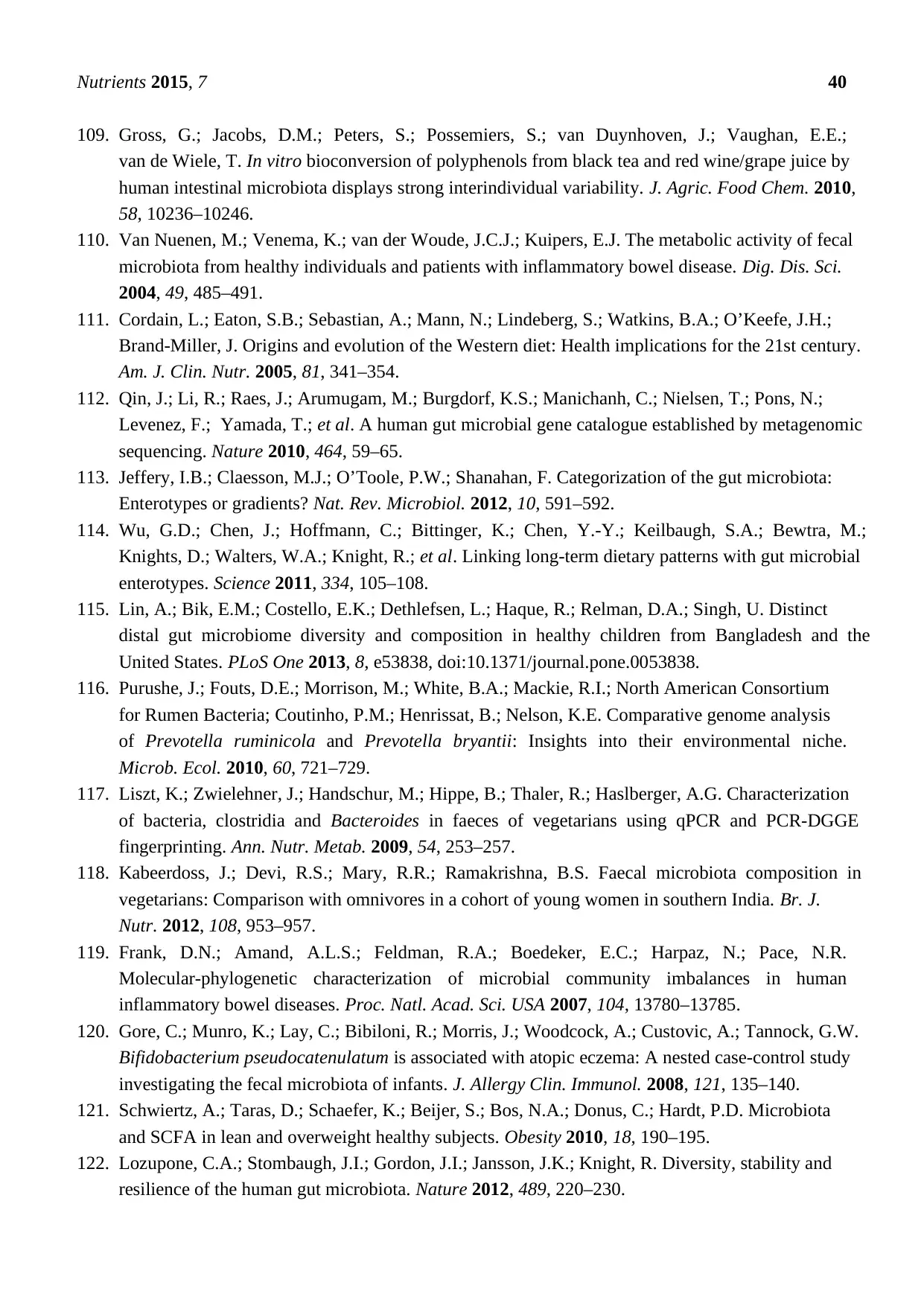
Nutrients 2015, 7 40
109. Gross, G.; Jacobs, D.M.; Peters, S.; Possemiers, S.; van Duynhoven, J.; Vaughan, E.E.;
van de Wiele, T. In vitro bioconversion of polyphenols from black tea and red wine/grape juice by
human intestinal microbiota displays strong interindividual variability. J. Agric. Food Chem. 2010,
58, 10236–10246.
110. Van Nuenen, M.; Venema, K.; van der Woude, J.C.J.; Kuipers, E.J. The metabolic activity of fecal
microbiota from healthy individuals and patients with inflammatory bowel disease. Dig. Dis. Sci.
2004, 49, 485–491.
111. Cordain, L.; Eaton, S.B.; Sebastian, A.; Mann, N.; Lindeberg, S.; Watkins, B.A.; O’Keefe, J.H.;
Brand-Miller, J. Origins and evolution of the Western diet: Health implications for the 21st century.
Am. J. Clin. Nutr. 2005, 81, 341–354.
112. Qin, J.; Li, R.; Raes, J.; Arumugam, M.; Burgdorf, K.S.; Manichanh, C.; Nielsen, T.; Pons, N.;
Levenez, F.; Yamada, T.; et al. A human gut microbial gene catalogue established by metagenomic
sequencing. Nature 2010, 464, 59–65.
113. Jeffery, I.B.; Claesson, M.J.; O’Toole, P.W.; Shanahan, F. Categorization of the gut microbiota:
Enterotypes or gradients? Nat. Rev. Microbiol. 2012, 10, 591–592.
114. Wu, G.D.; Chen, J.; Hoffmann, C.; Bittinger, K.; Chen, Y.-Y.; Keilbaugh, S.A.; Bewtra, M.;
Knights, D.; Walters, W.A.; Knight, R.; et al. Linking long-term dietary patterns with gut microbial
enterotypes. Science 2011, 334, 105–108.
115. Lin, A.; Bik, E.M.; Costello, E.K.; Dethlefsen, L.; Haque, R.; Relman, D.A.; Singh, U. Distinct
distal gut microbiome diversity and composition in healthy children from Bangladesh and the
United States. PLoS One 2013, 8, e53838, doi:10.1371/journal.pone.0053838.
116. Purushe, J.; Fouts, D.E.; Morrison, M.; White, B.A.; Mackie, R.I.; North American Consortium
for Rumen Bacteria; Coutinho, P.M.; Henrissat, B.; Nelson, K.E. Comparative genome analysis
of Prevotella ruminicola and Prevotella bryantii: Insights into their environmental niche.
Microb. Ecol. 2010, 60, 721–729.
117. Liszt, K.; Zwielehner, J.; Handschur, M.; Hippe, B.; Thaler, R.; Haslberger, A.G. Characterization
of bacteria, clostridia and Bacteroides in faeces of vegetarians using qPCR and PCR-DGGE
fingerprinting. Ann. Nutr. Metab. 2009, 54, 253–257.
118. Kabeerdoss, J.; Devi, R.S.; Mary, R.R.; Ramakrishna, B.S. Faecal microbiota composition in
vegetarians: Comparison with omnivores in a cohort of young women in southern India. Br. J.
Nutr. 2012, 108, 953–957.
119. Frank, D.N.; Amand, A.L.S.; Feldman, R.A.; Boedeker, E.C.; Harpaz, N.; Pace, N.R.
Molecular-phylogenetic characterization of microbial community imbalances in human
inflammatory bowel diseases. Proc. Natl. Acad. Sci. USA 2007, 104, 13780–13785.
120. Gore, C.; Munro, K.; Lay, C.; Bibiloni, R.; Morris, J.; Woodcock, A.; Custovic, A.; Tannock, G.W.
Bifidobacterium pseudocatenulatum is associated with atopic eczema: A nested case-control study
investigating the fecal microbiota of infants. J. Allergy Clin. Immunol. 2008, 121, 135–140.
121. Schwiertz, A.; Taras, D.; Schaefer, K.; Beijer, S.; Bos, N.A.; Donus, C.; Hardt, P.D. Microbiota
and SCFA in lean and overweight healthy subjects. Obesity 2010, 18, 190–195.
122. Lozupone, C.A.; Stombaugh, J.I.; Gordon, J.I.; Jansson, J.K.; Knight, R. Diversity, stability and
resilience of the human gut microbiota. Nature 2012, 489, 220–230.
109. Gross, G.; Jacobs, D.M.; Peters, S.; Possemiers, S.; van Duynhoven, J.; Vaughan, E.E.;
van de Wiele, T. In vitro bioconversion of polyphenols from black tea and red wine/grape juice by
human intestinal microbiota displays strong interindividual variability. J. Agric. Food Chem. 2010,
58, 10236–10246.
110. Van Nuenen, M.; Venema, K.; van der Woude, J.C.J.; Kuipers, E.J. The metabolic activity of fecal
microbiota from healthy individuals and patients with inflammatory bowel disease. Dig. Dis. Sci.
2004, 49, 485–491.
111. Cordain, L.; Eaton, S.B.; Sebastian, A.; Mann, N.; Lindeberg, S.; Watkins, B.A.; O’Keefe, J.H.;
Brand-Miller, J. Origins and evolution of the Western diet: Health implications for the 21st century.
Am. J. Clin. Nutr. 2005, 81, 341–354.
112. Qin, J.; Li, R.; Raes, J.; Arumugam, M.; Burgdorf, K.S.; Manichanh, C.; Nielsen, T.; Pons, N.;
Levenez, F.; Yamada, T.; et al. A human gut microbial gene catalogue established by metagenomic
sequencing. Nature 2010, 464, 59–65.
113. Jeffery, I.B.; Claesson, M.J.; O’Toole, P.W.; Shanahan, F. Categorization of the gut microbiota:
Enterotypes or gradients? Nat. Rev. Microbiol. 2012, 10, 591–592.
114. Wu, G.D.; Chen, J.; Hoffmann, C.; Bittinger, K.; Chen, Y.-Y.; Keilbaugh, S.A.; Bewtra, M.;
Knights, D.; Walters, W.A.; Knight, R.; et al. Linking long-term dietary patterns with gut microbial
enterotypes. Science 2011, 334, 105–108.
115. Lin, A.; Bik, E.M.; Costello, E.K.; Dethlefsen, L.; Haque, R.; Relman, D.A.; Singh, U. Distinct
distal gut microbiome diversity and composition in healthy children from Bangladesh and the
United States. PLoS One 2013, 8, e53838, doi:10.1371/journal.pone.0053838.
116. Purushe, J.; Fouts, D.E.; Morrison, M.; White, B.A.; Mackie, R.I.; North American Consortium
for Rumen Bacteria; Coutinho, P.M.; Henrissat, B.; Nelson, K.E. Comparative genome analysis
of Prevotella ruminicola and Prevotella bryantii: Insights into their environmental niche.
Microb. Ecol. 2010, 60, 721–729.
117. Liszt, K.; Zwielehner, J.; Handschur, M.; Hippe, B.; Thaler, R.; Haslberger, A.G. Characterization
of bacteria, clostridia and Bacteroides in faeces of vegetarians using qPCR and PCR-DGGE
fingerprinting. Ann. Nutr. Metab. 2009, 54, 253–257.
118. Kabeerdoss, J.; Devi, R.S.; Mary, R.R.; Ramakrishna, B.S. Faecal microbiota composition in
vegetarians: Comparison with omnivores in a cohort of young women in southern India. Br. J.
Nutr. 2012, 108, 953–957.
119. Frank, D.N.; Amand, A.L.S.; Feldman, R.A.; Boedeker, E.C.; Harpaz, N.; Pace, N.R.
Molecular-phylogenetic characterization of microbial community imbalances in human
inflammatory bowel diseases. Proc. Natl. Acad. Sci. USA 2007, 104, 13780–13785.
120. Gore, C.; Munro, K.; Lay, C.; Bibiloni, R.; Morris, J.; Woodcock, A.; Custovic, A.; Tannock, G.W.
Bifidobacterium pseudocatenulatum is associated with atopic eczema: A nested case-control study
investigating the fecal microbiota of infants. J. Allergy Clin. Immunol. 2008, 121, 135–140.
121. Schwiertz, A.; Taras, D.; Schaefer, K.; Beijer, S.; Bos, N.A.; Donus, C.; Hardt, P.D. Microbiota
and SCFA in lean and overweight healthy subjects. Obesity 2010, 18, 190–195.
122. Lozupone, C.A.; Stombaugh, J.I.; Gordon, J.I.; Jansson, J.K.; Knight, R. Diversity, stability and
resilience of the human gut microbiota. Nature 2012, 489, 220–230.
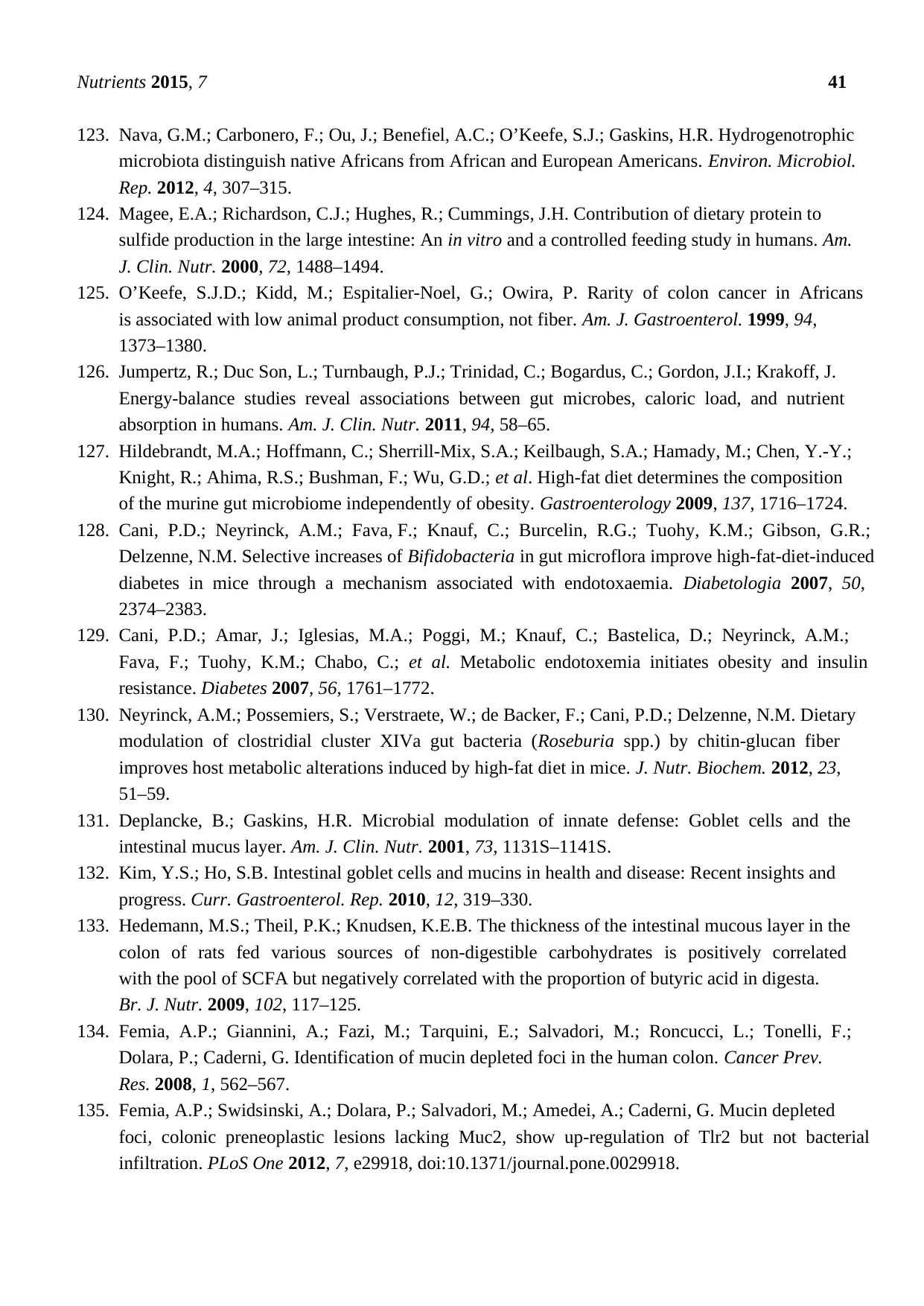
Nutrients 2015, 7 41
123. Nava, G.M.; Carbonero, F.; Ou, J.; Benefiel, A.C.; O’Keefe, S.J.; Gaskins, H.R. Hydrogenotrophic
microbiota distinguish native Africans from African and European Americans. Environ. Microbiol.
Rep. 2012, 4, 307–315.
124. Magee, E.A.; Richardson, C.J.; Hughes, R.; Cummings, J.H. Contribution of dietary protein to
sulfide production in the large intestine: An in vitro and a controlled feeding study in humans. Am.
J. Clin. Nutr. 2000, 72, 1488–1494.
125. O’Keefe, S.J.D.; Kidd, M.; Espitalier-Noel, G.; Owira, P. Rarity of colon cancer in Africans
is associated with low animal product consumption, not fiber. Am. J. Gastroenterol. 1999, 94,
1373–1380.
126. Jumpertz, R.; Duc Son, L.; Turnbaugh, P.J.; Trinidad, C.; Bogardus, C.; Gordon, J.I.; Krakoff, J.
Energy-balance studies reveal associations between gut microbes, caloric load, and nutrient
absorption in humans. Am. J. Clin. Nutr. 2011, 94, 58–65.
127. Hildebrandt, M.A.; Hoffmann, C.; Sherrill-Mix, S.A.; Keilbaugh, S.A.; Hamady, M.; Chen, Y.-Y.;
Knight, R.; Ahima, R.S.; Bushman, F.; Wu, G.D.; et al. High-fat diet determines the composition
of the murine gut microbiome independently of obesity. Gastroenterology 2009, 137, 1716–1724.
128. Cani, P.D.; Neyrinck, A.M.; Fava, F.; Knauf, C.; Burcelin, R.G.; Tuohy, K.M.; Gibson, G.R.;
Delzenne, N.M. Selective increases of Bifidobacteria in gut microflora improve high-fat-diet-induced
diabetes in mice through a mechanism associated with endotoxaemia. Diabetologia 2007, 50,
2374–2383.
129. Cani, P.D.; Amar, J.; Iglesias, M.A.; Poggi, M.; Knauf, C.; Bastelica, D.; Neyrinck, A.M.;
Fava, F.; Tuohy, K.M.; Chabo, C.; et al. Metabolic endotoxemia initiates obesity and insulin
resistance. Diabetes 2007, 56, 1761–1772.
130. Neyrinck, A.M.; Possemiers, S.; Verstraete, W.; de Backer, F.; Cani, P.D.; Delzenne, N.M. Dietary
modulation of clostridial cluster XIVa gut bacteria (Roseburia spp.) by chitin-glucan fiber
improves host metabolic alterations induced by high-fat diet in mice. J. Nutr. Biochem. 2012, 23,
51–59.
131. Deplancke, B.; Gaskins, H.R. Microbial modulation of innate defense: Goblet cells and the
intestinal mucus layer. Am. J. Clin. Nutr. 2001, 73, 1131S–1141S.
132. Kim, Y.S.; Ho, S.B. Intestinal goblet cells and mucins in health and disease: Recent insights and
progress. Curr. Gastroenterol. Rep. 2010, 12, 319–330.
133. Hedemann, M.S.; Theil, P.K.; Knudsen, K.E.B. The thickness of the intestinal mucous layer in the
colon of rats fed various sources of non-digestible carbohydrates is positively correlated
with the pool of SCFA but negatively correlated with the proportion of butyric acid in digesta.
Br. J. Nutr. 2009, 102, 117–125.
134. Femia, A.P.; Giannini, A.; Fazi, M.; Tarquini, E.; Salvadori, M.; Roncucci, L.; Tonelli, F.;
Dolara, P.; Caderni, G. Identification of mucin depleted foci in the human colon. Cancer Prev.
Res. 2008, 1, 562–567.
135. Femia, A.P.; Swidsinski, A.; Dolara, P.; Salvadori, M.; Amedei, A.; Caderni, G. Mucin depleted
foci, colonic preneoplastic lesions lacking Muc2, show up-regulation of Tlr2 but not bacterial
infiltration. PLoS One 2012, 7, e29918, doi:10.1371/journal.pone.0029918.
123. Nava, G.M.; Carbonero, F.; Ou, J.; Benefiel, A.C.; O’Keefe, S.J.; Gaskins, H.R. Hydrogenotrophic
microbiota distinguish native Africans from African and European Americans. Environ. Microbiol.
Rep. 2012, 4, 307–315.
124. Magee, E.A.; Richardson, C.J.; Hughes, R.; Cummings, J.H. Contribution of dietary protein to
sulfide production in the large intestine: An in vitro and a controlled feeding study in humans. Am.
J. Clin. Nutr. 2000, 72, 1488–1494.
125. O’Keefe, S.J.D.; Kidd, M.; Espitalier-Noel, G.; Owira, P. Rarity of colon cancer in Africans
is associated with low animal product consumption, not fiber. Am. J. Gastroenterol. 1999, 94,
1373–1380.
126. Jumpertz, R.; Duc Son, L.; Turnbaugh, P.J.; Trinidad, C.; Bogardus, C.; Gordon, J.I.; Krakoff, J.
Energy-balance studies reveal associations between gut microbes, caloric load, and nutrient
absorption in humans. Am. J. Clin. Nutr. 2011, 94, 58–65.
127. Hildebrandt, M.A.; Hoffmann, C.; Sherrill-Mix, S.A.; Keilbaugh, S.A.; Hamady, M.; Chen, Y.-Y.;
Knight, R.; Ahima, R.S.; Bushman, F.; Wu, G.D.; et al. High-fat diet determines the composition
of the murine gut microbiome independently of obesity. Gastroenterology 2009, 137, 1716–1724.
128. Cani, P.D.; Neyrinck, A.M.; Fava, F.; Knauf, C.; Burcelin, R.G.; Tuohy, K.M.; Gibson, G.R.;
Delzenne, N.M. Selective increases of Bifidobacteria in gut microflora improve high-fat-diet-induced
diabetes in mice through a mechanism associated with endotoxaemia. Diabetologia 2007, 50,
2374–2383.
129. Cani, P.D.; Amar, J.; Iglesias, M.A.; Poggi, M.; Knauf, C.; Bastelica, D.; Neyrinck, A.M.;
Fava, F.; Tuohy, K.M.; Chabo, C.; et al. Metabolic endotoxemia initiates obesity and insulin
resistance. Diabetes 2007, 56, 1761–1772.
130. Neyrinck, A.M.; Possemiers, S.; Verstraete, W.; de Backer, F.; Cani, P.D.; Delzenne, N.M. Dietary
modulation of clostridial cluster XIVa gut bacteria (Roseburia spp.) by chitin-glucan fiber
improves host metabolic alterations induced by high-fat diet in mice. J. Nutr. Biochem. 2012, 23,
51–59.
131. Deplancke, B.; Gaskins, H.R. Microbial modulation of innate defense: Goblet cells and the
intestinal mucus layer. Am. J. Clin. Nutr. 2001, 73, 1131S–1141S.
132. Kim, Y.S.; Ho, S.B. Intestinal goblet cells and mucins in health and disease: Recent insights and
progress. Curr. Gastroenterol. Rep. 2010, 12, 319–330.
133. Hedemann, M.S.; Theil, P.K.; Knudsen, K.E.B. The thickness of the intestinal mucous layer in the
colon of rats fed various sources of non-digestible carbohydrates is positively correlated
with the pool of SCFA but negatively correlated with the proportion of butyric acid in digesta.
Br. J. Nutr. 2009, 102, 117–125.
134. Femia, A.P.; Giannini, A.; Fazi, M.; Tarquini, E.; Salvadori, M.; Roncucci, L.; Tonelli, F.;
Dolara, P.; Caderni, G. Identification of mucin depleted foci in the human colon. Cancer Prev.
Res. 2008, 1, 562–567.
135. Femia, A.P.; Swidsinski, A.; Dolara, P.; Salvadori, M.; Amedei, A.; Caderni, G. Mucin depleted
foci, colonic preneoplastic lesions lacking Muc2, show up-regulation of Tlr2 but not bacterial
infiltration. PLoS One 2012, 7, e29918, doi:10.1371/journal.pone.0029918.
Paraphrase This Document
Need a fresh take? Get an instant paraphrase of this document with our AI Paraphraser
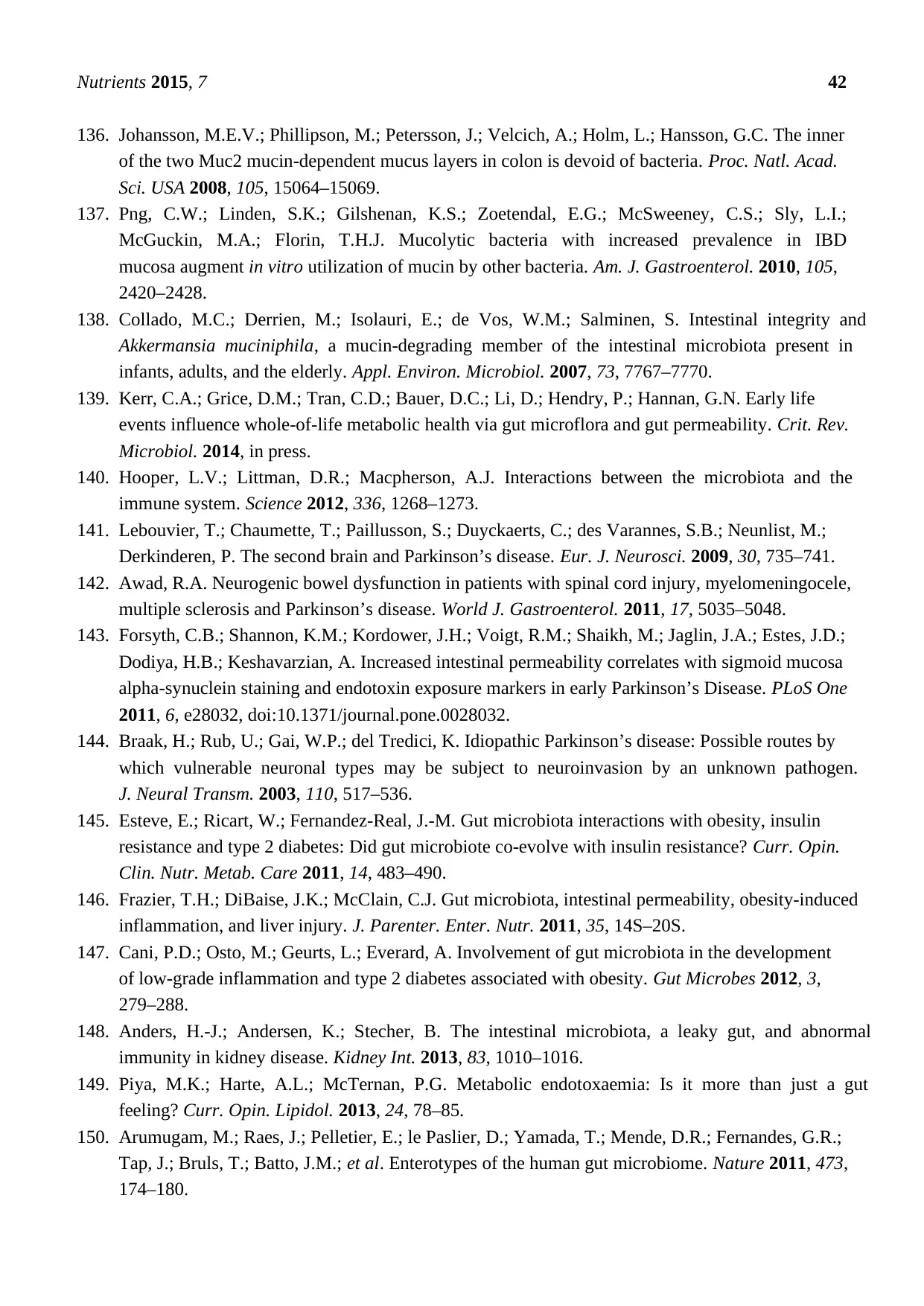
Nutrients 2015, 7 42
136. Johansson, M.E.V.; Phillipson, M.; Petersson, J.; Velcich, A.; Holm, L.; Hansson, G.C. The inner
of the two Muc2 mucin-dependent mucus layers in colon is devoid of bacteria. Proc. Natl. Acad.
Sci. USA 2008, 105, 15064–15069.
137. Png, C.W.; Linden, S.K.; Gilshenan, K.S.; Zoetendal, E.G.; McSweeney, C.S.; Sly, L.I.;
McGuckin, M.A.; Florin, T.H.J. Mucolytic bacteria with increased prevalence in IBD
mucosa augment in vitro utilization of mucin by other bacteria. Am. J. Gastroenterol. 2010, 105,
2420–2428.
138. Collado, M.C.; Derrien, M.; Isolauri, E.; de Vos, W.M.; Salminen, S. Intestinal integrity and
Akkermansia muciniphila, a mucin-degrading member of the intestinal microbiota present in
infants, adults, and the elderly. Appl. Environ. Microbiol. 2007, 73, 7767–7770.
139. Kerr, C.A.; Grice, D.M.; Tran, C.D.; Bauer, D.C.; Li, D.; Hendry, P.; Hannan, G.N. Early life
events influence whole-of-life metabolic health via gut microflora and gut permeability. Crit. Rev.
Microbiol. 2014, in press.
140. Hooper, L.V.; Littman, D.R.; Macpherson, A.J. Interactions between the microbiota and the
immune system. Science 2012, 336, 1268–1273.
141. Lebouvier, T.; Chaumette, T.; Paillusson, S.; Duyckaerts, C.; des Varannes, S.B.; Neunlist, M.;
Derkinderen, P. The second brain and Parkinson’s disease. Eur. J. Neurosci. 2009, 30, 735–741.
142. Awad, R.A. Neurogenic bowel dysfunction in patients with spinal cord injury, myelomeningocele,
multiple sclerosis and Parkinson’s disease. World J. Gastroenterol. 2011, 17, 5035–5048.
143. Forsyth, C.B.; Shannon, K.M.; Kordower, J.H.; Voigt, R.M.; Shaikh, M.; Jaglin, J.A.; Estes, J.D.;
Dodiya, H.B.; Keshavarzian, A. Increased intestinal permeability correlates with sigmoid mucosa
alpha-synuclein staining and endotoxin exposure markers in early Parkinson’s Disease. PLoS One
2011, 6, e28032, doi:10.1371/journal.pone.0028032.
144. Braak, H.; Rub, U.; Gai, W.P.; del Tredici, K. Idiopathic Parkinson’s disease: Possible routes by
which vulnerable neuronal types may be subject to neuroinvasion by an unknown pathogen.
J. Neural Transm. 2003, 110, 517–536.
145. Esteve, E.; Ricart, W.; Fernandez-Real, J.-M. Gut microbiota interactions with obesity, insulin
resistance and type 2 diabetes: Did gut microbiote co-evolve with insulin resistance? Curr. Opin.
Clin. Nutr. Metab. Care 2011, 14, 483–490.
146. Frazier, T.H.; DiBaise, J.K.; McClain, C.J. Gut microbiota, intestinal permeability, obesity-induced
inflammation, and liver injury. J. Parenter. Enter. Nutr. 2011, 35, 14S–20S.
147. Cani, P.D.; Osto, M.; Geurts, L.; Everard, A. Involvement of gut microbiota in the development
of low-grade inflammation and type 2 diabetes associated with obesity. Gut Microbes 2012, 3,
279–288.
148. Anders, H.-J.; Andersen, K.; Stecher, B. The intestinal microbiota, a leaky gut, and abnormal
immunity in kidney disease. Kidney Int. 2013, 83, 1010–1016.
149. Piya, M.K.; Harte, A.L.; McTernan, P.G. Metabolic endotoxaemia: Is it more than just a gut
feeling? Curr. Opin. Lipidol. 2013, 24, 78–85.
150. Arumugam, M.; Raes, J.; Pelletier, E.; le Paslier, D.; Yamada, T.; Mende, D.R.; Fernandes, G.R.;
Tap, J.; Bruls, T.; Batto, J.M.; et al. Enterotypes of the human gut microbiome. Nature 2011, 473,
174–180.
136. Johansson, M.E.V.; Phillipson, M.; Petersson, J.; Velcich, A.; Holm, L.; Hansson, G.C. The inner
of the two Muc2 mucin-dependent mucus layers in colon is devoid of bacteria. Proc. Natl. Acad.
Sci. USA 2008, 105, 15064–15069.
137. Png, C.W.; Linden, S.K.; Gilshenan, K.S.; Zoetendal, E.G.; McSweeney, C.S.; Sly, L.I.;
McGuckin, M.A.; Florin, T.H.J. Mucolytic bacteria with increased prevalence in IBD
mucosa augment in vitro utilization of mucin by other bacteria. Am. J. Gastroenterol. 2010, 105,
2420–2428.
138. Collado, M.C.; Derrien, M.; Isolauri, E.; de Vos, W.M.; Salminen, S. Intestinal integrity and
Akkermansia muciniphila, a mucin-degrading member of the intestinal microbiota present in
infants, adults, and the elderly. Appl. Environ. Microbiol. 2007, 73, 7767–7770.
139. Kerr, C.A.; Grice, D.M.; Tran, C.D.; Bauer, D.C.; Li, D.; Hendry, P.; Hannan, G.N. Early life
events influence whole-of-life metabolic health via gut microflora and gut permeability. Crit. Rev.
Microbiol. 2014, in press.
140. Hooper, L.V.; Littman, D.R.; Macpherson, A.J. Interactions between the microbiota and the
immune system. Science 2012, 336, 1268–1273.
141. Lebouvier, T.; Chaumette, T.; Paillusson, S.; Duyckaerts, C.; des Varannes, S.B.; Neunlist, M.;
Derkinderen, P. The second brain and Parkinson’s disease. Eur. J. Neurosci. 2009, 30, 735–741.
142. Awad, R.A. Neurogenic bowel dysfunction in patients with spinal cord injury, myelomeningocele,
multiple sclerosis and Parkinson’s disease. World J. Gastroenterol. 2011, 17, 5035–5048.
143. Forsyth, C.B.; Shannon, K.M.; Kordower, J.H.; Voigt, R.M.; Shaikh, M.; Jaglin, J.A.; Estes, J.D.;
Dodiya, H.B.; Keshavarzian, A. Increased intestinal permeability correlates with sigmoid mucosa
alpha-synuclein staining and endotoxin exposure markers in early Parkinson’s Disease. PLoS One
2011, 6, e28032, doi:10.1371/journal.pone.0028032.
144. Braak, H.; Rub, U.; Gai, W.P.; del Tredici, K. Idiopathic Parkinson’s disease: Possible routes by
which vulnerable neuronal types may be subject to neuroinvasion by an unknown pathogen.
J. Neural Transm. 2003, 110, 517–536.
145. Esteve, E.; Ricart, W.; Fernandez-Real, J.-M. Gut microbiota interactions with obesity, insulin
resistance and type 2 diabetes: Did gut microbiote co-evolve with insulin resistance? Curr. Opin.
Clin. Nutr. Metab. Care 2011, 14, 483–490.
146. Frazier, T.H.; DiBaise, J.K.; McClain, C.J. Gut microbiota, intestinal permeability, obesity-induced
inflammation, and liver injury. J. Parenter. Enter. Nutr. 2011, 35, 14S–20S.
147. Cani, P.D.; Osto, M.; Geurts, L.; Everard, A. Involvement of gut microbiota in the development
of low-grade inflammation and type 2 diabetes associated with obesity. Gut Microbes 2012, 3,
279–288.
148. Anders, H.-J.; Andersen, K.; Stecher, B. The intestinal microbiota, a leaky gut, and abnormal
immunity in kidney disease. Kidney Int. 2013, 83, 1010–1016.
149. Piya, M.K.; Harte, A.L.; McTernan, P.G. Metabolic endotoxaemia: Is it more than just a gut
feeling? Curr. Opin. Lipidol. 2013, 24, 78–85.
150. Arumugam, M.; Raes, J.; Pelletier, E.; le Paslier, D.; Yamada, T.; Mende, D.R.; Fernandes, G.R.;
Tap, J.; Bruls, T.; Batto, J.M.; et al. Enterotypes of the human gut microbiome. Nature 2011, 473,
174–180.
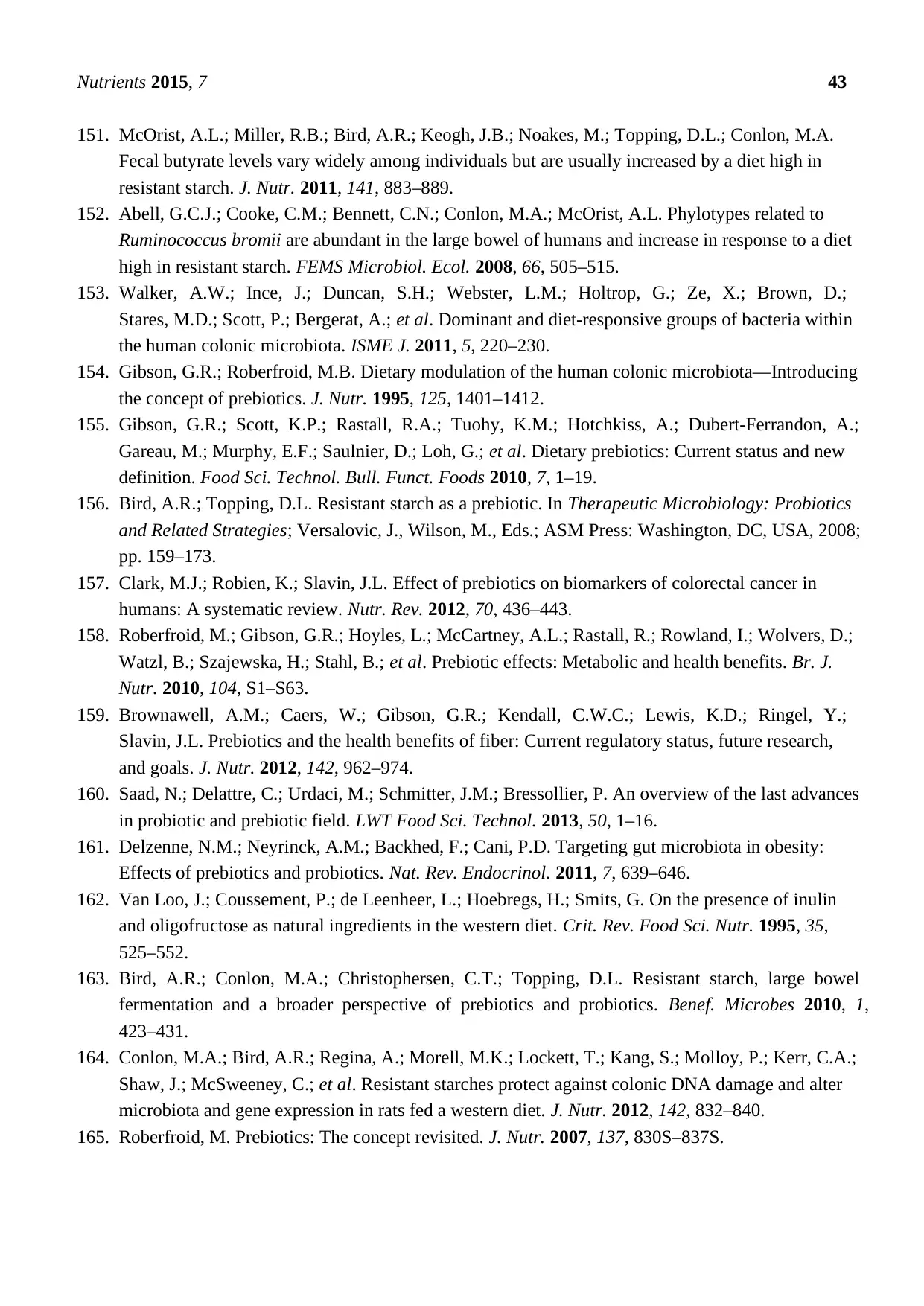
Nutrients 2015, 7 43
151. McOrist, A.L.; Miller, R.B.; Bird, A.R.; Keogh, J.B.; Noakes, M.; Topping, D.L.; Conlon, M.A.
Fecal butyrate levels vary widely among individuals but are usually increased by a diet high in
resistant starch. J. Nutr. 2011, 141, 883–889.
152. Abell, G.C.J.; Cooke, C.M.; Bennett, C.N.; Conlon, M.A.; McOrist, A.L. Phylotypes related to
Ruminococcus bromii are abundant in the large bowel of humans and increase in response to a diet
high in resistant starch. FEMS Microbiol. Ecol. 2008, 66, 505–515.
153. Walker, A.W.; Ince, J.; Duncan, S.H.; Webster, L.M.; Holtrop, G.; Ze, X.; Brown, D.;
Stares, M.D.; Scott, P.; Bergerat, A.; et al. Dominant and diet-responsive groups of bacteria within
the human colonic microbiota. ISME J. 2011, 5, 220–230.
154. Gibson, G.R.; Roberfroid, M.B. Dietary modulation of the human colonic microbiota—Introducing
the concept of prebiotics. J. Nutr. 1995, 125, 1401–1412.
155. Gibson, G.R.; Scott, K.P.; Rastall, R.A.; Tuohy, K.M.; Hotchkiss, A.; Dubert-Ferrandon, A.;
Gareau, M.; Murphy, E.F.; Saulnier, D.; Loh, G.; et al. Dietary prebiotics: Current status and new
definition. Food Sci. Technol. Bull. Funct. Foods 2010, 7, 1–19.
156. Bird, A.R.; Topping, D.L. Resistant starch as a prebiotic. In Therapeutic Microbiology: Probiotics
and Related Strategies; Versalovic, J., Wilson, M., Eds.; ASM Press: Washington, DC, USA, 2008;
pp. 159–173.
157. Clark, M.J.; Robien, K.; Slavin, J.L. Effect of prebiotics on biomarkers of colorectal cancer in
humans: A systematic review. Nutr. Rev. 2012, 70, 436–443.
158. Roberfroid, M.; Gibson, G.R.; Hoyles, L.; McCartney, A.L.; Rastall, R.; Rowland, I.; Wolvers, D.;
Watzl, B.; Szajewska, H.; Stahl, B.; et al. Prebiotic effects: Metabolic and health benefits. Br. J.
Nutr. 2010, 104, S1–S63.
159. Brownawell, A.M.; Caers, W.; Gibson, G.R.; Kendall, C.W.C.; Lewis, K.D.; Ringel, Y.;
Slavin, J.L. Prebiotics and the health benefits of fiber: Current regulatory status, future research,
and goals. J. Nutr. 2012, 142, 962–974.
160. Saad, N.; Delattre, C.; Urdaci, M.; Schmitter, J.M.; Bressollier, P. An overview of the last advances
in probiotic and prebiotic field. LWT Food Sci. Technol. 2013, 50, 1–16.
161. Delzenne, N.M.; Neyrinck, A.M.; Backhed, F.; Cani, P.D. Targeting gut microbiota in obesity:
Effects of prebiotics and probiotics. Nat. Rev. Endocrinol. 2011, 7, 639–646.
162. Van Loo, J.; Coussement, P.; de Leenheer, L.; Hoebregs, H.; Smits, G. On the presence of inulin
and oligofructose as natural ingredients in the western diet. Crit. Rev. Food Sci. Nutr. 1995, 35,
525–552.
163. Bird, A.R.; Conlon, M.A.; Christophersen, C.T.; Topping, D.L. Resistant starch, large bowel
fermentation and a broader perspective of prebiotics and probiotics. Benef. Microbes 2010, 1,
423–431.
164. Conlon, M.A.; Bird, A.R.; Regina, A.; Morell, M.K.; Lockett, T.; Kang, S.; Molloy, P.; Kerr, C.A.;
Shaw, J.; McSweeney, C.; et al. Resistant starches protect against colonic DNA damage and alter
microbiota and gene expression in rats fed a western diet. J. Nutr. 2012, 142, 832–840.
165. Roberfroid, M. Prebiotics: The concept revisited. J. Nutr. 2007, 137, 830S–837S.
151. McOrist, A.L.; Miller, R.B.; Bird, A.R.; Keogh, J.B.; Noakes, M.; Topping, D.L.; Conlon, M.A.
Fecal butyrate levels vary widely among individuals but are usually increased by a diet high in
resistant starch. J. Nutr. 2011, 141, 883–889.
152. Abell, G.C.J.; Cooke, C.M.; Bennett, C.N.; Conlon, M.A.; McOrist, A.L. Phylotypes related to
Ruminococcus bromii are abundant in the large bowel of humans and increase in response to a diet
high in resistant starch. FEMS Microbiol. Ecol. 2008, 66, 505–515.
153. Walker, A.W.; Ince, J.; Duncan, S.H.; Webster, L.M.; Holtrop, G.; Ze, X.; Brown, D.;
Stares, M.D.; Scott, P.; Bergerat, A.; et al. Dominant and diet-responsive groups of bacteria within
the human colonic microbiota. ISME J. 2011, 5, 220–230.
154. Gibson, G.R.; Roberfroid, M.B. Dietary modulation of the human colonic microbiota—Introducing
the concept of prebiotics. J. Nutr. 1995, 125, 1401–1412.
155. Gibson, G.R.; Scott, K.P.; Rastall, R.A.; Tuohy, K.M.; Hotchkiss, A.; Dubert-Ferrandon, A.;
Gareau, M.; Murphy, E.F.; Saulnier, D.; Loh, G.; et al. Dietary prebiotics: Current status and new
definition. Food Sci. Technol. Bull. Funct. Foods 2010, 7, 1–19.
156. Bird, A.R.; Topping, D.L. Resistant starch as a prebiotic. In Therapeutic Microbiology: Probiotics
and Related Strategies; Versalovic, J., Wilson, M., Eds.; ASM Press: Washington, DC, USA, 2008;
pp. 159–173.
157. Clark, M.J.; Robien, K.; Slavin, J.L. Effect of prebiotics on biomarkers of colorectal cancer in
humans: A systematic review. Nutr. Rev. 2012, 70, 436–443.
158. Roberfroid, M.; Gibson, G.R.; Hoyles, L.; McCartney, A.L.; Rastall, R.; Rowland, I.; Wolvers, D.;
Watzl, B.; Szajewska, H.; Stahl, B.; et al. Prebiotic effects: Metabolic and health benefits. Br. J.
Nutr. 2010, 104, S1–S63.
159. Brownawell, A.M.; Caers, W.; Gibson, G.R.; Kendall, C.W.C.; Lewis, K.D.; Ringel, Y.;
Slavin, J.L. Prebiotics and the health benefits of fiber: Current regulatory status, future research,
and goals. J. Nutr. 2012, 142, 962–974.
160. Saad, N.; Delattre, C.; Urdaci, M.; Schmitter, J.M.; Bressollier, P. An overview of the last advances
in probiotic and prebiotic field. LWT Food Sci. Technol. 2013, 50, 1–16.
161. Delzenne, N.M.; Neyrinck, A.M.; Backhed, F.; Cani, P.D. Targeting gut microbiota in obesity:
Effects of prebiotics and probiotics. Nat. Rev. Endocrinol. 2011, 7, 639–646.
162. Van Loo, J.; Coussement, P.; de Leenheer, L.; Hoebregs, H.; Smits, G. On the presence of inulin
and oligofructose as natural ingredients in the western diet. Crit. Rev. Food Sci. Nutr. 1995, 35,
525–552.
163. Bird, A.R.; Conlon, M.A.; Christophersen, C.T.; Topping, D.L. Resistant starch, large bowel
fermentation and a broader perspective of prebiotics and probiotics. Benef. Microbes 2010, 1,
423–431.
164. Conlon, M.A.; Bird, A.R.; Regina, A.; Morell, M.K.; Lockett, T.; Kang, S.; Molloy, P.; Kerr, C.A.;
Shaw, J.; McSweeney, C.; et al. Resistant starches protect against colonic DNA damage and alter
microbiota and gene expression in rats fed a western diet. J. Nutr. 2012, 142, 832–840.
165. Roberfroid, M. Prebiotics: The concept revisited. J. Nutr. 2007, 137, 830S–837S.
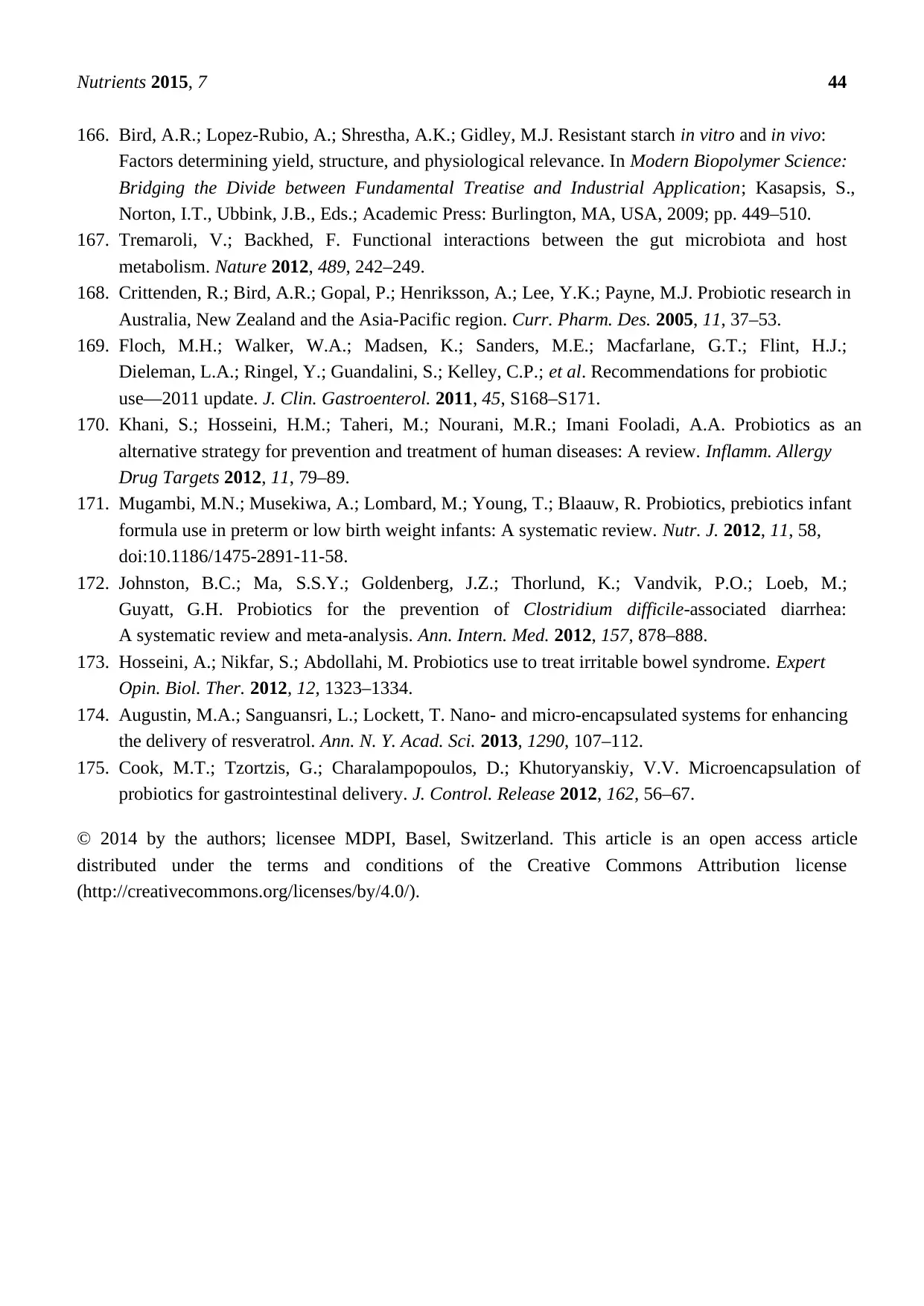
Nutrients 2015, 7 44
166. Bird, A.R.; Lopez-Rubio, A.; Shrestha, A.K.; Gidley, M.J. Resistant starch in vitro and in vivo:
Factors determining yield, structure, and physiological relevance. In Modern Biopolymer Science:
Bridging the Divide between Fundamental Treatise and Industrial Application; Kasapsis, S.,
Norton, I.T., Ubbink, J.B., Eds.; Academic Press: Burlington, MA, USA, 2009; pp. 449–510.
167. Tremaroli, V.; Backhed, F. Functional interactions between the gut microbiota and host
metabolism. Nature 2012, 489, 242–249.
168. Crittenden, R.; Bird, A.R.; Gopal, P.; Henriksson, A.; Lee, Y.K.; Payne, M.J. Probiotic research in
Australia, New Zealand and the Asia-Pacific region. Curr. Pharm. Des. 2005, 11, 37–53.
169. Floch, M.H.; Walker, W.A.; Madsen, K.; Sanders, M.E.; Macfarlane, G.T.; Flint, H.J.;
Dieleman, L.A.; Ringel, Y.; Guandalini, S.; Kelley, C.P.; et al. Recommendations for probiotic
use—2011 update. J. Clin. Gastroenterol. 2011, 45, S168–S171.
170. Khani, S.; Hosseini, H.M.; Taheri, M.; Nourani, M.R.; Imani Fooladi, A.A. Probiotics as an
alternative strategy for prevention and treatment of human diseases: A review. Inflamm. Allergy
Drug Targets 2012, 11, 79–89.
171. Mugambi, M.N.; Musekiwa, A.; Lombard, M.; Young, T.; Blaauw, R. Probiotics, prebiotics infant
formula use in preterm or low birth weight infants: A systematic review. Nutr. J. 2012, 11, 58,
doi:10.1186/1475-2891-11-58.
172. Johnston, B.C.; Ma, S.S.Y.; Goldenberg, J.Z.; Thorlund, K.; Vandvik, P.O.; Loeb, M.;
Guyatt, G.H. Probiotics for the prevention of Clostridium difficile-associated diarrhea:
A systematic review and meta-analysis. Ann. Intern. Med. 2012, 157, 878–888.
173. Hosseini, A.; Nikfar, S.; Abdollahi, M. Probiotics use to treat irritable bowel syndrome. Expert
Opin. Biol. Ther. 2012, 12, 1323–1334.
174. Augustin, M.A.; Sanguansri, L.; Lockett, T. Nano- and micro-encapsulated systems for enhancing
the delivery of resveratrol. Ann. N. Y. Acad. Sci. 2013, 1290, 107–112.
175. Cook, M.T.; Tzortzis, G.; Charalampopoulos, D.; Khutoryanskiy, V.V. Microencapsulation of
probiotics for gastrointestinal delivery. J. Control. Release 2012, 162, 56–67.
© 2014 by the authors; licensee MDPI, Basel, Switzerland. This article is an open access article
distributed under the terms and conditions of the Creative Commons Attribution license
(http://creativecommons.org/licenses/by/4.0/).
166. Bird, A.R.; Lopez-Rubio, A.; Shrestha, A.K.; Gidley, M.J. Resistant starch in vitro and in vivo:
Factors determining yield, structure, and physiological relevance. In Modern Biopolymer Science:
Bridging the Divide between Fundamental Treatise and Industrial Application; Kasapsis, S.,
Norton, I.T., Ubbink, J.B., Eds.; Academic Press: Burlington, MA, USA, 2009; pp. 449–510.
167. Tremaroli, V.; Backhed, F. Functional interactions between the gut microbiota and host
metabolism. Nature 2012, 489, 242–249.
168. Crittenden, R.; Bird, A.R.; Gopal, P.; Henriksson, A.; Lee, Y.K.; Payne, M.J. Probiotic research in
Australia, New Zealand and the Asia-Pacific region. Curr. Pharm. Des. 2005, 11, 37–53.
169. Floch, M.H.; Walker, W.A.; Madsen, K.; Sanders, M.E.; Macfarlane, G.T.; Flint, H.J.;
Dieleman, L.A.; Ringel, Y.; Guandalini, S.; Kelley, C.P.; et al. Recommendations for probiotic
use—2011 update. J. Clin. Gastroenterol. 2011, 45, S168–S171.
170. Khani, S.; Hosseini, H.M.; Taheri, M.; Nourani, M.R.; Imani Fooladi, A.A. Probiotics as an
alternative strategy for prevention and treatment of human diseases: A review. Inflamm. Allergy
Drug Targets 2012, 11, 79–89.
171. Mugambi, M.N.; Musekiwa, A.; Lombard, M.; Young, T.; Blaauw, R. Probiotics, prebiotics infant
formula use in preterm or low birth weight infants: A systematic review. Nutr. J. 2012, 11, 58,
doi:10.1186/1475-2891-11-58.
172. Johnston, B.C.; Ma, S.S.Y.; Goldenberg, J.Z.; Thorlund, K.; Vandvik, P.O.; Loeb, M.;
Guyatt, G.H. Probiotics for the prevention of Clostridium difficile-associated diarrhea:
A systematic review and meta-analysis. Ann. Intern. Med. 2012, 157, 878–888.
173. Hosseini, A.; Nikfar, S.; Abdollahi, M. Probiotics use to treat irritable bowel syndrome. Expert
Opin. Biol. Ther. 2012, 12, 1323–1334.
174. Augustin, M.A.; Sanguansri, L.; Lockett, T. Nano- and micro-encapsulated systems for enhancing
the delivery of resveratrol. Ann. N. Y. Acad. Sci. 2013, 1290, 107–112.
175. Cook, M.T.; Tzortzis, G.; Charalampopoulos, D.; Khutoryanskiy, V.V. Microencapsulation of
probiotics for gastrointestinal delivery. J. Control. Release 2012, 162, 56–67.
© 2014 by the authors; licensee MDPI, Basel, Switzerland. This article is an open access article
distributed under the terms and conditions of the Creative Commons Attribution license
(http://creativecommons.org/licenses/by/4.0/).
1 out of 28
Related Documents
Your All-in-One AI-Powered Toolkit for Academic Success.
+13062052269
info@desklib.com
Available 24*7 on WhatsApp / Email
![[object Object]](/_next/static/media/star-bottom.7253800d.svg)
Unlock your academic potential
© 2024 | Zucol Services PVT LTD | All rights reserved.




